Pushback from poultry farmers –
The demand for a mandatory code
Value-adding, Viking style –
Old techniques, new recipes

Premium lamb meat –
The ‘Wagyu of lamb’ is taking off
From convict to cultivator –James Ruse, Australia’s first farmer

Putting
MAY-JUNE 2024 / $9.95
The poultry games
track
a precious industry back on


Information was current at time of publishing and is subject to change. Applicants must have a valid ABN, GST registered for at least 2 years and a business turnover greater than $125,000 per year. All applications are subject to credit approval criteria. Terms and conditions, fees and charges apply. The information is general in nature and does not constitute financial or tax advice, and does not take into account specific financial circumstances, situations or needs. Independent financial and tax advice should be sought. Fees and charges can include vehicle finance, stamp duty, on road costs, fuel management, replacement tyres, scheduled servicing and maintenance, re-registration over the period of the lease, 24-hour roadside assistance, accident management services, toll and infringement management. ^Mitsubishi Motors Business Advantage operating leases are provided by Fleet Partners Pty Ltd trading as Mitsubishi Motors Business Advantage - FP (ABN 63 006 706 832). Fleet Partners is not related to Mitsubishi Motors Australia Limited. *Lease terms are subject to a maximum limit of 200,000 kilometres over the period of the lease. #Level of outsourcing will depend on optional extras chosen which will vary lease fees. Fleet administration included at no additional cost for the term of the lease; registration and CTP renewals, maintenance & repair approval and payment, replacement tyres (as quoted), roadside assistance, accident management and infringement management. Fleet administration at an additional cost over and above the monthly lease rate is; fuel costs, fuel card management, toll costs, toll management and replacement tyres (above quoted limit). Get a Business Advantage^ with a fully maintained operating lease. ■ One monthly invoice ■ No cash payment upfront ■ Flexible lease terms from 24 to 60 months* ■ Outsource some or all of your fleet administration* Discover a tailored solution today. Visit your local Mitsubishi Dealer or call 1300 020 272.

THE MUSTER
NEWS AND EVENTS
Renewables at the Toowoomba ag conference; Grassroots initiative to overcome alcohol abuse in the country; Tick fever alert for northern NSW; Researchers around the state are using science and technology to improve food security 8
THE BIG ISSUE
FLOCKING TO A MANDATORY CODE
Poultry farmers face zero processor competition and zero bargaining power, but the push for fairer market conditions is gaining momentum 18
THE BIG PICTURE
EUROPE’S PERFECT STORM
European farmers are up in arms over a perfect storm of rising costs, cheap imports and radical sustainability 24
BUSINESS
VALUE-ADDING WITH A VIKING FLAVOUR Siggi and Gustaf Ragnarsson from Coffs Harbour draw on their Viking heritage in their approach to meat processing 32

Image: A thriving field of rice. Read our story on rice blast on page 52.
TRADE
TAKING THE HIGH ROAD
One man’s vision for creating the finest premium lamb meat is transforming Australia’s sheep meat farming industry 36
ENVIRONMENT
USING URINE IN DINGO MANAGEMENT
According to new research, a study of dingo urine could support future species management strategies 40
RUMINATING ON THE FUTURE
A farmer-led online carbon emissions calculator is empowering producers to track and validate on-farm climate action 44
BIOSECURITY
POUNCING ON THE PIG PROBLEM
The state government’s boost for a feral pig control program has removed almost 50,000 pigs from the landscape since 2023 48
DESTRUCTIVE FUNGAL DISEASE
A destructive fungal disease that can decimate rice crops has surfaced in NSW, posing a grave concern to the industry 52
CURRENT AFFAIR: ELECTRIC VEHICLES IN THE BUSH
With the push for an uptake of electric vehicles, rural communities grapple with the practicalities of making the switch 56
HISTORY
FROM CONVICT TO CULTIVATOR
James Ruse was a convict turned agricultural trailblazer, who laid the foundation for farming in early colonial Australia
60 SPECIAL REPORT: MARRYING AG AND TOURISM
Adding holiday accommodation to your farm has become simpler with the easing of NSW planning regulations 66
COMMUNITY
NEW GENERATIONS
From growing up on a sheep station near Broken Hill to becoming a climate activist, Anika Molesworth’s book Our Sunburnt Country tells all
MEET A MEMBER
Charlie Azzopardi is a broiler chicken farmer from Wimborne, and he’s been a proud NSW Farmers member for 20 years
THE SALEYARDS
Wonderful winter warmers to combat the cooler weather
THE TAIL END
72
76
77
The amazing on-farm discovery of an ancient lizard-like species that lived in Australia 247 million years ago 86
JOIN US – SUBSCRIBE
Sign up to become a NSW Farmers member, and receive The Farmer magazine
79
Contents
3 MAY-JUNE 2024 THE FARMER

PUBLISHER James Wells
EDITOR Michelle Hespe
ART DIRECTOR Ryan Vizcarra
EDITORIAL AND SALES ENQUIRIES
NSW Farmers Email: emailus@nswfarmers.org.au
SALES DIRECTOR
NSW Farmers Email: emailus@nswfarmers.org.au
Phone: (02) 9478 1000 –
Michael Burt
Libby-Jane Charleston
Eliza Fessey
Sandra Godwin
Susan Gough
Ian Neubauer
Matilda Meikle
Emily Riches






From the editor
Welcome to another issue of The Farmer. Alongside some of the big issues that farmers are currently facing – from cattle ticks and rice blast, to feral pigs and weather anomalies, we also aim to cover niche areas of farming where scientists, researchers and farmers are pushing the boundaries of not just what they know and are accustomed to doing, but also challenging what we collectively believe as an industry� As always, innovation is the name of the game in an ever-changing world where technology is moving forward at breakneck speed, giving us access to more and more ways of gathering and assessing impactful data
In one story, we delve into how researchers around the state are using science and technology to improve food security, not just for Australia but for the entire world� Read up on this from page 14 We also cover one man’s vision for creating the finest premium lamb meat, and how he is transforming Australia’s sheep meat farming industry Not only has his company been a leading driver of productivity gains in the Australian lamb industry over the past two decades, but he has also has forged a path for farmers to be rewarded with significant premiums for producing wagyu-quality, highly marbled lamb Read up from page 36
When it comes to managing wild dingoes, researchers have made a facinating discovery when it comes to the power of dingo urine � The application of the newfound knowledge could lead to dingoes being deterred from campsites and livestock paddocks, using their own urine This
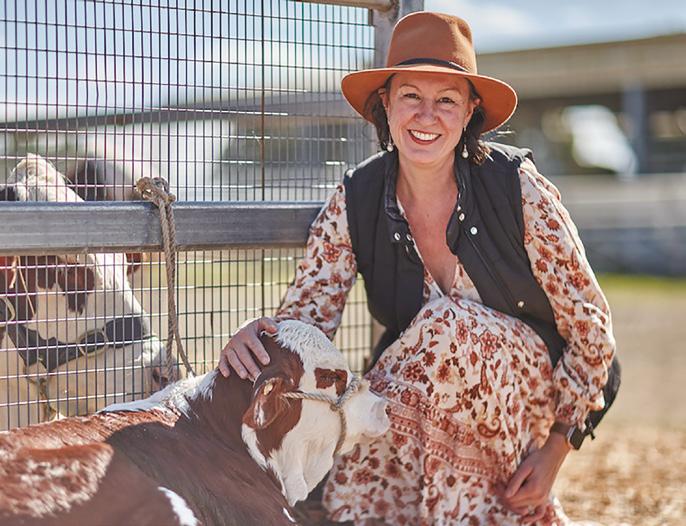
would reduce the need for widespread removal and help to preserve Australian ecosystems Read this story from page 40
Meanwhile in the carbon space – page 44 – Australian farmers pioneer a farmerled online carbon emissions calculator, empowering producers to track and validate on-farm climate action throughout the supply chain It can simplify something which at first can seem completely daunting
And who doesn’t love a bit of history in their reading? We explore the remarkable tale of James Ruse – a former convict turned agricultural trailblazer, whose perseverance and innovation laid the foundation for farming in early colonial Australia � Learn all about his life from page 60
I hope you enjoy the read
 MICHELLE HESPE Editor
MICHELLE HESPE Editor
The Intermedia Group takes its corporate and social responsibilities seriously and is committed to reducing its impact on the environment. We continuously strive to improve our environmental performance and to initiate additional CSR based projects and activities.
As part of our company policy we ensure that the products and services used in the manufacture of this magazine are sourced from environmentally responsible suppliers.
This magazine has been printed on paper produced from sustainably sourced wood and pulp fibre and is accredited under PEFC chain of custody.
PEFC certified wood and paper products come from environmentally appropriate, socially beneficial and economically viable management of forests.
The wrapping used in the delivery process of this magazine is 100% recyclable.

Publisher, its agents, company officers or employees. Any use of the information contained in this publication is at the sole risk of the person using that information. The user should make independent enquiries as to the accuracy of the information before relying on that information. All express or implied terms, conditions, warranties, statements, assurances and representations in relation to the Publisher, its publications and its services are expressly excluded. To the extent permitted by law, the Publisher will not be liable for any damages including special, exemplary, punitive or consequential damages (including but not limited to economic loss or loss of profit or revenue or loss of opportunity) or indirect loss or damage of any kind arising in contract, tort or otherwise, even if advised of the possibility of such loss of profits or damages. While we use our best endeavours to ensure accuracy of the materials we create, to the extent permitted by law, the Publisher excludes all liability for loss resulting from any inaccuracies or false or misleading statements that may appear in this publication. Copyright © 2024 – The Intermedia Group Pty Ltd
THE MAGAZINE
–
–ADVERTISING
CONTRIBUTORS
Henly
Johnson
OF COMMUNICATIONS & ENGAGEMENT
HEAD OF POLICY
US
–
SERVICE CENTRE For membership, magazine subscriptions and mailing list enquiries: 1300 794 000 @NSWFarmers THE INTERMEDIA GROUP MANAGING DIRECTOR Simon Grover GM OF OPERATIONS Chris Baker FINANCE MANAGER Mina Vranistas PRODUCTION MANAGER Jacqui Cooper HEAD OF DIGITAL Jordan Guiao The Farmer magazine is published for the NSW Farmers Association (ABN: 31 000 004 651) by The Intermedia Group (ABN: 94 002 583 682) 41 Bridge Rd, Glebe NSW 2037. All rights reserved. Printed by IVE Group. Getty Images were used throughout the magazine. $9.95 Value-adding, Viking style –Old techniques, new recipes Pushback from poultry farmers –mandatory code Premium –The ‘Wagyu of lamb’ is taking off From convict to –James Ruse, Australia’s first farmer The poultry games Putting precious industry back on track Photo by: Scott Stramyk. DISCLAIMER: This publication is published by The Intermedia Group Pty Ltd (the “Publisher”). Materials in this publication have been created by a variety of different entities and, to the extent permitted by law, the Publisher accepts no liability for materials created by others. All materials should be considered protected by New Zealand and international intellectual property laws. Unless you are authorised by law or the copyright owner to do so, you may not copy any of the materials. The mention of a product or service, person or company in this publication does not indicate the Publisher’s endorsement. The views expressed in this publication do not necessarily represent the opinion of the
Sue Wallace NSW FARMERS CEO Annabel
HEAD
Stephen Mudd
& ADVOCACY Kathy Rankin CONTACT
Level 4, 154 Pacific Highway, St Leonards, NSW 2065 PO Box 459, St Leonards, NSW 1590 Head Office: 02 9478 1000
MEMBER
4 THE FARMER MAY-JUNE 2024

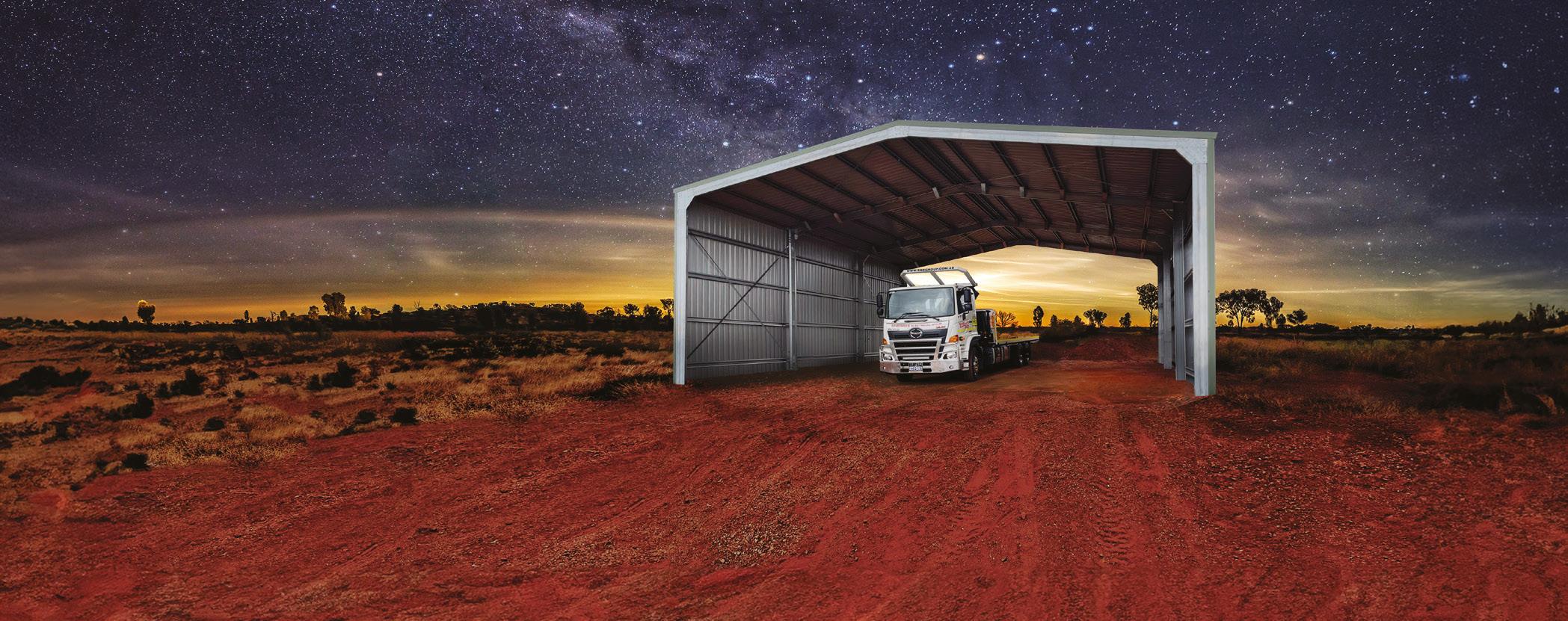


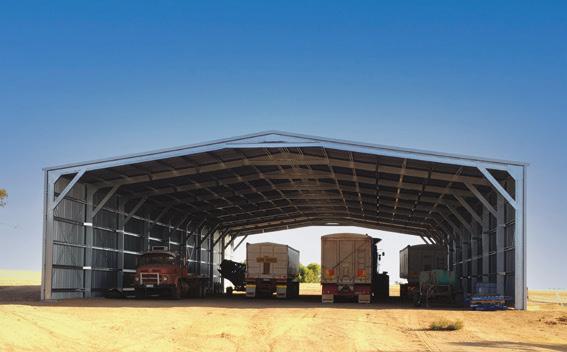




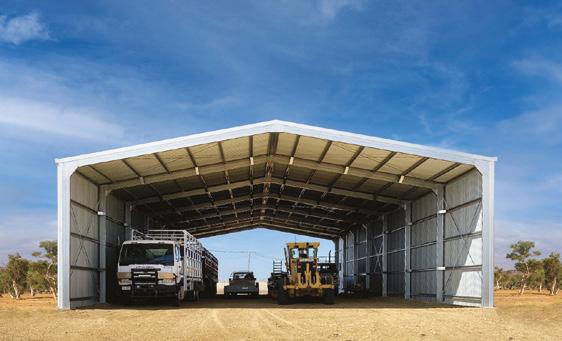



Images are from the Now Buildings range, for illustration purposes only. Imperial measurements are approximate. Prices are based on collection, delivery extra. WA, NT & TAS slightly extra. Extras pricing in bold is applicable at the shed purchase stage only. Extensions for existing sheds POA. Now Buildings will not be responsible to honour these prices once the total allocation has been sold. E&OE. Prices are Region A, Terrain cat. 2. Reg B slightly extra. *Now Buildings is not responsible for any changes made to tax legislation after the print deadline. Annual turnover limits may apply for the $20,000 instant tax write-off. You should consult your own tax advisors before entering any transaction. MANUFACTURING LOCATIONS: DUBBO, CARDIFF, TAMWORTH, COFFS HARBOUR, QUEANBEYAN & ALBURY $20,000+GST INSTANT TAX WRITE-OFF SAVE TAX * 100% TAX WRITE-OFF ON HAY & FODDER SHEDS OF ANY PRICE 100% Australian steel, 100% Australian made, 100% Australian family owned High tensile bolts & class 4 fasteners, gutters & downpipes included Site specific engineering, heavy duty connection & footing design High grade industrial strength materials and design THE NOW BUILDINGS ADVANTAGE CALL ON 02 5944 3404 WEB: www.nowbuildings.com.au REILLY 0459 259 920 JAMES 0413 104 820 JOHN 0437 699 111 OUR BIGGEST SALE IS ON LIMITED NUMBERS & MASSIVE SAVINGS! DON’T MISS OUT ON THIS SALE! ABN HOLDERS ONLY 13M x 13.5M x 5.1M | $20,980 INC GST CALL FOR MORE INFO FINANCE NOW AVAILABLE ���� FOR APPROVED APPLICANTS MOST OF OUR SHED RANGE IS NOW AVAILABLE AT HEIGHTS UP TO 8 METRES! 15M x 36M x 5.1M (50’ x 120’ x 17’) Massive open front shed with four 9M bays. Ideal for a range of farm storage needs. Building in Zincalume. BIG OPENINGS PLUS $62,950 INC GST ONLY 20M x 40.5M x 5.4M (66’ x 135’ x 17’7”) Outstanding access at both ends. The drive-thru convenience of this shed makes it excellent for large machinery or storage. ENORMOUS ACCESS $83,960 INC GST ONLY 18M x 42M x 5.6M (60’ x 138’ x 18’5”) Massive fully enclosed shed for all farm storage needs. Includes five large roller doors and one PA door. Building in Zincalume. MASSIVE STORAGE $108,850 INC GST ONLY 15M x 31.5M x 5.1M (50’ x 105’ x 17’) Lots of storage space with easy access. Add an extra bay for $6,410. LARGE OPEN ENDED $47,810 INC GST ONLY 18M x 18M x 5.1M (60’ x 60’ x 17’) Great farm shed with easy access from both ends. Building in Zincalume. AUSSIE SHELTER $35,350 INC GST ONLY 9M x 18M x 4.2M (30’ x 60’ x 13’8”) Enclosed one bay and open three. Large industrial roller door with one PA door in Zinc. FARMERS MATE $29,430 INC GST ONLY 10M x 13.5M x 5.1M (33’ x 45’ x 17’) Open both 10M ends, perfect for hay, machinery or workshop. Add an extra bay for $5,160. HAY MATE $17,910 INC GST ONLY 9M x 15M x 4.5M (30’ x 50’ x 15’) Open front shed in large 5M bays for better storage. Skylights extra. TOUGH TRIPLE $19,060 INC GST ONLY 13M x 18M x 5M (43’ x 60’ x 16’8”) The strength and ruggedness of a full industrial building with large roller door and PA door. Building in Zinc. VALUE INDUSTRIAL $37,590 INC GST ONLY 12M x 16M x 4.5M (40’ x 53’ x 15’) Two spacious 8M open front bays. Perfect for rural storage. Building in Zincalume. RURAL DOUBLE $29,500 INC GST ONLY 13M x 22.5M x 5.1M (43’ x 75’ x 17’) Open front farm industrial building. Perfect for everyday storage. Add an extra bay for $5,520. EVERYDAY FARMER $36,720 INC GST ONLY
The Muster
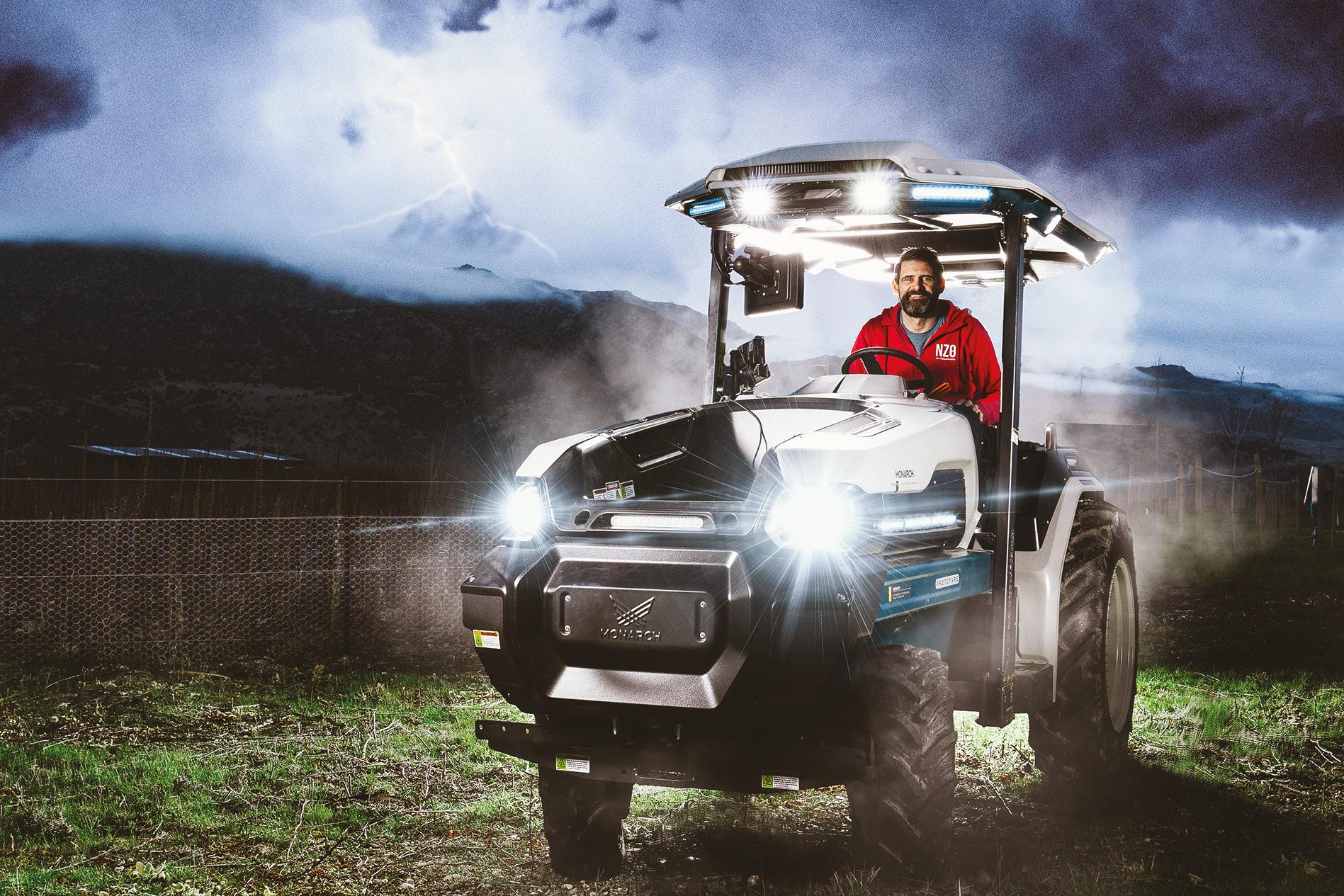
Electrifying renewables in ag conference
At the National Renewable in Agriculture Conference in Toowoomba on July 4, New Zealand farmer Mike Casey will talk through his journey developing a fossil-free, electric cherry orchard�
Mike uses solar and battery power to run electric frost fighting fans imported from South Africa, and to power the farm’s irrigation system His cherry farm is also one of the first farms in the Southern Hemisphere to use a Monarch Electric Tractor, and Mike will be sharing his story of how an electric tractor has performed on his farm�
Mike believes there is nothing stopping growers from going fully electric as they upgrade technology�

“Rather than being someone telling farmers what to do, we are showing them that we did it and what the numbers are,” Mike said�
Conference attendees will hear from an organic olive grower using solar to power a farm, how biogas is meeting the demand of a piggery in Queensland, how Power Purchase Agreements can create off-farm income and what needs to be considered when combining farming under solar panels for large scale developments�
More conference information and tickets available at renewablesinagconference.com.au
SpraySMART is a Registered Training Organisation (RTO – 40867) and leader of Face to Face, Online, Zoom ( Live) , Zoom (pre-recorded) and In-House Chemical Accreditation Training throughout Australia. SpraySMART works with all Industry Sectors to provide training and Industry accreditation for users of Agricultural and Veterinary Chemicals (AgVet)
l NEWS
SpraySMART is Nationally recognized and provides Training in the following units of competency: 1. AHCCHM307 Prepare and apply chemicals to control pest, weeds and diseases 2. AHCCHM304 Transpost and store chemicals
Image: New Zealand farmer Mike Casey embraces electric energy on his farm.
1800 872 462 | training@spraysmart.com.au | www.spraysmart.com.au 10% Discount to NSWMembersFarmer 6 THE FARMER MAY-JUNE 2024
Competition reform on the way
Hefty fines for supermarket misbehaviour could soon be on the cards, according to former Competition Minister Craig Emerson who recommended the Food and Grocery Code be made mandatory with potentially huge fines for its breach
NSW Farmers Vice President Rebecca Reardon, who gave evidence to a Senate inquiry into the supermarkets in March, said Emerson’s review into the code could finally set the wheels in motion to address market power misuse by supermarket giants.
“For years, grocery giants have had near unfettered ability to use their market power against suppliers, with a lack of accountability or penalties for any
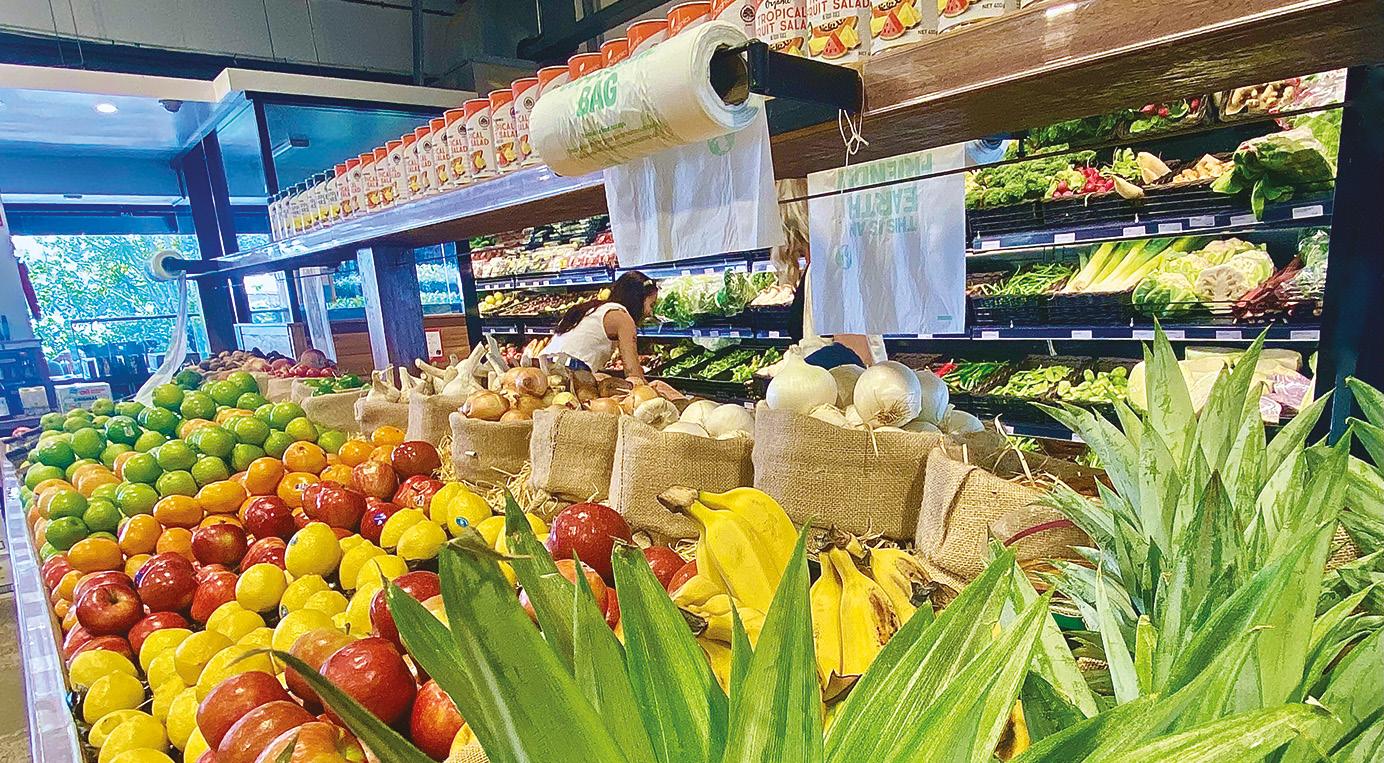
unconscionable behaviour impacting the supply chain,” Mrs Reardon said�
“Having a mandatory Code of Conduct for our supermarkets and their suppliers with enforceable, meaningful penalties for its breach could make the world of difference when it comes to cracking down on the harmful practices of these super powers
“Anti-competitive activity needs to be stopped in its tracks, and it’s nice to hear the Federal Government step up and admit the current Code is not good enough�”
However, Emerson’s failure to back divestiture powers as one of the tools to address harmful behaviour by supermarkets was disappointing, Mrs Reardon said

Join us at a community event near you and meet with our Principal and Director of Boarding. Canberra — Thursday, 23 May Young — Friday, 24 May Griffith — Saturday, 25 May Register at loretonh.nsw.edu.au/events
l REFORMS
Supermarkets are being held accountable for misbehaviour.
The Muster
l HEALTH AND WELLBEING
It’s okay to say no
Sober in the Country (SITC) is a grassroots not-for-profit pioneering radical change and social impact across rural Australia by shifting the narrative around booze in the bush.
Words SUE WALLACE
During her younger years in corporate agriculture, Shanna Whan, founder, CEO and advocate of Sober in the Country, says she had a “bit of a reputation for being wild”
She recalls that she was always the one most likely to get into strife or push the boundaries
“I was the loud one, the last one up at sunrise during agricultural work drinks or conferences – the bad influence,” she says�
Shanna describes herself as a child of resilience, often reflecting on her family heritage and the parallels she shared with her beloved late father, Bucky Rowlands
“He was a widely recognised leader in Australian agriculture after rebuilding his own life from ground zero,” she says “He left war-torn Zimbabwe to start over in Australia in the early 1970s with $200, a young family, and no idea what was coming next�”
THE TIDES OF CHANGE
Shanna certainly never imagined that 20 years down the track, she’d almost lose her life to alcohol addiction and subsequently recover, against all the odds
She was named Australian of the Year – Local Hero 2022 and was chosen as one of 10 Aussies to represent rural Australia on the international stage for Queen Elizabeth II’s funeral� More recently, Shanna was invited to be one of the key voices at a National Farmers Federation forum on mental health
“I have spent time recently reflecting on how sincerely thankful I was to be included in that forum because to me it’s clear that if we ever want to be taken seriously as a nation that’s leading the way in sustainable agriculture, we must first recognise the importance of focusing on sustainable people in agriculture,” she says�
“Honestly, we aren’t doing a terrific job, because we all still struggle to look one of our biggest physical and mental health challenges in the eye – and that’s the harm alcohol causes ”
Shanna says that’s why she does what she does, and why she has spent a decade formulating a language and discussion that resonates with what she describes as the hardest-to-reach audience of all�
“I’ve now travelled Australia upon invitation for the better part of a decade to speak about the work of Sober in the Country and our widely recognised userfriendly message that it’s #OK2SAYNO (to booze),” she says
“Each and every audience gets asked the same question: is there anybody here who has never been impacted directly or indirectly by alcohol harm? Only two hands have ever gone up
“I get it It’s hard and uncomfortable at first, and I can tell you for a fact that you don’t just stroll into a crowd of tough rural farming people and raise the issue of alcohol use or, indeed, addiction without some very, very carefully laid plans, a tonne of humour, and a crystal-clear message that you’re not there to judge or preach�”
Shanna says SITC is taking the focus off the problem and instead focusing on the solution of simply being better mates and ensuring everyone collectively supports those choosing less alcohol, or none at all
“Neither myself as a person, nor SITC as a charity, approach anything with an evangelical or prohibitionist lens,” she says�
“It doesn’t work, and it never will� I know that better than anyone But when we start an upbeat, >


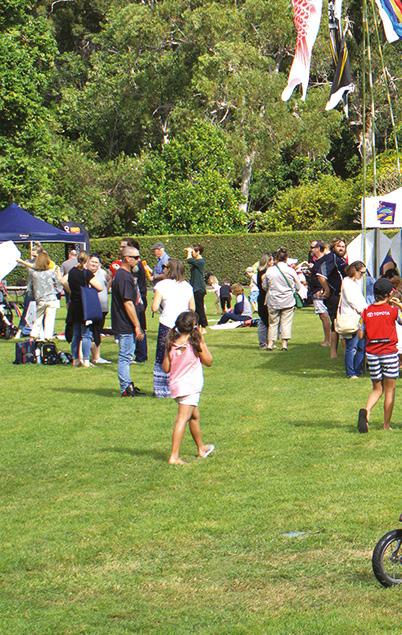
READ IT ONLINE THE FARMER MAY-JUNE 2024 8


#OK2SAYNO
From far left: Shanna Whan, CEO of Sober in the Country, has lived through alcohol addiction and takes the message that it’s #OK2SAYNO to rural communities around the country; STIC wants to change the conversation around alcohol; A familyfriendly community event in Coffs Harbour.
MAY-JUNE 2024 THE FARMER 9
The Muster
What is Sober in the Country?
Sober in the Country is a grassroots not-for-profit pioneering radical change and social impact across rural Australia by shifting the narrative around booze in the bush. Far from being prohibitionist, the charity is all about social inclusion.
Sober in the Country uses a trademark mix of straight “bush talk”, powerful lived-experience advocacy, and their nationally recognised #OK2SAYNO (to booze) mental health movement.
For more information, visit soberinthecountry.org
user-friendly chat about a hard topic, half the battle is done, and then we can get to work behind the scenes supporting those who suddenly feel less ashamed to acknowledge they’re not doing so great ”
SHIFTING THE NARRATIVE
Shanna says many of the big-ticket items, including mental health, suicide, depression and even OH&S, are linked to alcohol�
“This is why at the NFF mental health forum, my message to the other leaders in the mental health arena was to ask others to stop turning a blind eye to the elephant in the room and to get in the trenches with us and help out,” she says
“I put out the same call I’ve been putting out for years now – to ask that other organisations and individuals take the focus for our community events, sports and race days, fundraisers and workshops, off alcohol, and put it back on the community.”
Shanna says that when organisers ensure a range of tasty, healthy and thoughtful alternatives are on offer, rather than assuming everyone wants to drink, is a really great conversation to develop
She adds that non-drinkers, and even those who love a social drink or two, are desperate to see something other than a bottle of water, a token can of sugary soft drink or a lukewarm urn in the corner of a room
“When the entire community, not just the drinkers, are truly included, lives are impacted and changed,” she says
Shanna has heard many firsthand stories from isolated men in particular, who are battling complex mental health scenarios, and who feel excluded because anything and everything to do with social interactions in a rural or farming community is so often focused on alcohol that they simply can’t take part
“These are vulnerable people who absolutely have to stay alcohol-free to stay afloat,” she says�
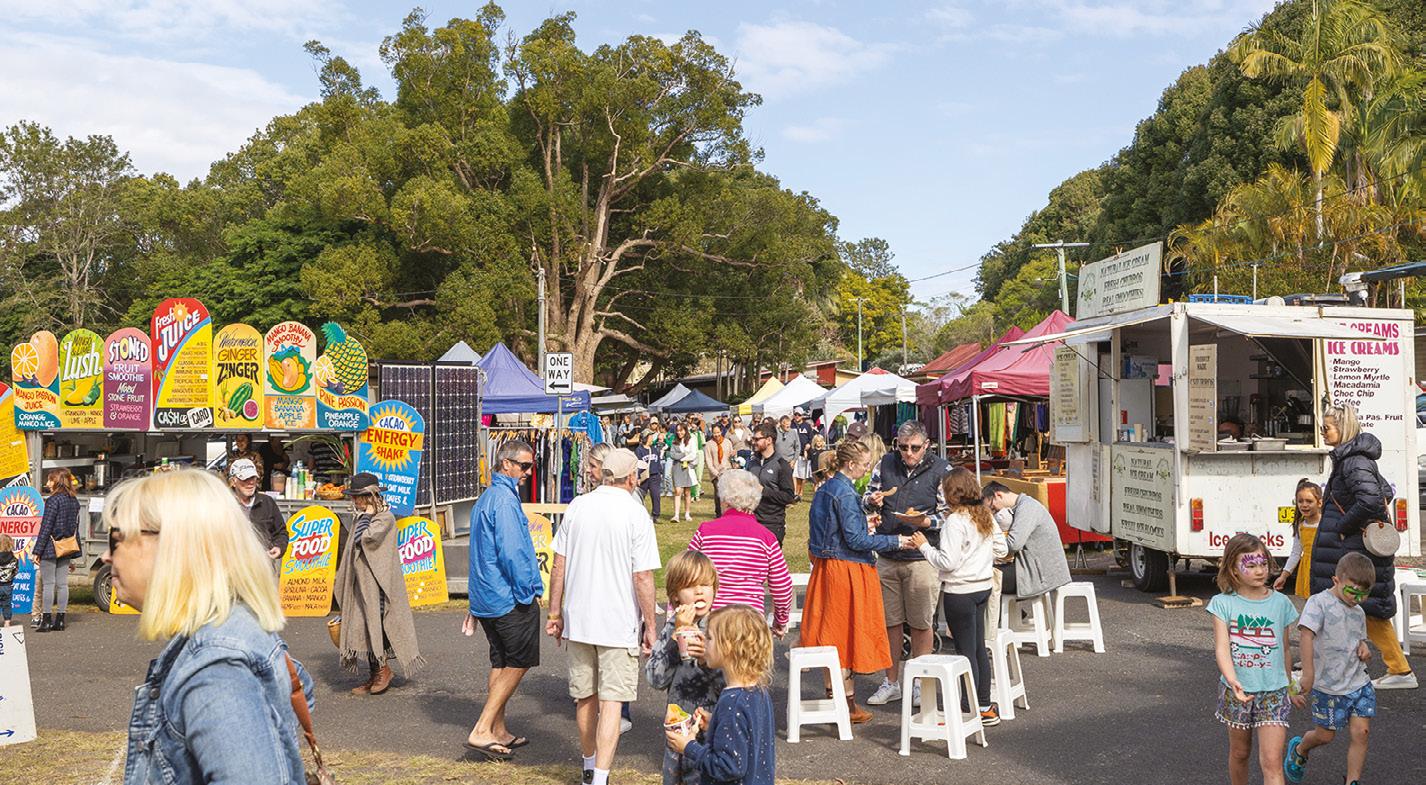
But the good news, according to Shanna, is that change is happening�
She has seen this change at many of the ag and farming communities she’s travelled to
“The pubs and clubs now have at least one zero-alcohol beer on tap, or the footy club is now including ticket prices for drinkers and those opting out,” she says
“They’re receiving incredibly positive feedback from non-drinkers and drinkers alike who simply love seeing and having a choice�”
When asked about being the ‘wild one’ all those years ago, Shanna says she realises she was never actually wild – she was wounded, and used alcohol as a form of self-medication and a smoke screen to hide behind�
“The more I speak candidly about that experience, the more rural Australians are opening up to share that they, too, were never really drinking for fun as much as they were drinking to ease pain or deal with loneliness, suffering, or fatigue,” she says
Sober in the Country operates via advocacy and awareness and also has an online peer support network called the Bush Tribe, where more than 2000 rural and remote Australians have found help, a home, and a safe place to work towards better health
Shanna says the lives being saved and changed daily through that simple, supportive connection is mind-blowing “It is the greatest thing I have ever been privileged to be a part of�” l

 CHEERS TO CHANGE
CHEERS TO CHANGE
THE FARMER MAY-JUNE 2024 10
Above, left to right: The Bangalow Markets is a fantastic alcohol-free community event; Shanna says that she’s seen many more communities embracing this change, with positive outcomes for all.





In connection with NobleOak’s involvement with your Association’s member benefits programme. NobleOak Life Limited and its related entities pay a marketing fee to your association. Part of the fee is an ongoing amount equivalent to a percentage of premium on cover purchased by NSW Farmers’ members under the program. This is not an additional charge to you.
*Important Information - NSW Farmers are entitled to a 10% lifetime discount on NobleOak’s standard Premium Life Direct premium rates for its term life cover (10% discount applies to term life cover only). In addition to term Life Insurance cover, NobleOak also offers Trauma Insurance. Our website contains details.
**Two (or more) covers – 2 months free. One month free also available. This offer is available if you apply for cover before 28 June 2024. If you apply for and are issued with two or more covers, you will not start paying premiums for each cover respectively, until two months after the commencement date of the relevant covers. If you apply for and are issued with one cover type, you will not start paying premiums until one month after the commencement of the cover. If you apply for two or more cover types before 28 June 2024 and are issued with only one type of cover, or if you apply for and take out two or more covers but cancel any cover(s) within the first month so that only one cover remains current, you will not start paying premiums on the remaining cover until one month after the commencement date of that cover.
The offer(s) are available for new customers only and can be used only once. Not able to be used in conjunction with another ad vertised offer.
Legal statements. Premium Life Direct is issued by NobleOak Life
708
No. 247302.
Street,
NSW 2000.
490.
and conditions set out in the Premium Life Direct Product Disclosure Statement (PDS). Please also read NobleOak’s Target Market Determination (TMD) at www.nobleoak.com.au/target-market-determination. This information is of a general nature only and does not take into consideration your individual circumstances, objectives, financial situation or need s. Before you purchase an Insurance product, you should carefully consider the PDS to decide if it is right for you. The PDS is available by calling NobleOak on 1300 108 490 or from w ww.nobleoak.com.au. Clients should not cancel any existing Life Insurance policy until they have been informed in writing that their replacement cover is in place. NobleOak cannot provide you with personal advice, but our staff may provide general information about NobleOak Life Insurance. By supplying your contact details, you are consenting to be contacted by NobleOak, i n accordance with NobleOak’s Privacy Policy. Get two months free when you take out two or more life insurance covers** NSW Farmers get 10% lifetime discount on Life cover* Get a quote in less than 2 minutes: www.nobleoak.com.au/nswfarmers Or call NobleOak on 1300 108 490 and mention ‘NSW FARMERS’.
Limited ABN 85 087 648
AFSL
Address: 44 Market
Sydney
Phone: 1300 108
Email: sales@nobleoak.com.au. Cover is available to Australian residents and is subject to acceptance of the application and the terms
The Muster
l BIOSECURITY
Tick fever alert
NSW Department of Primary Industries and Local Land Services urge vigilance as tick fever cases are confirmed, stressing the importance of immediate veterinary attention and strict biosecurity measures to prevent further spread.
Words LIBBY-JANE CHARLESTON
The NSW Department of Primary Industries (DPI) and Local Land Services (LLS) are urging farmers to stay vigilant after tick fever cases were found on cattle farms in northern NSW�
Laboratory analysis at the Elizabeth Macarthur Agricultural Institute, conducted by NSW DPI, verified two instances of tick fever, or Babesia bovis, based on samples provided by LLS district veterinarians
Cattle tick and tick fever are conditions which pose a devastating economic impact on cattle production due to the potential large losses of animals, production losses, restrictions on trade, and treatment costs�
According to NSW DPI, tick fever in cattle can cause fever, weight loss, abortion and bull infertility Animals could show nervous signs, including change in temperament, lethargy, muscle tremors and difficulty walking
North Coast LLS district vet Phillip Carter recommended that farmers contact a vet at once if cattle showed signs of tick fever�
“If treatment is delayed tick fever can kill susceptible animals,” Dr Carter said
“These are the first new confirmed cases of tick fever in NSW this year and we saw cattle tick infestations and cattle deaths during our inspection of the animals
“Continued monitoring of the herd for more cases is important as animals may be infected, but not yet show signs� Unexplained deaths are often the first signs that tick fever is present�
“Producers should look out for lethargy, depression, red urine, elevated temperature, jaundice and anaemia in their cattle ”
Dr Carter said tick fever was spread only by cattle tick, and with favourable seasonal conditions for ticks that thrive in warm, humid conditions, he urged producers to practice good farm biosecurity to prevent more cases�
“Producers should check cattle regularly and be on the lookout for ticks, especially with cattle being yarded in preparation for autumn sales,” Dr Carter said
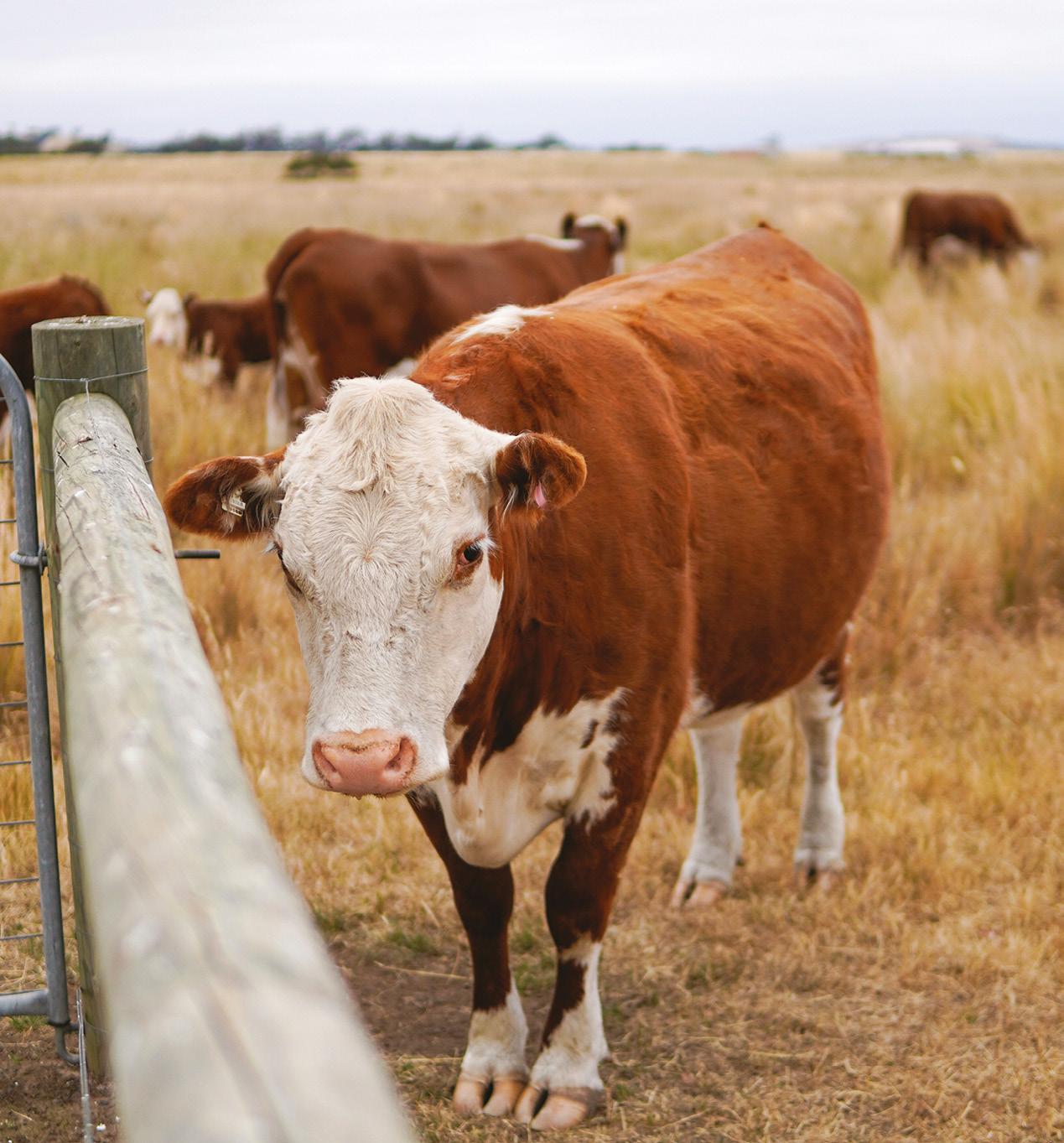

“I feel there’s a lack of official communication regarding discoveries of the tick. I’ve heard via word of mouth that they’re finding multiple properties with cattle tick, but people are feeling it’s not being properly communicated. So, if you hear that a neighbour has found ticks, it’s time for you to do an inspection and treatment.”
–RON CHITTICK Executive Councillor, Region 13
READ IT ONLINE THE FARMER MAY-JUNE 2024 12
Ron Chittick, Executive Councillor for Region 13, said his neighbours recently found cattle tick at the saleyards�
“My neighbour and myself have agreed to do a voluntary tick treatment but it’s quite concerning there hasn’t been much communication about the recent discovery – most people don’t really check cattle for ticks because they haven’t been around for a long time, so people have become quite lax,” Mr Chittick said�
“The treatment is simple; the first treatment involves a needle, which is then followed up with a pour-on treatment But unless your cattle have had ticks, then I don’t believe people make it a priority to really inspect their cattle for ticks
“I feel there’s a lack of official communication regarding discoveries of the tick I’ve heard via word of mouth that they’re finding multiple properties with cattle tick, but people are feeling it’s not being properly communicated� So, if you hear that a neighbour has found ticks, it’s time for you to do an inspection and treatment,” Mr Chittick said
NSW DPI Cattle Tick Operations leader Larry Falls said early intervention was key to minimising the spread and impact of cattle tick and tick fever
“The record of movement for cattle tick lists the mandatory biosecurity requirements which must be followed when bringing cattle from cattle tickinfested areas into NSW,” Mr Falls said�
“Following these biosecurity requirements helps prevent the introduction and spread of cattle ticks and minimises costs and losses to your enterprise and livestock industries ”
Tick fever and cattle tick were notifiable under NSW biosecurity legislation l
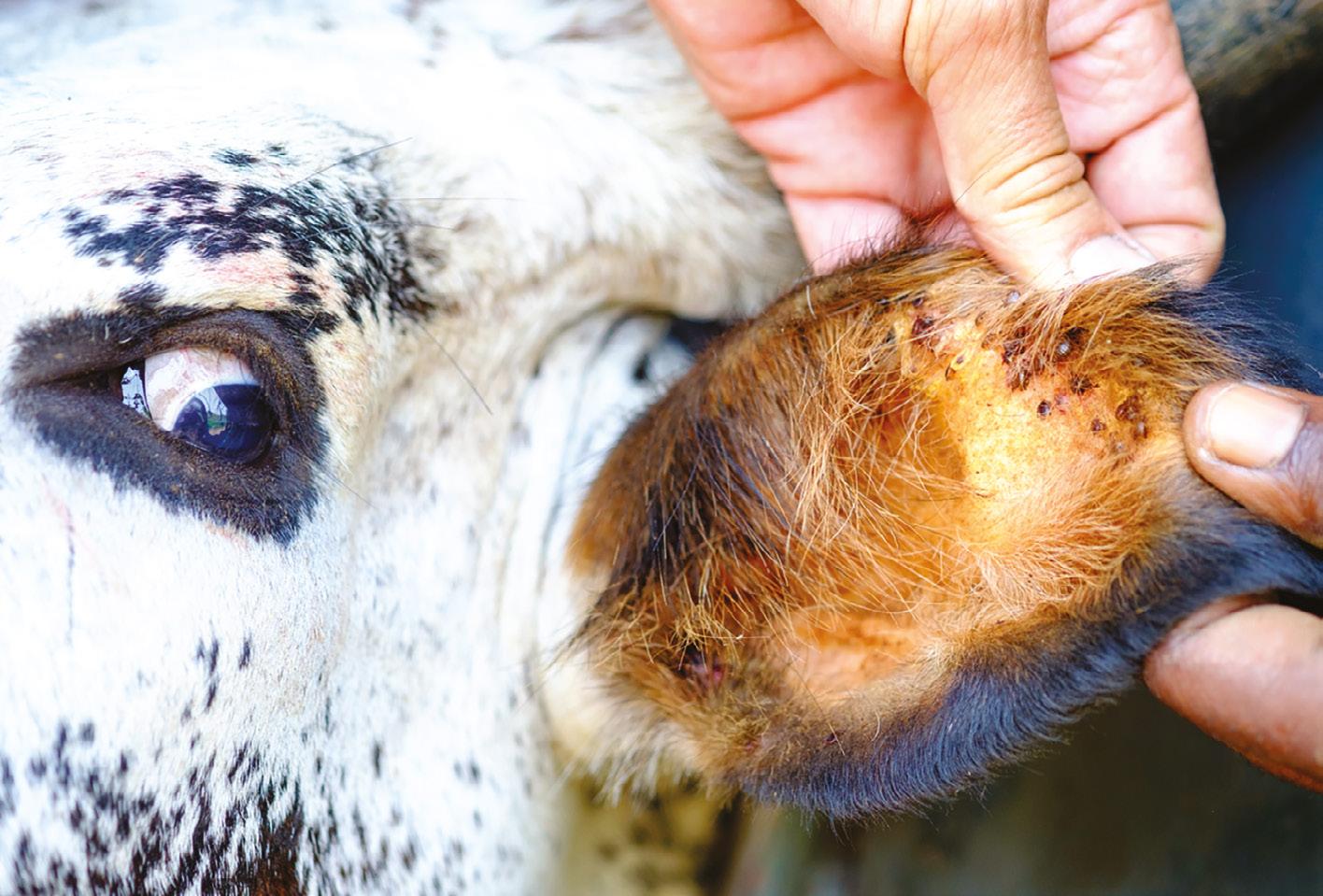
About Tick Fever
STAY VIGILANT
Above and below: North Coast LLS district vet Phillip Carter says to continually monitor your herd and look out for “lethargy, depression, red urine, elevated temperature, jaundice and anaemia in cattle.”
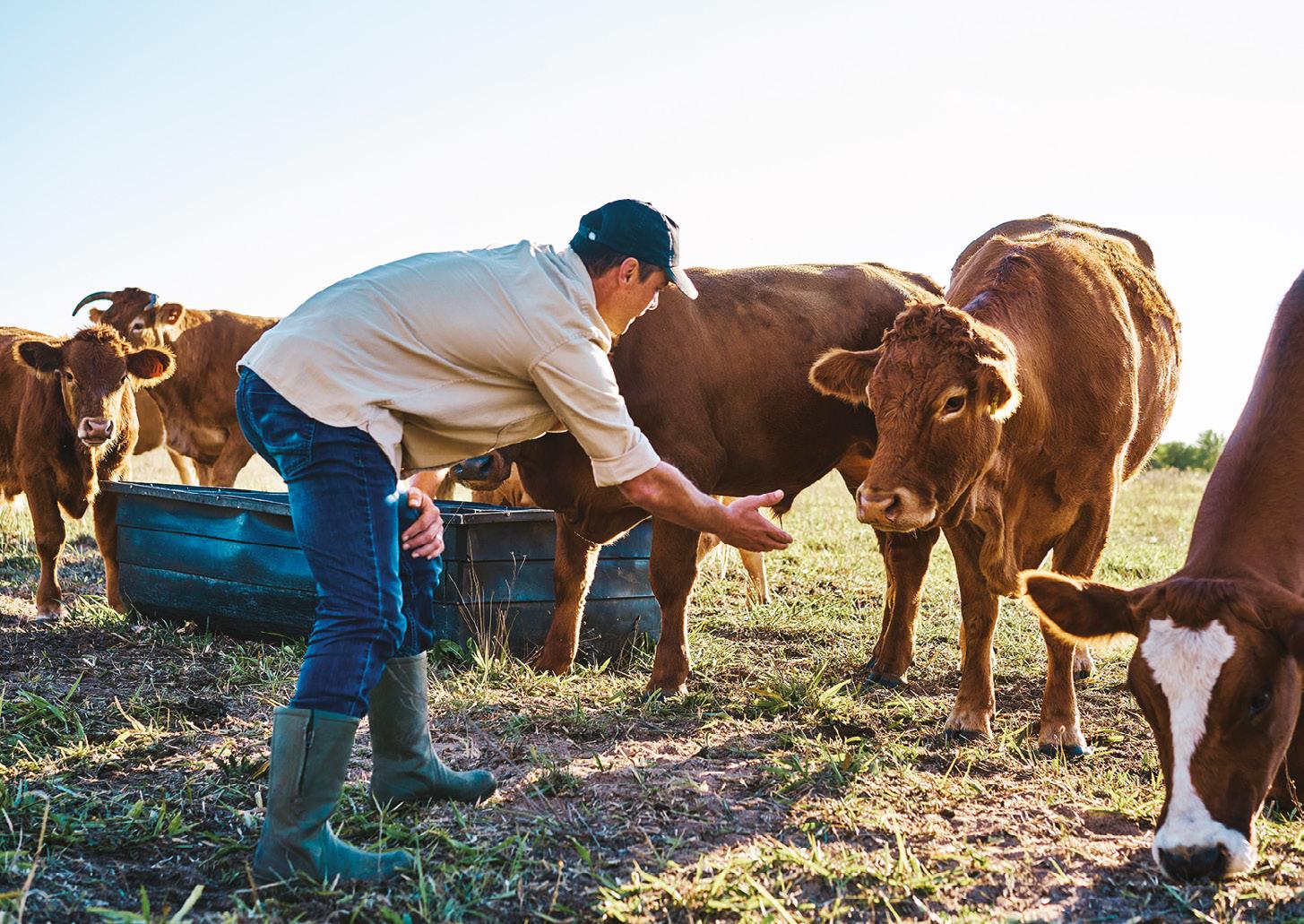
Tick fever is a serious disease in the northern parts of Australia affecting cattle. According to NSW DPI, when tick fever swept through Queensland in the 1990s in the absence of chemical control, about 3 million cattle died.
However, recent advances in tickicides, vaccines and drug technology means tick fever can be controlled.
In Australia, three different organisms cause the disease:
• Babesia bovis
• Babesia bigemina
• Anaplasma marginale
Of these three, Babesia bovis was responsible for about 80 per cent of the tick fever outbreaks in Australia. The organisms were microscopic parasites which destroyed the red cells in the blood, similar to malaria in humans.
Cattle that recovered from a natural infection of tick fever carried small numbers of parasites in their blood, usually for the rest of their life.
Typically, older cattle were more likely to be severely affected; calves up to several months old might not show any signs at all.
Farmers should immediately report cattle tick by calling the NSW DPI Cattle Tick Program on 02 6626 1201.
You can also contact the Emergency Animal Disease Hotline on 1800 675 888.
MAY-JUNE 2024 THE FARMER 13
The Muster
Pushing the boundaries of farming and science
Researchers around the state are using science and technology to improve food security, not just for Australia but for the world. We look at four research sites in NSW to see what’s cooking.
Words IAN NEUBAUER
In September 2023, the University of Sydney opened the International Centre of Crop and Digital Agriculture (ICCDA) in Narrabri in the north west slopes of NSW: the administrative centre of the second richest farming shire in Australia� Recognised for the production of some of the world’s best wheat, cotton, lamb and beef, the $15 2 million investment now also places Narrabri at the global forefront of agricultural research
The state-of-the-art facilities include digital, genetic and soil laboratories, teaching and industry briefing spaces and robot workshops It lies adjacent to a 2000-hectare experimental farm where researchers will produce improved crop varieties and develop farming systems with enhanced resilience and adaptive capacity to climate change � The ICCDA will also promote digital and robotic technologies for use by farmers to make their businesses more productive and profitable
“The research that will occur at this facility in Narrabri will be a game-changer for the industry,” NSW Agriculture Minister Tara Moriarty said at the opening ceremony� “Using the high-tech facilities, researchers will focus on adapting crops for drought-tolerance, providing food security solutions and boosting the productivity of farmers ”
students, national and international researchers and industry leaders to come together in Narrabri to improve crop performance for Australian farmers�”
IDENTIFYING THE MOST PROFITABLE CROPPING SYSTEMS
For the past six years, CSIRO researchers at four experimental sites in Wagga Wagga, Greenethorpe, Condobolin, and Urana have been sowing and monitoring crops to identify the most profitable and least risky cropping rotations for grain growers in southern NSW�
“Our investigation delved into diversifying canola-cereal systems with different legume options, conservative and optimistic yieldbased nitrogen fertiliser strategies, and earlier versus timely sowing with and without crop grazing,” CSIRO chief research scientist Dr John Kirkegaard says�
In January, the national science agency published the findings of research initiated by farmers seeking comparisons between traditional cropping systems and alternative systems that incorporate legumes with canola and wheat�
At all sites during the first threeyear phase, some farming systems were $200 to $300 per hectare more profitable, had stable or declining weed and disease burdens, lower average input costs, and consistently overperformed compared to the baseline canola-cereal farming systems�

NSW Wheat Research Foundation chair Rob Long says the ICCDA offered a massive boost for grains research� “These new facilities complement the research farm which plants over 40,000 irrigated plots every year on Narrabri’s rich vertosol clay soils,” he says “What an enticement for postgraduate
In the second three-year phase when there were much wetter conditions, systems with more canola tended to increase in profit and those with legumes declined For mixed systems, the most profitable l INNOVATION

> READ IT ONLINE THE FARMER MAY-JUNE 2024 14



GAME-CHANGERS
Clockwise from top left: CSIRO chief research scientist Dr John Kirkegaard; Brad Walmsley from the Southern Multi Breed project. Image: NSW DPI; The International Centre of Crop and Digital Agriculture at Narrabri.
MAY-JUNE 2024 THE FARMER 15
The Muster
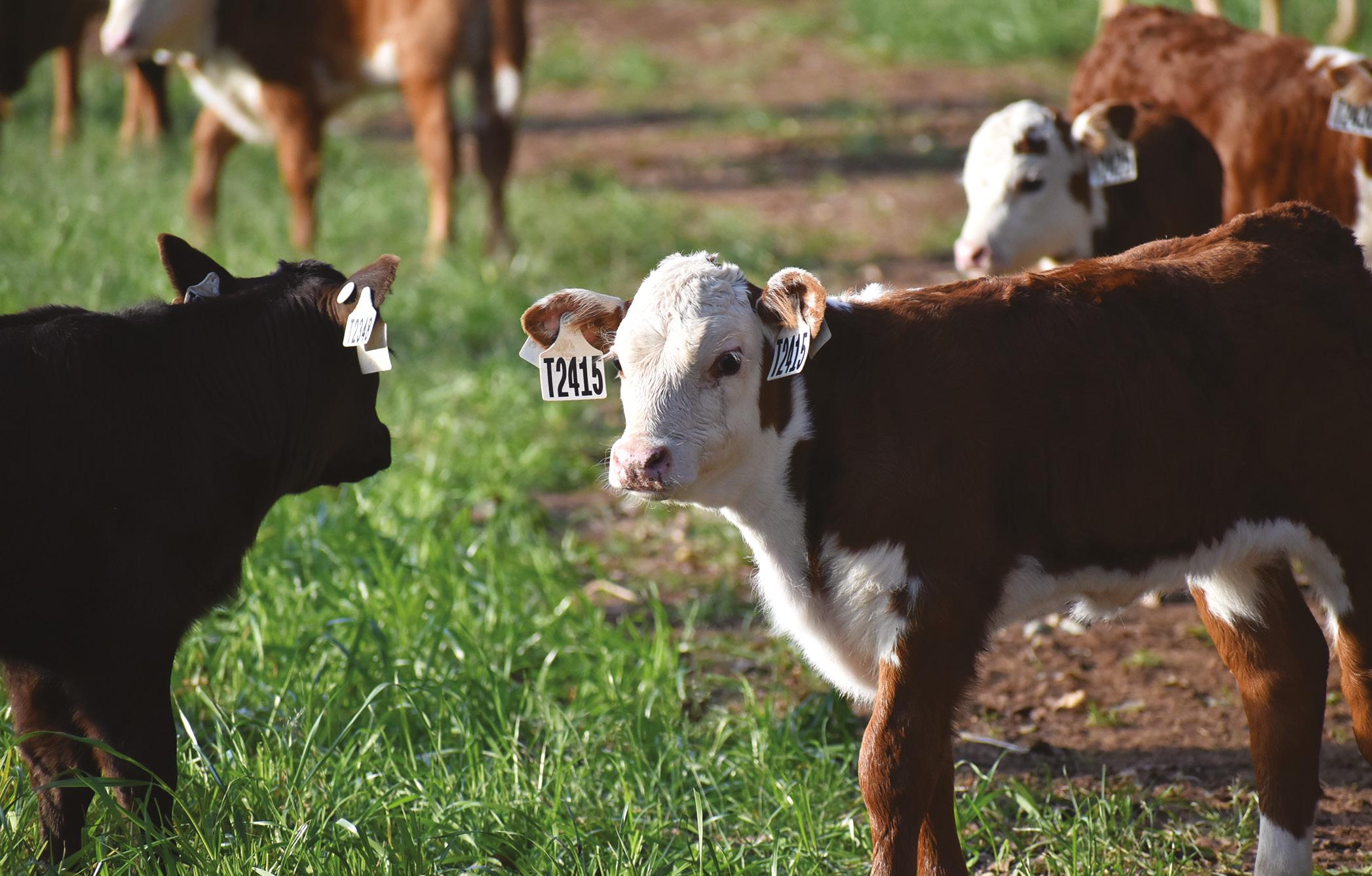
alternatives were wheat and canola with a higher nitrogen fertiliser strategy
“The value of this to the industry in terms of increased productivity and profitability is significant,” Delta Agribusiness consultant, Tim Condon says� “It is delivering positive actionable outcomes to grain growers�”
However, more long-term research is needed to further improve grain production in the state “Systems research takes many years and patience for the full effect of the treatments to emerge over time It also allows for the effect of variable seasons on measurements to be captured,” director of Lott Rural Consulting, Peter Lott says� “This is how low-risk, productive, economic and sustainable farming systems evolve�”
MEASURING THE GENETIC VALUE OF CATTLE It comes with a hefty price tag of $7 3 million, but as the largest ongoing beef cattle research project in Australia, the Southern Multi Breed (SMB) project promises to be money very well spent It will allow cattle farmers in NSW to measure the genetic value of different breeds for the first time� This in turn will allow them to make better-informed decisions to improve their herd� The information will also prove invaluable for commercial cattle breeders
A collaboration between the NSW Government, University of New England and Meat & Livestock
Australia, the SMB Project is taking place at five research stations and a research feedlot between 2020 and 2025, and focuses on six different breeds: Angus, Hereford, Shorthorn, Wagyu, Charolais and Brahman�
So how does it work? Researchers at the SMB project are creating datasets using BREEDPLAN traits that allow breed comparisons irrespective of hide colour At the same time, they are creating genomic values with higher accuracy than what is currently achieved, and building a reference for hard-to-measure traits like meat quality, methane production, immune competence and age at puberty�
INCREDIBLE INNOVATORS
Clockwise from top: Hereford calf in the Southern Multi Breed project; Renee Rippon, Kath Donoghue and Fay Haynes from the SMB project. Images: NSW DPI.
“The data we have that is of sufficient quality for BREEDPLAN evaluations, we’re currently in the process of making available for within-breed evaluations for use within the next 6 to 12 months.”
–
BRAD
WALMSLEY Principal investigator, SMB project
THE FARMER MAY-JUNE 2024 16
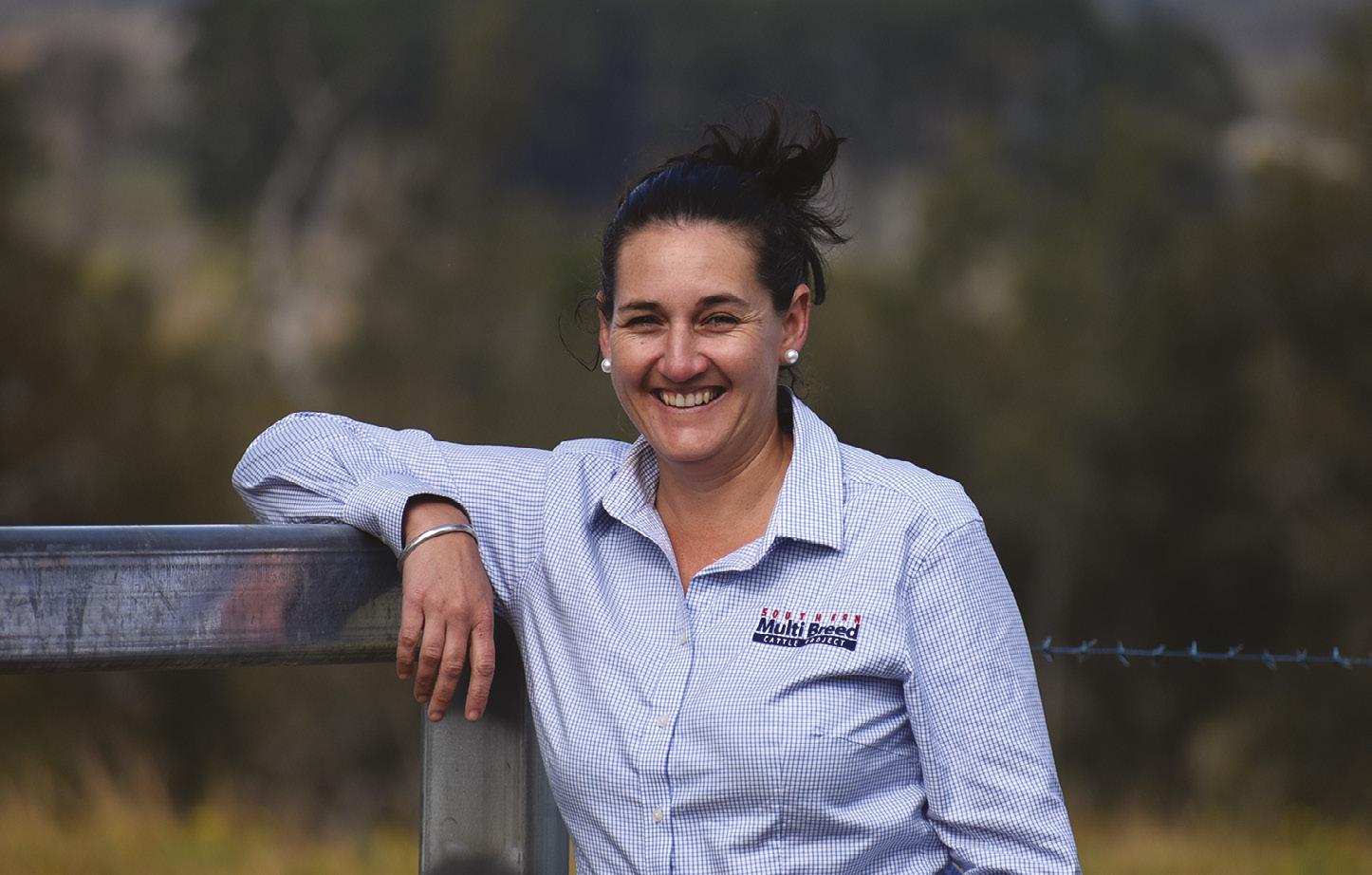
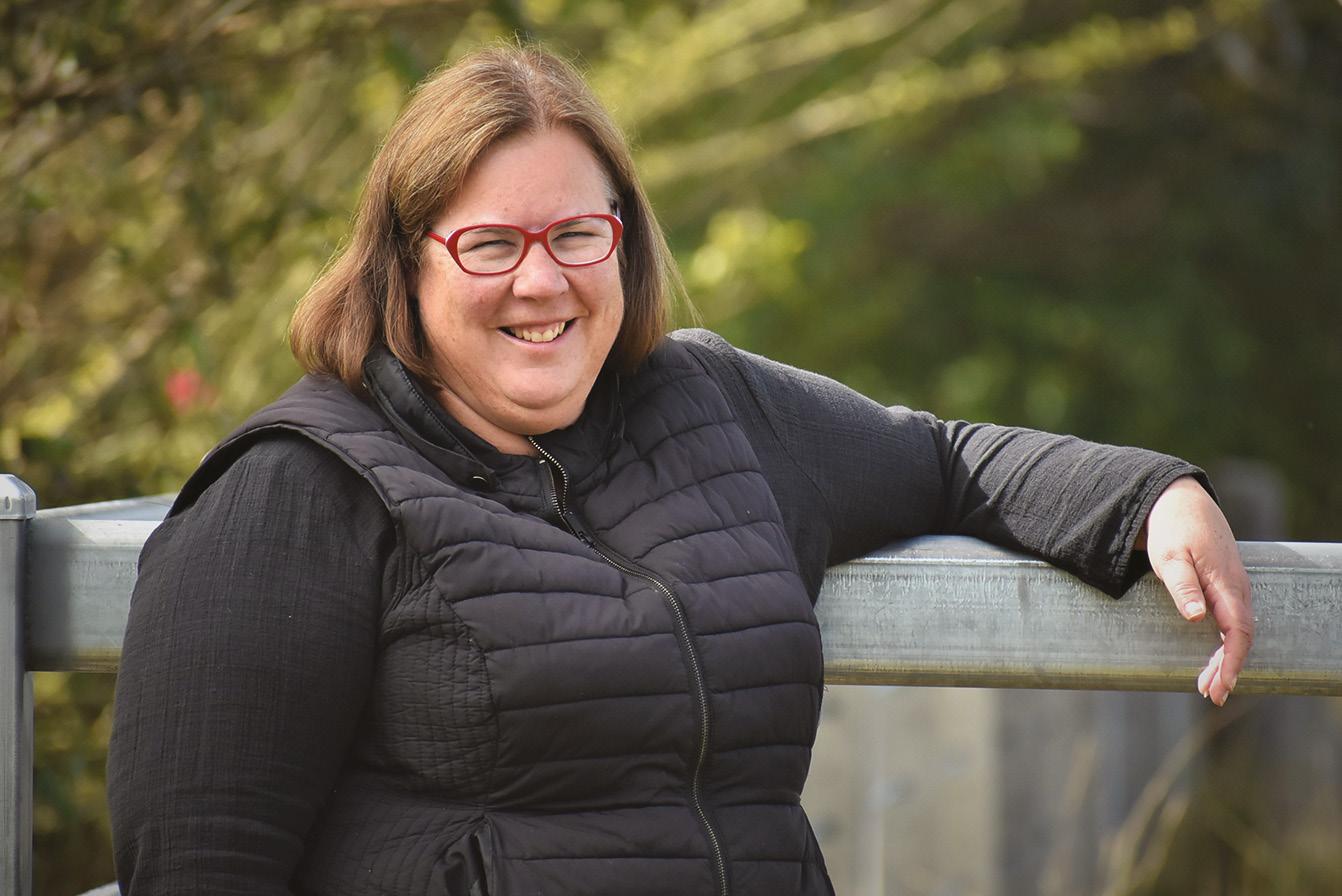
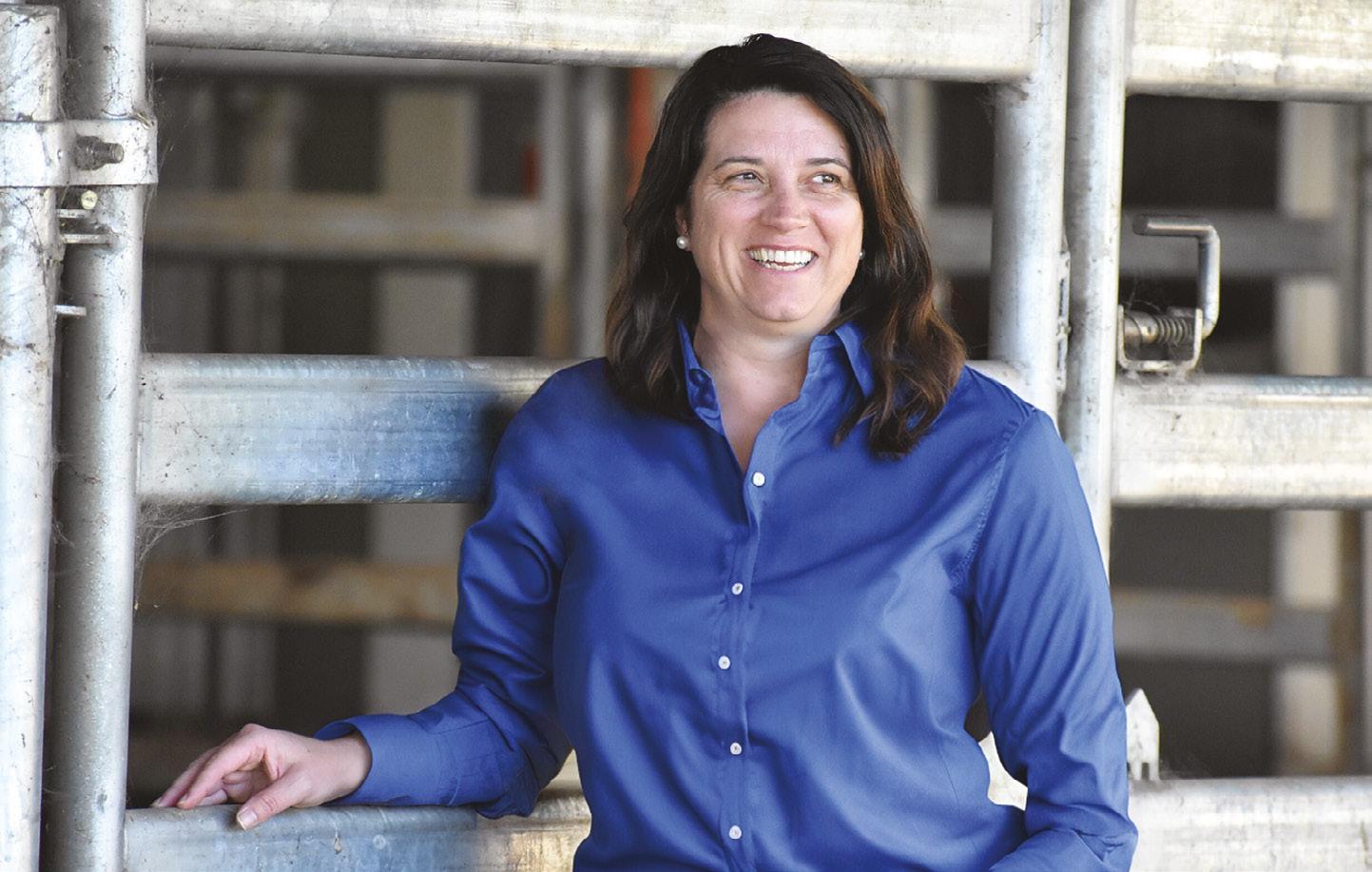
The research is expected to improve beef productivity and product value by improving the fertility rate, weaning rate, feed efficiency, sale weight and, at the same time, reducing the mortality rate of cattle The research will continue until the end of next year, though principal investigator Brad Walmsley believes actionable data may be in farmers’ hands only a few months from now
“The data we have that is of sufficient quality for BREEDPLAN evaluations, we’re currently in the process of making available for within-breed evaluations for use within the next 6 to 12 months,” Walmsley told Beef Central in September last year “We’re beginning to analyse data that will benefit the industry However, there are a series of steps that need to be followed to ensure the integrity of the data is maintained ”
WHEN AN EXPERIMENT GOES WRONG
Ten years ago, Italy’s Ferrero Group – the world’s fourth largest confectionery company and makers of the popular Nutella spread – started planting 1 million hazelnut trees on a 2700-hectare research farm near Narrandera in the NSW Riverina that had previously been used to grow potatoes
The pilot project, which received millions of dollars of financial support from the Federal and NSW Governments, aimed to provide a counterseasonal supply to the northern hemisphere crop� It was also meant to supercharge the sector by increasing Australia’s relatively small annual hazelnut harvest from 400 tonnes to 5500 tonnes per year, excess stock that had been slated for processing at Ferrero’s factory at Lithgow
Locals had warned the project was always going to struggle because of its location – and they were right� Earlier this year, Ferrero announced the experiment had not even achieved minimally acceptable yields and that it planned to mulch the trees into wood chips and sell the farm The Italians blamed adverse weather, specifically dry arid conditions that proved unsuitable for growing a type of tree that originated in the cool climate of northwest Europe
“I thought they were very brave,” Basil Baldwin, a hazelnut farmer in Orange who helped write the NSW growers manual, told the ABC� “I thought maybe if you did certain things, you might get it to work, like shading the whole orchard, just for example, which would be very expensive ”
Ferrero said it was disappointed with the project’s demise but that it had nevertheless produced valuable data and insights that the company is presently sharing with hazelnut growers in Australia� “This will support betterquality nut production with the benefit of the research conducted on different soil,” a company spokesperson said
The moral of the story? There’s no such thing as wasted research l
MAY-JUNE 2024 THE FARMER 17
Flocking to a mandatory code
The Farmer exposed the unfair market conditions faced by Australia’s chicken meat farmers back in 2020. A lack of processor competition and market transparency had led to the collapse of eight family chicken farms in the Northern Rivers region and a concerted effort for industry change began.
–

PECKING ORDER
more than 60 years.
Words MICHAEL BURT Photography SCOTT STRAMYK
18 THE FARMER MAY-JUNE 2024
Above: Kulnura farmers Lorraine and Rodger Wilson have been producing chicken meat for
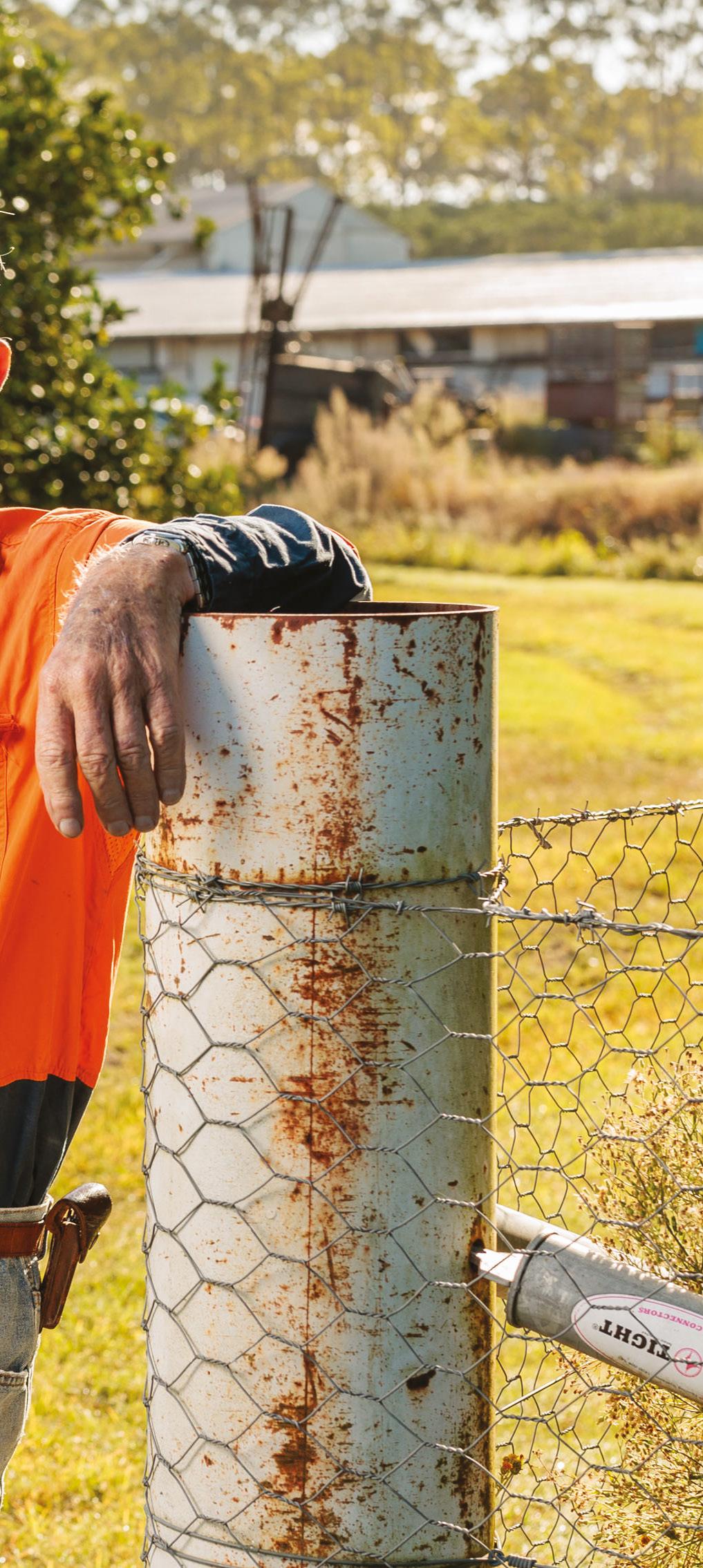
Four years after The Farmer exposed unfair market conditions most chicken meat farmers still have zero processor competition and zero bargaining power, but the push for fairer market conditions has gained momentum in recent months
It’s coming in the form of strong advocacy for a Mandatory Code of Conduct from NSW Farmers, supported by the National Farmers Federation (NFF) and the Australian Chicken Growers Council (ACGC)�
The NFF completed a year-long investigation into the poultry meat sector in April that revealed a widespread lack of market transparency, misuse of market power and economic harm within the poultry meat supply chain
Much of the investigative work was done by NSW Farmers Poultry Meat Manager David Banham, who spoke to about 150 farmers at workshops across the country and received a further 216 responses to a survey�
The message from farmers was clear: there was little to no choice in processors, growing contract terms were unfair, and there was a deliberate undermining of collective bargaining efforts
“There was clear evidence from farmers that there is an inequity in the system,” David said�
The research project, funded by the Department of Agriculture, Fisheries and Forestry (DAFF), concluded that the Australian Government must implement a mandatory code similar to one introduced in the dairy industry
“Administered by the ACCC, the code will provide a regulatory framework that provides confidence and fair trading in the poultry meat supply chain and will support best-practice policy and regulation for growers and processors,” NFF CEO Tony Maher said�
Parts of the project’s final report mirrored findings from the ACCC’s Perishable Agricultural Goods Inquiry in 2020, which highlighted significant concerns about practices in the Australian poultry meat supply chain
Only one processor – Inghams – accepted the NFF’s invitation to engage in the project The major processors had been consistent in denying that price transparency between growers and processors was an issue and that a Mandatory Code of Conduct would be of benefit� The chicken meat processing sector’s peak body, the Australian Poultry Industry Association, agreed
Farmers receive about 33 cents per kilogram to grow out chickens according to the ACGC – the national body for poultry meat farmers A whole roast chicken from the supermarket, one of the lowest cost retail poultry options, cost about $7�27/kg (based on $12 for a 1�65kg chicken)� So at best, growers were getting less than 2�7 per cent of the retail price�
“The reasons why growers want a Mandatory Code of Conduct are the same reasons dairy farmers did nine years ago, and that is they are utterly at the whim of >
THE BIG ISSUE POULTRY
READ IT ONLINE 19 MAY-JUNE 2024 THE FARMER

the processor-supermarket consortium,” ACGC CEO Joanne Sillince said�
“It’s even a bigger deal for poultry meat growers as dairy farmers at least had quite a few processors to sell to In almost all cases, a chook farmer has only one processor to contract to The only exceptions to that are southern Victoria and South Australia ”
The publicly-listed Inghams Enterprises and the family-owned Baiada Poultry produce 70 per cent of Australia’s chicken� In NSW the market is dominated by Baiada and Cordina, which control predominately separate growing regions
“There is no question that a Mandatory Code of Conduct is likely to be the only way to engender fair negotiation and some transparency in the supply chain,” Sillince said
“Having a Mandatory Code of Conduct does not mean you have to negotiate, but it does put enforceability around the negotiation, contracts and the outcome�
“It would give growers the support of the ACCC standing behind them with a very big stick to ensure negotiations were fair It goes a long way to getting rid of the ‘take this price or else’ mentality ”
The ACGC did receive some feedback from growers who feared the potential for retribution from their processor and did not feel comfortable contributing to the NFF project�
“A Mandatory Code of Conduct would also change the interaction between the supermarkets and processors For the first time, supermarkets will be able to see what farmers are getting paid,” Sillince said
NO MORE FOWL PLAY Farmers rally for transparency and equity in the poultry meat supply chain, and are seeking a regulatory framework akin to the dairy industry’s model to ensure fair treatment for growers and processors alike.

“The important part in the NFF report is that the supermarkets are backing a Mandatory Code of Conduct The ACGC is heartened by the retailer response of offering to commit to a Mandatory Code of Conduct in this industry, and willingness to participate in a more transparent supply chain ”
The NFF’s final report on the project was provided to DAFF and Assistant Minister for Competition, Dr Andrew Leigh, and Treasurer Jim Chalmers�
FROM JUNIOR FARMER TO INDUSTRY CHAMPION
Lorraine Wilson’s entry into the poultry meat industry started 64 years ago with a NSW Junior Farmers project to grow out 100 chickens on the family farm at Kulnura
“The reasons why growers want a Mandatory Code of Conduct are the same reasons dairy farmers had nine years ago, and that is they are utterly at the whim of the processorsupermarket consortium.”
–
JOANNE SILLINCE ACGC CEO
THE BIG ISSUE POULTRY
20 THE FARMER MAY-JUNE 2024

“I made 29 pounds and some shillings, and my father thought that wasn’t a bad return� We already had free range laying hens to mainly get rid of the weed problem, which they did,” she said�
Lorraine’s parents Ray and Joan Walpole, who were already growing vegetables, managing a young citrus orchard and producing free range eggs, took the bold step of investing in the first of three poultry meat sheds in 1959
Lorraine and her husband Rodger have continued the Wyuna Farms poultry meat venture to this day on the 19-hectare farm alongside son Greg and wife Kate � Five grandchildren also help out at different times and enjoy a farm full of activity
“We’ve always diversified with three different income streams on the farm It used to be tomatoes, citrus and (egg) layers and then it was citrus, layers and meat chickens� We got out of layers and replaced that with a landscape yard,” Lorraine said�
“The last of the poultry meat sheds was built in 1994, allowing us to have up to 70,000 birds� The sheds and equipment have been upgraded many times especially in the good years and still perform well producing chickens that can get into the top quartile for quality in the contract pool ”
Lorraine credits husband Rodger for much of the >
TICKETS ON SALE



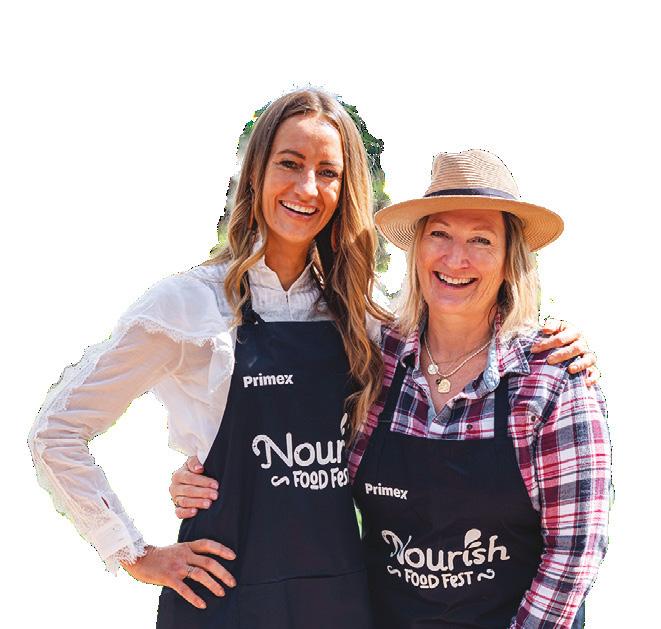
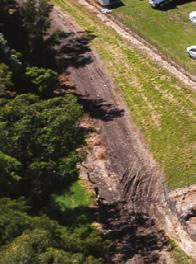





SOFT AGRICULTURE
NOW *T&C’s Apply
Lorraine and Rodger Wilson on their Kulnura property.
farm’s resilience to the challenges that have come to bear, such as the Newcastle disease outbreak in 1999 and a drop in farm gate prices for the citrus crop�
“This farm would not have continued to this day if I had not married my Kiwi farmer,” Lorraine said “Rodger has played a huge part in the poultry meat business and managing the citrus orchard He has also been active in the local NSW Farmers horticulture branch, the Chamber of Commerce and Rotary� Not bad for a former sheep and beef farmer in New Zealand�”
Rodger moved to Kulnura in 1965 to help out on the farm when their workers left for high paying jobs on the M1 motorway construction
“The next two decades were rewarding years of growth with meat chickens, layers and citrus And we bought another 20-acre block to plant citrus The farm provided for five families working and mostly living on Wyuna Farms� The citrus tree count reached 11,000 and we stopped growing tomatoes as a cash crop,” Lorraine said�
Lorraine said the family has not owned a commercial chicken meat chicken since the Junior Farmers project
“It’s always been a contract growing system for poultry meat farmers It is quite unique for a farming operation to not own its stock,” Lorraine said
“We have stuck with it because of the investment we have put into it, and it was a really good industry to be in�
“It started to go off a bit in the 1990s and now it’s not so hot, but we have big investment in the sheds that can’t really be used for anything else Our diversification plans were well in place before this and that has kept the farm going 70,000 chickens these days is not enough for a liveable income ”
Lorraine said the rise of poultry meat to the top of the food chain for meat consumption has ironically been to the detriment of some smaller family farms�
“In the days when we grew for Inghams, we were only allowed to have three sheds Chicken meat started to get popular in the 1990s and the processors needed economies of scale to meet market demands and encouraged farmers to expand,” Lorraine said


“In the days when we grew for Inghams, we were only allowed to have three sheds. Chicken meat started to get popular in the 1990s and the processors needed economies of scale to meet market demands and encouraged farmers to expand.”
–
LORRAINE WILSON Poultry farmer
Lorraine is championing a return to fairness for everyone in the supply chain when it comes to poultry farming. “That’s what made it a good industry to be in and it could be again,” she says.
THE BIG ISSUE POULTRY
TOP OF THE FOOD CHAIN
22 THE FARMER MAY-JUNE 2024
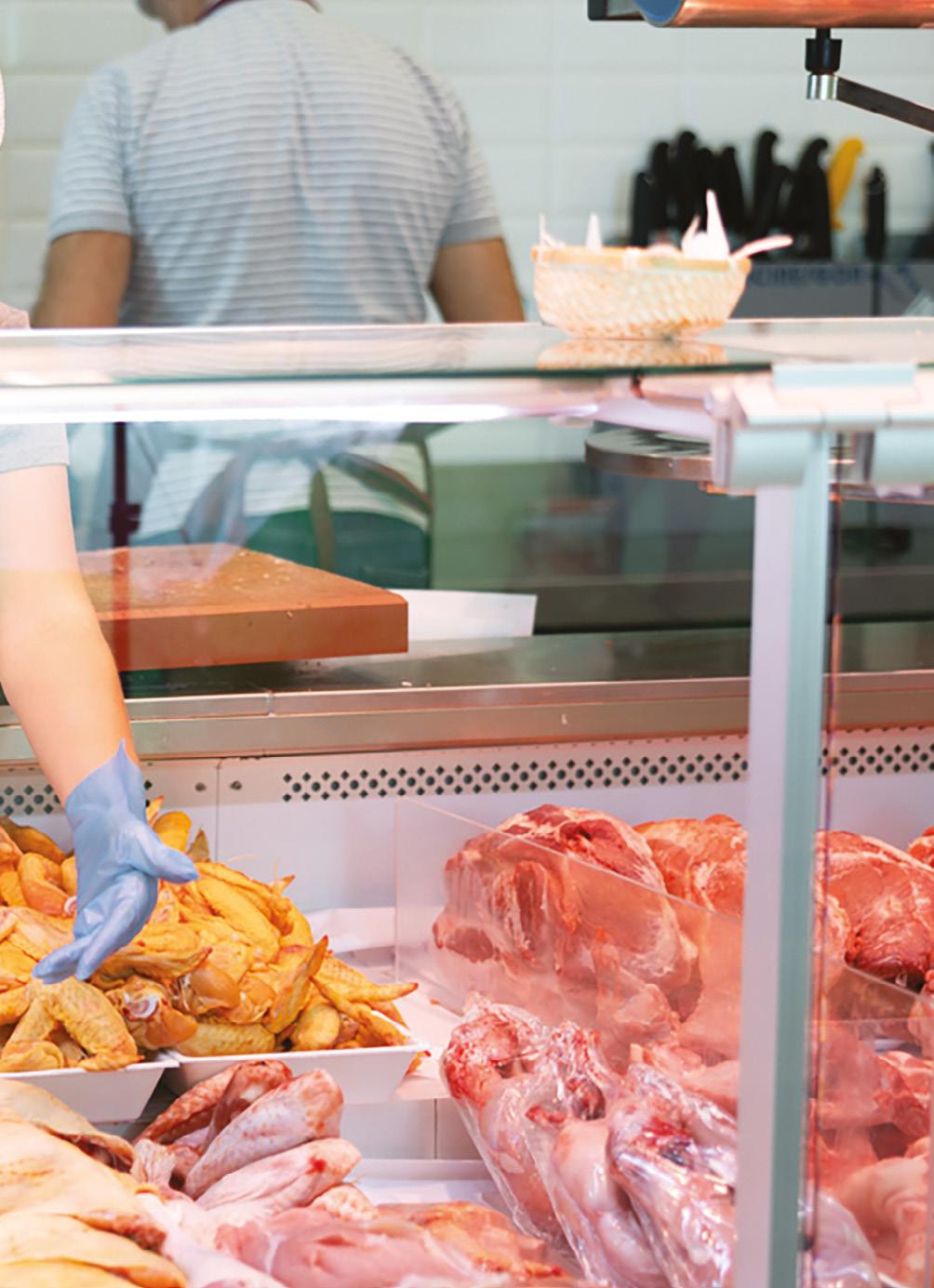
The Central Coast Plateau remains as one of five major poultry meat producing regions in NSW alongside Tamworth, Griffith, the Sydney Basin and the Hunter region
Lorraine has been a champion for the poultry meat industry and local food production for decades and currently chairs the NSW Farmers Poultry Meat Committee� She first took up the mantle of representing the industry when Newcastle disease hit the Central Coast region
Newcastle disease reduced income for Wyuna Farms by about 90 per cent for nine months and it took more than a decade for the farm business to recover�
“We had always been members of NSW Farmers, but the impact of Newcastle disease changed everything� I decided that we all needed to take some responsibility to help ourselves and I became active at that time,” Lorraine said
Lorraine takes the same view with addressing the issues of unfair contract terms, no processor competition and lack of transparency that were raised by farmers in the NFF project�
“I just want to see the industry return to one that is successful for everyone in the supply chain, from the farm to the consumer� That’s what made it a good industry to be in and it could be again We just need to make it attractive again as a family farming business,” Lorraine said l
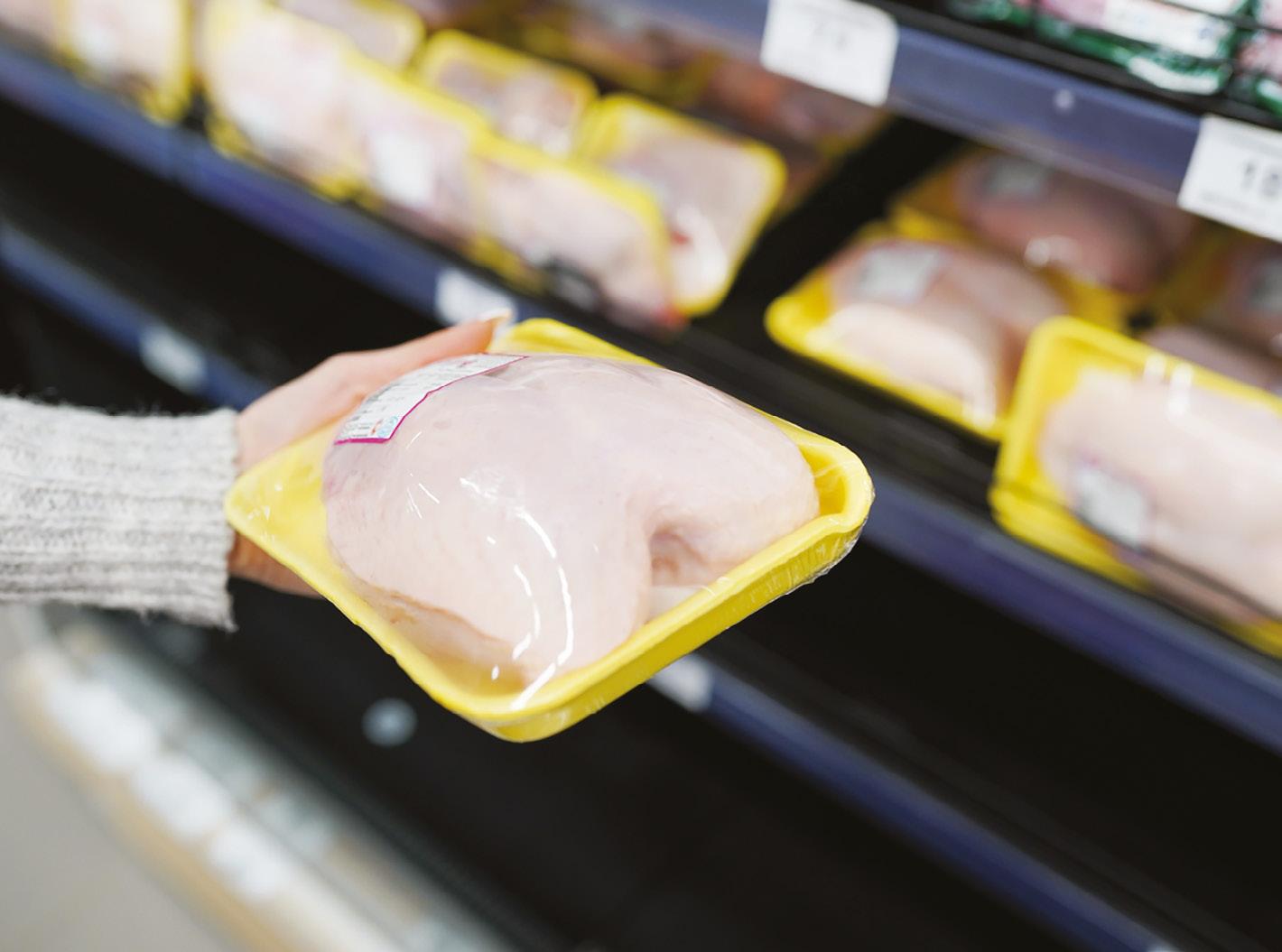

23 MAY-JUNE 2024 THE FARMER

Europe’s perfect storm
European farmers are up in arms over a perfect storm of rising costs, cheap imports and radical sustainability plans that have left many of them unable to make ends meet.
–
Words IAN NEUBAUER
The Big Picture READ IT ONLINE 24 THE FARMER MAY-JUNE 2024

Earlier this year, angry farmers rolled into Brussels – where the European Union (EU) has its headquarters – in a convoy of hundreds of tractors, dumping and setting fire to tyres in the streets, lobbing eggs at government buildings and spraying police with manure.
The very same day, an estimated 10,000 farmers marched in the Polish capital of Warsaw dressed in red and white, the colours of the Polish flag, while they chanted, blew horns and set off flares. Some 600km to the east, farmers blocked all the major border crossings with Ukraine and reportedly vandalised railway containers, destroying hundreds of tonnes of imported grain.
Meanwhile in France, farmers blockaded motorways leading into Paris for a multi-day ‘siege’ to figuratively starve out the city. And in Greece, Romania, Spain and Portugal, farmers parked trucks and dumped hay on major highways, bringing traffic to a standstill.
Why are these farmers protesting? And what exactly do they want? Well, the answer varies from country to country, but there’s one common theme: squeezing farmers to breaking point.
PLOUGHING THROUGH PAPERWORK
In Germany, farmers are demanding the government axe plans to phase out tax breaks on agricultural diesel. In Greece, farmers are protesting the same, on top of sky-high electricity rates. In Romania, farmers protested the high insurance rates and cheap imported foods.
In France, farmers are demanding better crop prices and wages, plus a reduction in burdensome red tape that requires them to spend up to a quarter of each day at their desks. “They’re drowning us with all these regulations,” a French farmer told The Guardian. “They need to ease up on all the directives and bureaucracy.”
In Spain, farmers were saying exactly the same thing: “They don’t let us plough. Just let us plough in peace without all the paperwork,” potato farmer Fernando Jimare told the BBC.
Farmers in Spain are also demanding the right to use the same cost-effective herbicides and pesticides as farmers in Vietnam, South Africa and other countries that enjoy lucrative free-trade agreements with the EU. “We want to compete with the same deck of cards,” Juan Carlos, a sunflower oil producer, told Spanish TV. “If they use a certain product, we want to be able to use the same one.”
The list goes on. In the Netherlands, farmers are revolting against plans to radically cut herd sizes to reduce nitrogen emissions, as well as EU spy satellites that check what Dutch farmers sow and when.
The fiery protests in Brussels, the seat of the EU, were staged in response to the Green Deal: a suite of strict new regulations to help fight climate change that will require farmers to leave 4 per cent of their land, slash fertilizers >
25 MAY-JUNE 2024 THE FARMER
by 20 per cent and pesticides by a whopping 50 per cent by 2030. “On the one hand, we are being asked to farm more sustainably,” Morgan Ody of farming organisation La Via Campesina told TIME magazine. “But at the same time, we are asked to keep producing as cheap as possible, which puts us in an impossible situation.”
In Poland, farmers are fed up with the EU and it’s lifting of tariffs and quotas on Ukrainian food imports, because the Russian invasion made it very difficult to export the country’s vast agricultural produce. For more than six months they’ve been telling politicians that they just can’t compete with cheap Ukrainian sugar, wheat and eggs that are not subject to the same strict environmental regulations as the stuff they grow. “Ukrainian grain should go where it belongs, to the Asian or African markets, not to Europe,” Adrian Wawrzyniak, a spokesperson for the Polish farmers’ trade union, told Wiesciro Nicze, a Polish news site.
But the one grievance that united them all is the hard-to-swallow fact that most small family-run farms and many mid-size farms in Europe are being denied the right to earn a profit. “We work 16 hours a day, 365 days a year,” Charlotte Van Dyke, the daughter of a Belgian farmer, told Global News. “We don’t take vacations, a weekend trip to France, we can forget about it because we have to feed our animals at 5am. We get up every day at the same time and we can consider ourselves lucky if we are in bed at 10pm.”
FURIOUS FARMERS DEMAND CHANGE
Rising input costs and stagnant or falling farm gate prices are the immediate causes of the impossible financial conundrum facing EU farmers. From 2022 to 2023, farm gate prices fell 10 per cent in 21 out of 27 EU member states, according to Eurostat data. In countries like Lithuania and Bulgaria that have high specialisation in cereals and milk, farm gate prices have tumbled by 23 per cent and 28 per cent in the same period, respectively.
“We are no longer making a living from our profession,” a farmer at a protest in Paris told CNN Daniel-Henri Sparmont, a farmer who joined the protests in Brussels, said to Sky News: “I am angry. Over the years we have had many discussions with politicians and parliament, and time and time over they told us we have heard you, we will make change, but now many of us are starting to feel desperate.”
“Our main demand,” said Ody of La Via Campesina, “is that we get a European law that ensures that the price we get covers the cost of production, including revenue.”
Although it makes perfect sense, that particular demand is not yet being taken seriously by legislators. But with so many protestors hitting the streets and politicians losing sleep over upcoming elections, individual European governments were fast to react.
Germany walked back on its plans to cut diesel subsidies for farm vehicles for at least three years. Portugal announced $830 million in emergency aid >
Continued on page 28.
“Over the years we have had many discussions with politicians and parliament, and time and time over they told us we have heard you, we will make change, but now many of us are starting to feel desperate.”
–DANIEL-HENRI SPARMONT Farmer

 NO FARMERS, NO FOOD
Above: Polish farmers block highways nationwide. Below: Protestors block roads around the EU headquarters in Brussels.
NO FARMERS, NO FOOD
Above: Polish farmers block highways nationwide. Below: Protestors block roads around the EU headquarters in Brussels.
THE BIG PICTURE
26 THE FARMER MAY-JUNE 2024
TEMPORARY RAIN, PERMANENT NEEDS
“When the well’s dry, we know the worth of water.”
–
BENJAMIN FRANKLIN -1946
RAIN maybe helping farmers, but in a lot of cases this is a temporary solution.
With our changeable climate, many regions in Australia are drought-prone, and with a continuously warming climate, some properties could be hard hit.
After extensive research, the Earth Systems and Climate Change Hub provided information on future droughts in Australia. They gave projections through to the year 2100 to help with

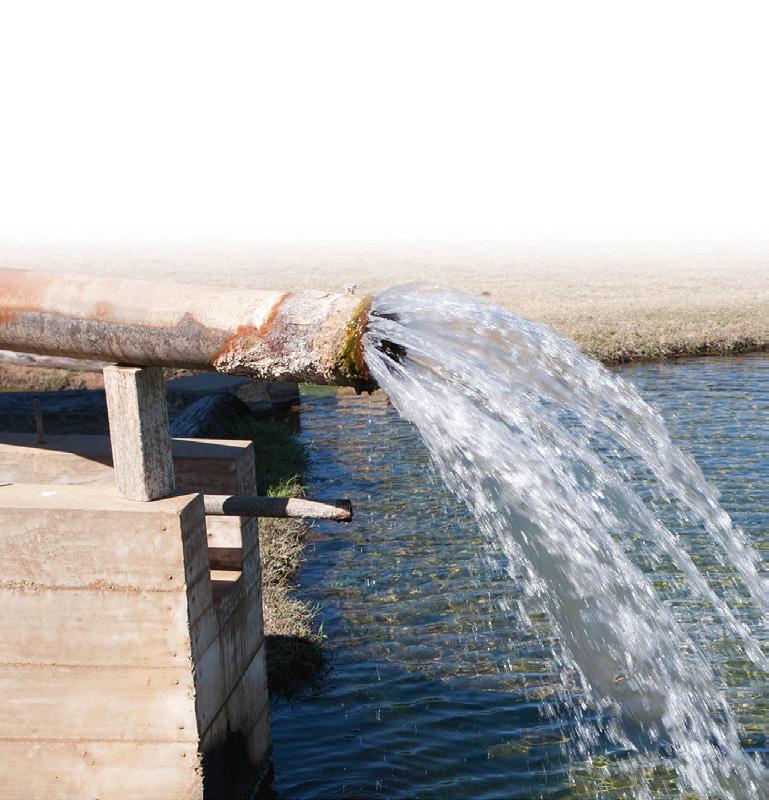
a future look into drought conditions. Their full report can be found here: nespclimate.com.au
For those currently experiencing drought or who have had to live through it, you don’t need to be told about the stress and grief it brings. It’s important to get ahead of the game - prediction and planning can’t be understated.
Rain can give hope, however, there are a lot of factors involved to have a reliable water source. Finding good potable water on a property can be a challenge, a hit and miss affair. However, with the correct technology, potential underground water sources can be discovered, even in formidable areas like the Granite Belt – and they have been.
Mr Jim Conley, Co-founder of Sustainable Water Pty. Ltd. stated, “My business partner and I were sick of seeing hard working farmers suffering unnecessarily, all for lack of a good bore. So, we formed our company with this mission – to help Australian primary producers, those who keep the country alive, find the best possible place to drill so they can flourish and prosper on
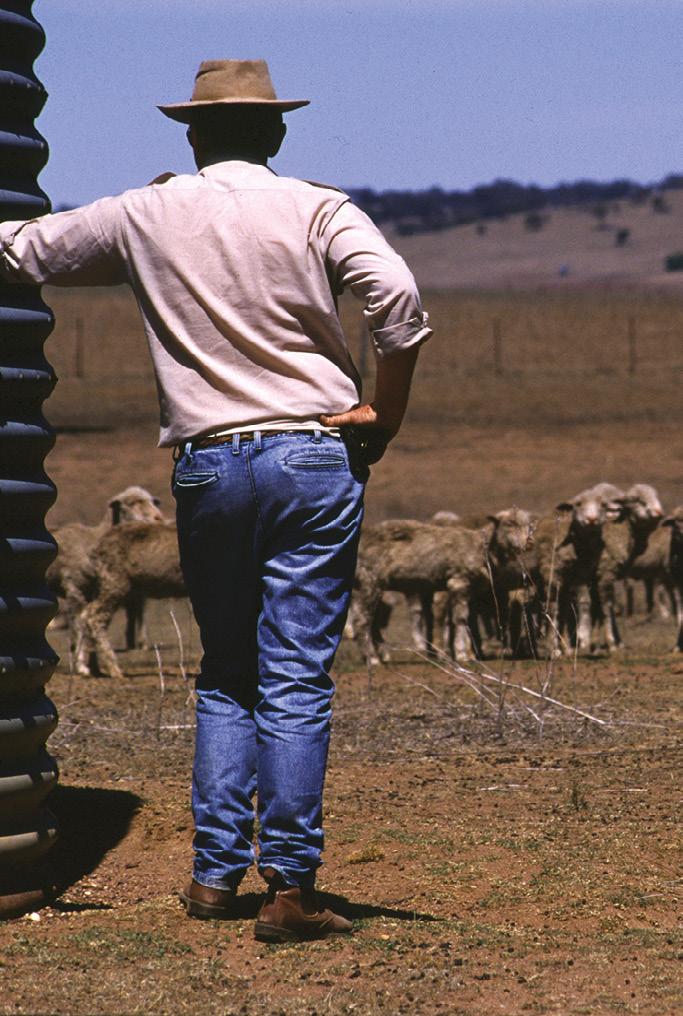
their properties.” He continued, “Our technology scientifically locates best drill sites, and we like to service our clients by coordinating with their drillers. We have provided solutions for hundreds of farmers and continue to do so all throughout Australia.”
WATER BORE SITES LOCATED BY SCIENTIFIC METHODS
Free High-Level Assessment
We begin with a free high-level assessment (HLA) of your property
Every Property is Unique
We analyse your property’s unique characteristics; its surfaces, existing water resources, and its deeper geological water bearing structures and geophysical data.
The First Stage: Maps are created from airborne, satellite and on-the-ground data sets using advanced analytical technologies. Fracture trace analysis locates potential water bore sites over potential deep fractured-rock groundwater resources coming up near the surface.
The Second Stage: Our team does on-site ground surveying deploying special instruments calibrated for water search to verify and hone the results of the first stage mapping and analysis.
You get precise drilling locations physically staked on your property, and a complete Final Report with 2D and 3D data on expected drilling depths accompanying your property’s maps and bore site coordinates.
Drilling: You can give the Final Report to your driller, and we will consult with you and your driller through the whole process. Pricing: Affordability is aided by our ability to do desktop analysis.We can usually respond with a same-day or next-day quotation depending on your water requirements, property size and property location details.
Louis Ceberano M 0405 939 592 E louis@sustainablewatersolutions.com.au
ADVERTORIAL
The weather might be beyond control, but those needing reliable water can do something about it using modern scientific methodology.
27 MAY-JUNE 2024 THE FARMER
Not an unfamiliar site when the rain has gone, and drought conditions hit.

for farmers. French Prime Minister Gabriel Attal pledged to safeguard “food sovereignty”, increase checks on food imports “that don’t respect our rules at a European and French level,” and introduced $415 million worth of annual tax breaks and social support for hard-hit livestock farmers. Romania committed to subsidising agricultural excise until 2026 and to compensate farmers for income lost because of Romania’s support for Ukraine.
As for the EU, it hasn’t got a clue how to ensure Ukrainian farm exports return to their traditional markets outside of Europe. Instead, it simply delayed the hard decision by extending the suspension of import and quota duties for 12 months to June 2025.
The EU did, however, compromise with farmers on other sticking points. It scrapped a goal to cut farming emissions out of its climate roadmap, withdrew the new law to halve the use of inorganic pesticides by 2030 and delayed the deadline for farmers to leave 4 per cent of their land fallow to improve soil health.
“These measures will constitute the first concrete steps that we will make to quickly respond at the European level to some of the worries of farmers,” Belgian Deputy Prime Minister David Clarinval said at a press briefing.
A STOPGAP SOLUTION
Walking back new environmental regulations is just a stopgap solution that won’t solve the problem of dwindling farmers’ income, argued Vincent Delobel, spokesperson for the Belgium farmers’ union, and Ody from La Via Campesina, in an opinion piece for Al Jazeera.
The root cause of the problem, they wrote, was the deregulation of agricultural markets and free trade
GROUND TO A HALT
Above: Amidst widespread protests, European farmers line the streets in Brussels to rally for fair treatment, urging policymakers to address the economic and regulatory pressures squeezing their profitability and sustainability.
agreements that have “placed all the world’s farmers in competition with each other” and set them up to be squeezed by powerful retailers and agrochemical companies. The authors pointed to an unratified free trade agreement with Argentina, Brazil, Paraguay and Uruguay as especially ludicrous, though one could imagine they regarded the proposed free trade agreement between the EU and Australia with similar disdain.
The sustainability of European agriculture would not improve “without breaking away from old logic,” they wrote. “Producing ecologically costs more for the farmers, and so to achieve the agroecological transition, agricultural markets need to be protected. It is the neoliberal framework that must be challenged, not environmental regulation.”
Removing environmental regulations may have stopped the protests – for now. But they aren’t going to do the soil, water and air farmers require to make a living any favours. Farming makes up just 1.4 per cent of gross domestic product in the EU yet accounts for more than 10 per cent of the region’s greenhouse gases. Reforming the ways food and fibre are produced on the continent remains an imperative and inevitable mission. Because the alternative is just not an alternative.
“We believe people without their agriculture are not free people,” Roberto Rozati, an Italian farmer protesting in front of the Colosseum in Rome told the Associated Press. “Depending on faraway countries for our own food means something negative for health, for the economy and also the environment if you think about moving products from one side of the globe to another.” l
THE BIG PICTURE 28 THE FARMER MAY-JUNE 2024

Local Land Services
Your voice, your vote
Voting opens on 21 May for 34 local board member roles across NSW.
Your vote will help Local Land Services build strong local boards, with members who are committed to helping you and your local communities’ needs.
Board members help shape the strategic direction of local land services delivered across your region, including biosecurity, emergency management and agriculture and natural resource management advice.

Learn more about the candidates standing for election for your local board lls.nsw.gov.au/board-recruitment
If you haven’t already requested a voting pack, you can still request an electronic voting pack, by scanning the QR code.
Electronic voting packs will be issued by the Australian Election Company to your nominated email address from 20 May 2024. Please check your spam folder if you don’t receive it.


Insurance issued by Insurance Australia Limited ABN 11 000 016 722 trading as WFI. To see if a product is right for you, always consider the Product Disclosure Statement and Target Market Determinations available from wfi.com.au. NSW Farmers is a referral partner of WFI and does not provide any advice, recommendations or an opinion about WFI’s products. If you take out a policy with WFI, NSW Farmers receives a commission from WFI of between 7.5% and 10% of the policy premium (excluding taxes and charges). Local reps on the ground to give your insurance a human touch. Find your local rep at wfi.com.au
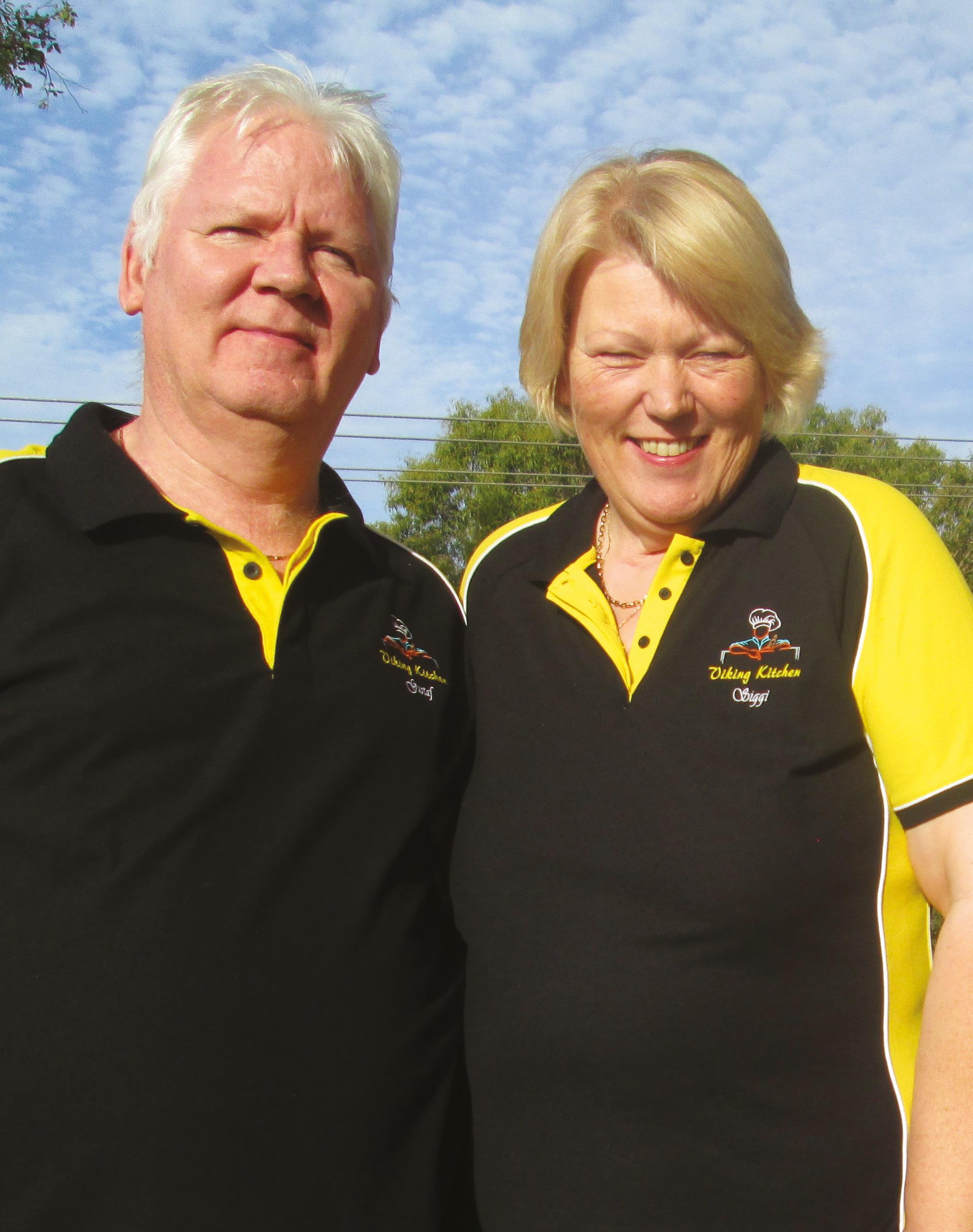
Gustaf and Siggi bring their Icelandic heritage to the Coffs Coast, teaching the art of value-adding and no-waste processing, preserving tradition while unlocking new business opportunities.
BUSINESS VIKING HERITAGE
VIKING FLAIR
READ IT ONLINE 32 THE FARMER MAY-JUNE 2024
Value-adding with a Viking flavour
NSW Farmers members are a diverse bunch of food and fibre producers. Very few, however, would claim Viking heritage or growing up on Icelandic farms and fishing boats like Gustaf and Siggi Ragnarsson from Coffs Harbour.
–
Words MICHAEL BURT
Gustaf and Siggi have been teaching the Viking way of preserving food with a no-waste approach to processing meat as a business opportunity for farmers in NSW for the past 15 years. While they now proudly call the Coffs Coast region home, their Icelandic roots remain strong and have made their way into hundreds of farming businesses across northern NSW to grow value-adding opportunities.
“We had both always wanted to come to Australia. We had both applied for visas even before we met, but we were too young. I don’t know why it had to be Australia, perhaps it was the Viking desire in us to travel afar,” Gustaf said.
The couple spent 10 years living in Sweden before moving to Australia 35 years ago with two young boys in tow. Gustaf grew up on fishing boats in southern Iceland while Siggi spent much of her childhood years on a mixed farm in the middle of the small island nation.
“My brother had a business building fishing trawlers in Eden, so I went there to ply my skills from Iceland,” Gustaf said. “My brother was a master in building fishing boats and moved the business to Portland in Victoria.”
Siggi and Gustaf oddly found Portland too cold and moved to the sub-tropical climate of the Coffs Coast region. Siggi continued her nursing career while Gustaf focussed on using their business and food preparation skills to open a restaurant that used traditional Viking methods of cooking food on hot rocks.
While Gustaf tapped into the bounty of local fresh produce and seafood for the Royal Viking restaurant, Siggi revived her Icelandic cheesemaking and meat curing skills, and joined her husband in becoming a qualified business trainer.

“We started to offer value-adding workshops for farmers was because so many people we met from regions west of Coffs Harbour wanted to learn how to make more from dairy and meat products, including from animals like deer, pigs, and goats.”
–SIGGI RAGNARSSON
>
33 MAY-JUNE 2024 THE FARMER
Image: Nordic horned black sheep.
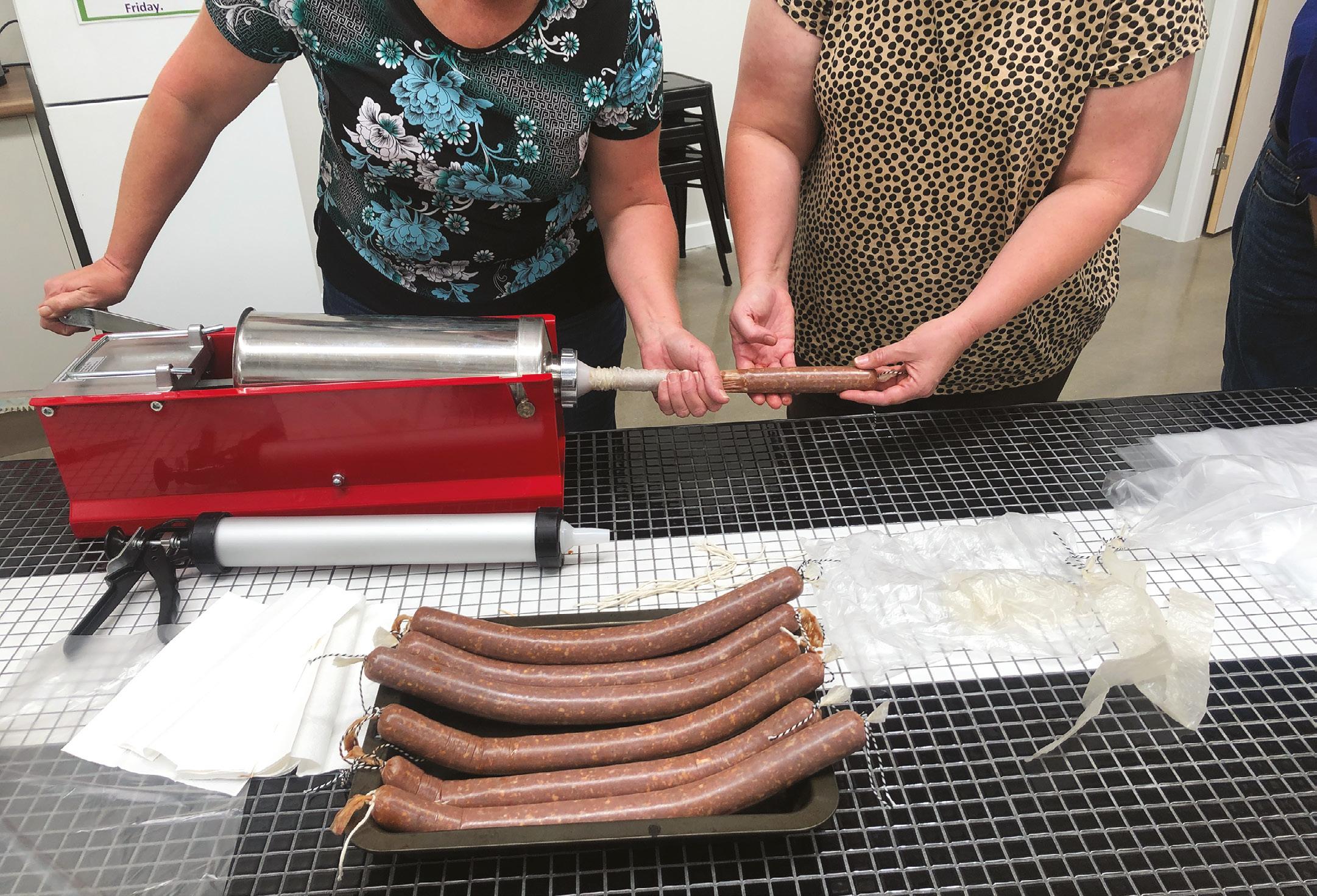
“I did a few cheese and meat platters and some beef jerky for friends, and they absolutely loved it, and I was loving making food that I grew up with,” Siggi said.
“The other main reason why we started to offer value-adding workshops for farmers was because so many people we met from regions west of Coffs Harbour wanted to learn how to make more from dairy and meat products, including from animals like deer, pigs, and goats.
“That includes how to make things like gourmet sausages and meatballs with the right herbs and spices, and our simple bacon made from pork belly has been a real hit.
“All the ingredients we use are natural. There are no preservatives or nitrates.”
COOL FARMING IN ICELAND
Siggi learned the fine arts of cheesemaking and meat curing while working on her family farm in Iceland. The farm had sheep, horses, cows and vegetables and produced enough food to feed family and friends throughout the year.
“It was a very busy time from late March through to September on the farm in Iceland. We worked 12 to 14 hours a day to get everything done before winter,” Siggi said.
REVIVING TRADITION
Above: Siggi learned the art of sausage making and meat curing on her family farm in Iceland, and teaches these skills to farmers and regional community members.
“You make everything on the farm during that time. That includes all your cheeses, cured meats, jams, preserving vegetables and making liver and blood pudding. Winter in Iceland is the time to feast, drink and party.”
Iceland is about as far away from Australia as you get, both in terms of distance and types of farming systems. We do, however, share a love of sheep meat and wool. Up until the 1980s, Iceland’s sheep population was more than three times that of the country’s 230,775 residents, with lamb being the most popular red meat. Today, the sheep-to-human ratio has reduced to 1:1, with 368,600 sheep remaining on the island.
Siggi says Icelandic sheep are well-adapted to the country’s harsh conditions as they are direct descendants of the sheep brought in by early Viking settlers.
“The lambs are almost always all born in May when the saudburdur (lambing) starts. This is a very exciting time for all the farmers, and they get help from friends and family.”
The sheep graze on the mountainous pastures during the short summer months and are kept indoors during the winter and fed on preserved grass.
“Iceland is not big on beef, because of the challenges of having them indoors for up to six months
BUSINESS VIKING HERITAGE
34 THE FARMER MAY-JUNE 2024

of the year. There are some goats and pigs, and horse meat is also consumed in Iceland,” she says.
Siggi was astounded at the amount of meat and offal that was not preserved when farmers in northern NSW told her how they broke down a carcase on farm.
“Some farmers I have met during the workshops did not know what to do with the rest of the carcase once all the traditional cuts are made besides feeding it to the dogs. I could not believe it,” Siggi said.
“When it comes to meat, everything is used in Iceland. I have been able to show farmers here how to get more value out of the carcase through using much more of it and value-adding.
“We have also helped a farmer out in Lismore who wanted to do something with the deer on his property. We taught him about the right ratios of salt and other ingredients to cure deer meat and he is now making salami.”
Siggi said much of the traditional farming and food preservation methods remain to this day in Iceland, but greenhouse technology has modernised and diversified the small agriculture sector.
Iceland’s abundant geothermal energy is powering these greenhouses, providing the heat to extend growing seasons and create favourable conditions for crops such as tomatoes, cucumbers, and capsicums.
“Just about everything is grown in Iceland now.

VIKING CHEESE PLEASE!
Siggi and Gustaf’s mission to educate farmers extends beyond the fields, as they pivot from in-person workshops to video training sessions, bringing the spirit of Norse entrepreneurship to regional communities across NSW.
“The people we have met in these small communities out west are such special people. They really stick together, and they are so grateful to us for coming out. It has been so enjoyable.”
They even have tropical crops like bananas and coffee grown in greenhouses,” Siggi said.
VIDEO PIVOT FOR VIKING KITCHEN FOOD TRAINING Gustaf said teaching value-adding and business opportunities to hundreds of farmers and other people in regional towns had been a privilege for a former Icelandic fisherman.
“The people we have met in these small communities out west are such special people. They really stick together, and they are so grateful to us for coming out. It has been so enjoyable,” Gustaf said.
“We held a lot of the workshops in community schools and halls, which were amazing places to get to. The schools got a financial benefit out of it too, and a lot of farmers are connected to these schools.
“It was very sad times for us when the COVID pandemic put a halt to our face-to-face workshops and travelling to these wonderful communities.”
The couple were determined to continue teaching their Viking Kitchen food preparation and business acumen to farmers, so Gustaf put his multimedia skills into transforming the workshops into video content. The couple now sell the video training sessions as part of small business package, which also includes all the required herbs and spices, recipes, promotional materials to use at markets and business management tools.
“Australia does have the best food in the world. Our workshops are about getting the best value out of that food for a farm business or someone that wants to start a new business,” Gustaf said.
Head to vikingkitchenfood.com.au for more information on the Viking Kitchen Food workshops and small business packages. l
–GUSTAF RAGNARSSON 35 MAY-JUNE 2024 THE FARMER

Taking the high road
How one man’s vision for creating the finest premium lamb meat is transforming Australia’s sheep meat farming industry.
–
Words SUSAN GOUGH HENLY
36 THE FARMER MAY-JUNE 2024
BEST OF THE BEST LAMBPRO is Australia’s largest prime lamb seedstock business.

Tom Bull, founder of LAMBPRO, is not your ordinary Australian sheep farmer. For a start, he doesn’t even focus on merinos, but he’s been on a mission for quite some time to produce the world’s tastiest lamb chop.
While he personally does not like the term, his breeding initiatives have created what has been called ‘The Wagyu of Lamb’ for its significant marbling, and his sophisticated marketing of this premium product has tapped into high-value export markets.
LAMBPRO is Australia’s largest prime lamb seedstock business providing genetics to more than 350 lamb producing businesses around the country. More than 1.2 million lambs will be produced this year from LAMBPRO genetics.
LAMBPRO’s Primeline Maternal has built a reputation as the largest supplier of maternal genetics to the Australian lamb industry, while the terminal sire program is focused on producing different levels of marbling depending on varying market requirements.
For these trailblazing innovations, he and his wife Phoebe were awarded The Weekly Times Farmer of the Year in 2018.
FROM THE BEGINNING
Tom, 47, grew up on a sheep property in Holbrook. After senior school years at Scots College in Sydney, he studied farm management at Orange Agricultural College, now part of Charles Sturt University, and afterwards went jackarooing before a stint working in abattoirs.
“Working in abattoirs was really grounding because I learned about lamb literally from the inside out. So many people only understand one part of the lamb industry, but I’ve been involved in all elements from production and processing to marketing, retailing, and exporting,” says Tom.
When Tom came home to Holbrook in 2001, his father had sold the family farm down to 90 acres. He married his college sweetheart, Phoebe, originally from the Hunter Valley, who came back from London to help him.
With the help of his father, Tom and Phoebe purchased their first farm and since then have bought four adjoining properties. The business now runs 11,000 ewes on 4500 acres and is focused on a triple bottom line accounting framework that delivers financial, environmental and social-animal welfare benefits.
LAMB GENETICS
But it was never going to be just about sheep farming. The core of the business is lamb genetics.
“I’ve always been fascinated by sheep and started breeding sheep as a teenager. It’s been a life-long passion,” Tom says. “My goal is all about reducing the cost of production and maximising carcase returns.”
So, how did he go about solving this equation?
“The biggest thing we did was look at the end product and then worked backwards to production,” he explains. “We take an evolutionary approach to breeding and measure heaps of stuff.”
LAMBPRO’s motto is very simple: ‘identify and multiply’. They identify sheep that will increase >

TRADE LAMB
A
EWE-NIQUE APPROACH
READ IT ONLINE 37 MAY-JUNE 2024 THE FARMER
Above: Tom Bull’s innovative approach to sheep farming has transformed LAMBPRO into Australia’s leading prime lamb seedstock business
kilograms per hectare through productivity and dollars per kilogram through carcase quality and then multiply them through their various breeding programs.
By measuring production traits in their seedstock when run in commercial environments, they cull sheep with weak constitutions and select ewes with strong mothering abilities that tend to produce twins as well as selecting breeds that don’t need drenching or mulesing. Marbling qualities are based on the capture of accurate carcase data, which has been collected in partnership with the University of New England over the past decade. The loins are removed from the processing plant and tested for marbling and tenderness.
“Our approach is not traditional, many of our sheep are hybrid, and the focus is on performance not purity. While not mainstream, our sheep hold many Australian sales records,” Tom says. “We have been a leading driver of productivity gains in the Australian lamb industry over the past two decades. Our future is focused on increasing the profitability of our sheep ensuring our client base is at the forefront of production and profitability.
“All our LAMBPRO breeding programs are based on a specialist self-replacing meat sheep program which doesn’t rely on the merino population,” explains Tom. “Merinos do not have a high productive rate. Our lamb survival rate has increased 10 per cent in the last 10 years.”
BREEDING PROGRAMS
There are five main breeding programs. The Primeline Maternal breeding program is the bread and butter of the business.
“When we commenced this program, our aim was to develop the ‘Angus cow’ of the lamb industry with a breeding objective based on reducing the cost of production through improved fertility, rapid growth, milk production and cost traits (worms, dags) and on improving the product quality with high marbling and tenderness,” Tom says.
The Primeline Shedders breeding program has the same breeding objectives as Primeline Maternal, but the sheep have been bred to shed wool.
Dorsets are primarily crossed with Merino ewes for both the Primeline maternal and shedders breeding programs.
The Poll Dorset terminal sire breeding program is focused on high marbling, high muscled animals targeted toward high-end domestic and export markets.
The Tradie terminal sire breeding program is a specialist Dorset/Hampshire Down breeding program targeted traditionally on the domestic market but now is focused on the high-end USA market.
The Hampshire Down terminal sire breeding program focuses on highly marbled meat for premium markets.
“The Hampshire Down breed had some outliers for marbling which we found very exciting. Carcase measurement has continued to progress this trait,” Tom says.
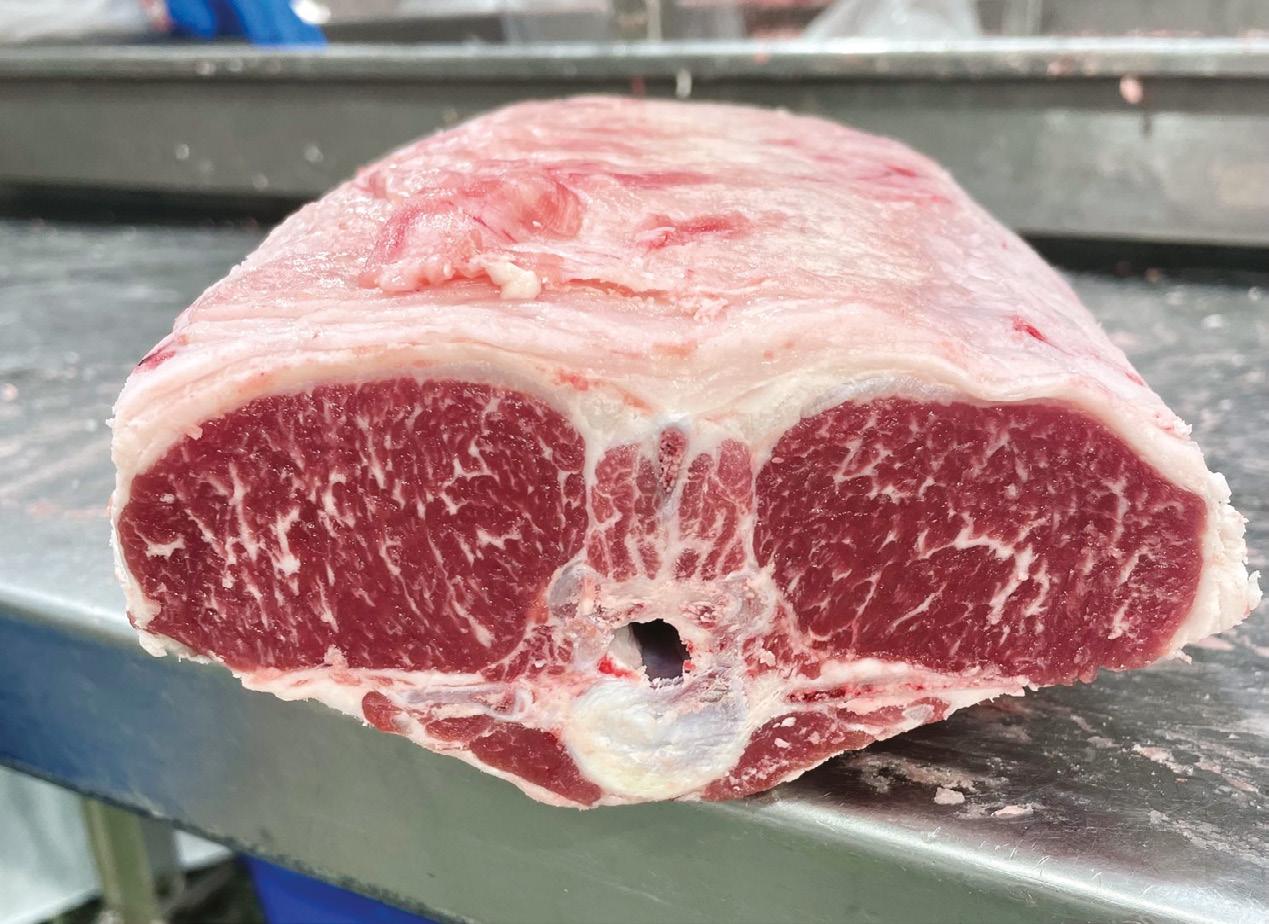


“When we commenced this program, our aim was to develop the ‘Angus cow’ of the lamb industry with a breeding objective based on reducing the cost of production through improved fertility, rapid growth, milk production and cost traits (worms, dags) and on improving the product quality with high marbling and tenderness.”
–TOM BULL
Founder of LAMBPRO
TRADE LAMB
38 THE FARMER MAY-JUNE 2024

“While all our breeds have similar levels of intramuscular fat, the Hampshire Down program has been found to have the highest marbling. The best line we have processed has averaged 7.4 per cent.”
PREMIUM MARKETS
“We have been involved in large scale consumer testing which highlighted the impact of marbling on eating quality,” Tom says. “Primarily, the aim was to understand the traits that consumers enjoy and then produce the genetics that enable this with the aim of offering a consistent product at retail and food service.”
In addition to their intense genetics program, they also feed lambs barley and lupines in small paddocks for 40 days at their Willow Bend property and for 60-70 days at Kinross Station.
Tom and Phoebe are expanding their access to high value export markets.
“We’ve seen the success of marketing beef wagyu and we’re applying it to the lamb industry,” Tom says. Through its associated premium lamb brands Willow Bend and Kinross Station (which are supplied
FROM PASTURE TO PLATE
Above: Through brands like Willow Bend and Kinross Station, LAMBPRO delivers wagyu-quality, highly marbled lamb to global markets, setting new standards for excellence and premiumisation in the Australian lamb industry.
by their clients), LAMBPRO is now a global lamb market leader, exporting lambs to ten countries through a joint venture with Endeavour Meats.
Kinross Station is a specifically Hampshire Down brand which is targeted towards the Asian markets, including Singapore, Malaysia, Japan, China, the Maldives, and the Middle East.
Willow Bend focuses on all the other breeds as well as the Primeline Maternal, Dorset and Tradie breeding programs for clients’ progeny. It is targeted specifically for the US market and more recently Japan.
All in all, not only has LAMBPRO been a leading driver of productivity gains in the Australian lamb industry over the past two decades but also has forged a path for farmers to be rewarded with significant premiums for producing Wagyu-quality, highly marbled lamb.
“Australian lamb has lagged behind beef in targeting premium markets. By strictly controlling genetics and nutrition, lamb meat producers have the possibility of adding significant value to the industry,” Tom says. l
39 MAY-JUNE 2024 THE FARMER
DINGO DYNAMICS
UNSW collaborates with Taronga Conservation Society and the Dingo Sanctuary to delve into the chemical cues of dingo urine, revealing how these signals shape dingo behaviour in the wild.

How dingo urine could assist in dingo management plans
According to new research, a study of dingo urine could support future species management strategies.
–Words MATILDA MEIKLE
READ IT ONLINE 40 THE FARMER MAY-JUNE 2024
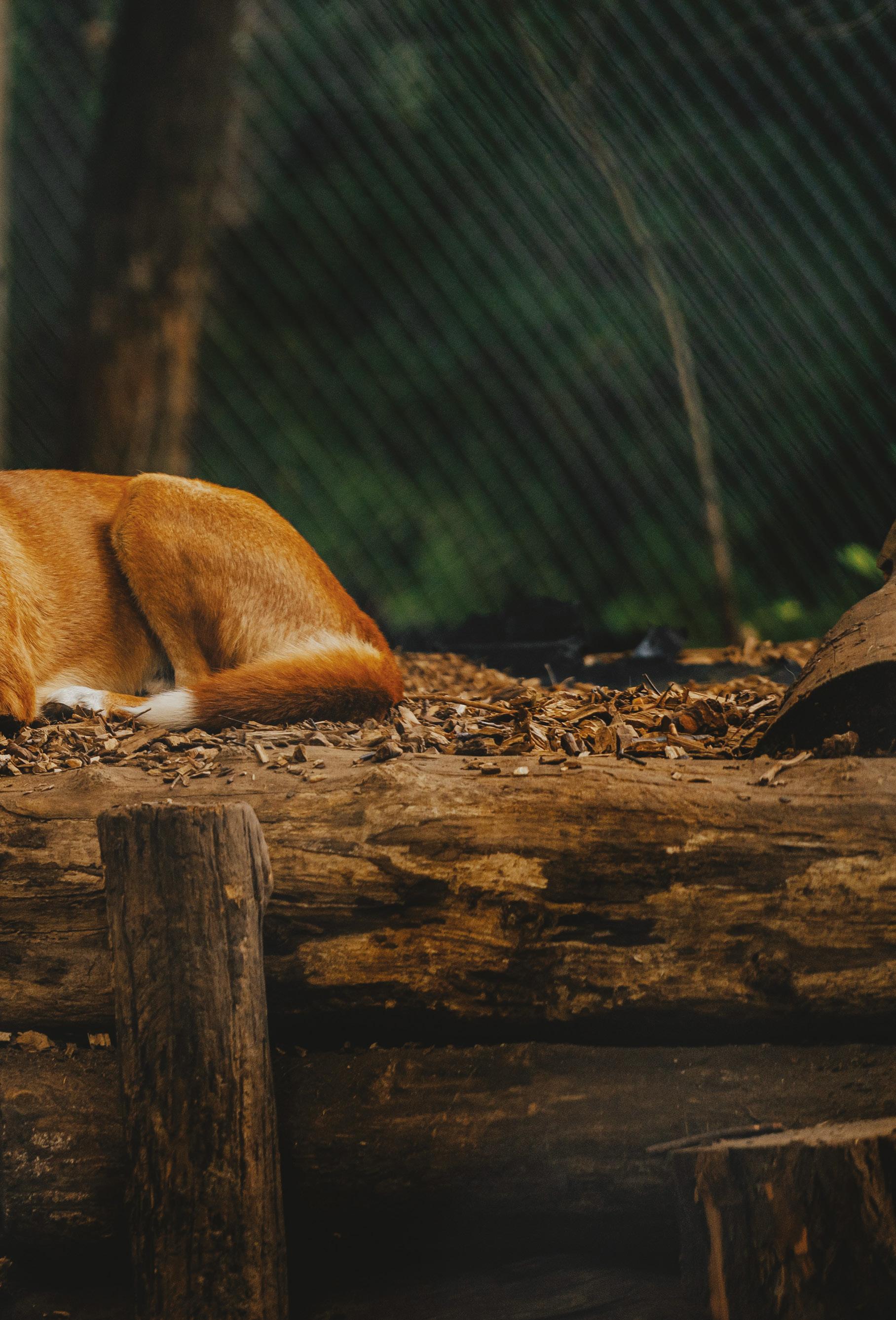
Recently, UNSW teamed up with Taronga Conservation Society and the Dingo Sanctuary and Research Centre to study the chemical makeup of dingo urine. The subsequent article, released in the Chemical Senses journal, revealed patterns of behaviour in dingo populations as a response to the scent of dingo urine.
According to lead researcher and UNSW PhD student Ben Walker, “the major finding of this study is that urine from an adult male dingo in his prime seems to have an immediate effect on dingoes who smell it in the wild.
“Dingoes respond faster and more strongly to urine from prime-age males than to scent from dingoes that were younger or older than their prime,” Ben says. And the other effect we noticed was they didn’t really want to come back for two or three days.”
In order to complete the research, experts split the dingoes into three groups: dingoes in their prime (aged 5-9), younger dingoes (3-5) and older dingoes (10 plus).
A STUDY IN YELLOW
In total, the investigation included 30 urine samples from 13 different captive adult male dingoes.
Manager of the Dingo Discovery Sanctuary and Research Centre, Lyn Watson, led the team collecting the samples. “Getting the urine of dingoes is a unique skill,” she explains.
“But having spent 39 years working with dingoes and seeing how they respond to alpha dingo scent makes me very hopeful that a product will emerge from this which will help farmers.
“The territorial instinct of dingoes is even stronger than the breeding instinct, so this scent has meaning in the Australian landscape, mostly to other dingoes who will always respect the alpha male.”
Researchers were able to identify 107 chemical components in the dingo urine samples, 33 of which were consistent among the entire group. >
“Dingoes respond faster and more strongly to urine from prime-age males than to scent from dingoes that were younger or older than their prime.”
–BEN WALKER UNSW PhD student
ENVIRONMENT DINGO MANAGEMENT
41 MAY-JUNE 2024 THE FARMER


THE SCENT OF STATUS
Above: From the study’s results, scientists believe that dingoes could be deterred from campsites and livestock paddocks using urine. This nonlethal management strategy could reduce the need for widespread removal, preserving ecosystems as well as preventing damage to livestock.
DESERT DISCOVERIES
The aim of analysing the urine samples was to identify the individual chemicals responsible for ‘signalling’ status to other dingoes. Using these chemicals, the researchers could then test whether dingoes responded differently to a variety of dingo urines.
To achieve this, the urine was frozen and transported to Strzelecki Desert, where it was placed beneath posts and monitored via remote camera-traps.
“Combining chemical analysis with behavioural experiments in the wild is an unusual but crucial approach,” Ben says. “The logistics of bringing the samples in a fridge for two and a half days on a trip to the desert makes it a lot more difficult.”
On analysis of the footage, the team found that male dingoes in their prime exhibited the largest response to the samples, suggesting dingo status was communicated through their urine. The dingoes also showed signs of determining when the urine was deposited.
42 THE FARMER MAY-JUNE 2024

Interestingly, before depositing the samples, researchers exposed them to either one, four or 33 days in the sun. Despite varied exposure, all samples still released a strong chemical signal.
A NEW WAY FORWARD
Co-author of the paper, Dr Neil Jordan, believes this revelation will help with future non-lethal management strategies.
“Dingoes have important ecological roles, provide economic benefits, and have significant cultural value particularly to Indigenous groups,” he says. “Non-lethal tools that focus on localised deterrence of dingoes rather than their wholescale removal would be very valuable, and this study may be a small step in that direction.”
Neil says getting a shortlist of key chemical components that ‘signal’ status is a big step in narrowing the field of research. “While this might not be the ultimate solution, it’s part of a serious effort to work a bit more with animals and their ecology rather than against them.”
According to the Queensland Environment Department, dingoes are able to keep systems and food chains in balance by acting as predators in their environment. They also hunt some species of feral animals, assisting in the survival of native species.
In fact, in 2021 UNSW published a study highlighting the damaging effects of dingo removal.
“Dingoes have important ecological roles, provide economic benefits, and have significant cultural value particularly to Indigenous groups.”
–
DR NEIL JORDAN Study Co-author
Using 32 years’ worth of satellite images of both sides of the Dingo Fence in the Strzelecki Desert, they found that vegetation inside the fence – the area without dingoes – exhibited poorer long-term growth than vegetation in the area with dingoes.
When dingoes are removed, kangaroo populations increase, often leading to overgrazing which in turn limits vegetation and damages soil integrity. Less vegetation can also impact the survival of smaller animals.
Employing the newfound knowledge, Neil believes that dingoes could be deterred from campsites and livestock paddocks using urine. This would reduce the need for widespread removal and help to preserve Australian ecosystems. l
ENVIRONMENT DINGO MANAGEMENT
43 MAY-JUNE 2024 THE FARMER
Dingoes can cause disastrous damage to livestock. Image: Chris Thomas.

RUMINATING ON THE FUTURE
Australian farmers have developed a farmer-led online carbon emissions calculator, empowering producers to track and validate on-farm climate action throughout the supply chain.
–Words SUSAN GOUGH HENLY
READ IT ONLINE 44 THE FARMER MAY-JUNE 2024

There’s been a lot of talk over the past few years about the need for farmers to reduce their carbon footprint but not a lot of practical tools to help them do so.
Enter Ruminati. This farmer-led initiative has teamed up with climate scientists, farm data professionals and software engineers to help Australia’s agricultural industry meet its goal of becoming carbon neutral by 2030, one farm at a time.
Beef cattle farmers Bobby Miller and Will Onus from the Gundagai area had a watershed moment in early 2021 when they read an article comparing beef producers with coal mining in terms of the carbon emissions they produce. They saw a lot of carbon emission reduction target-setting bandied about at the government and industry level, but not much was being done to help farmers use their existing farm data to establish their baseline and plot a path towards emissions reduction.
“That’s a big bottleneck,” Miller explains. “As soon as we saw the problem, we couldn’t really unsee it. So, we decided to set up a company in late 2021 and put together a multi-skilled collaborative team to address what is essentially a data problem.”
First, they approached the University of Melbourne’s Professor of Sustainable Agriculture Richard Eckard, who created the admittedly rather complicated greenhouse accounting framework (GAF) for a broad range of farms.
Next, they contacted John Francis of Agrista, a company that has a background in farm data analytics, and asked him to help them simplify the GAF while retaining its accuracy.
They then employed software design group, Nakatomi, to create an online version that would be simple and easy for farmers to fill out.
Finally, they brought on strategic advisor Peter Leihn who has extensive expertise in technology commercialisation, to become Ruminati’s CEO to help lead the company in its expansion phase.
Ruminati launched its baseline management tool in April 2023.
“We believe that the push-pull dynamic of this collaborative approach has enabled us to build a stronger, more effective, user-friendly platform for farmers to use. We’ve placed strong emphasis on farmer knowledge and perspective, accurate farm data that is fully secure, and digital ease of use,” Miller says. “We go above and beyond the codes and frameworks listed in data privacy and security as it’s the life blood of our business. Farmers’ input data stays in their private account. It isn’t shared or monetised in any way. The emissions data that our system generates is shared but only after the farmer explicitly agrees to do so and it can be withdrawn at any time.
“Offering farms a baseline calculator tool is all good and well and it should be free. sBut there’s no business model here. So, we’ve added products, such >
ENVIRONMENT CARBON COUNTING
45 MAY-JUNE 2024 THE FARMER


as the ability to calculate emissions intensity and plan reductions via bespoke models as well as a baseline tool for feedlots and processors.”
THOUGHTS BEHIND THE SCENES
“There are numerous agricultural baseline accounting tools available right now, including the late February beta launch of the non-profit Agricultural Innovation Australia’s (AIA) Environmental Accounting Platform (EAP), an online carbon calculation engine for Australia’s agriculture, fisheries and forestry sectors,” Eckard explains. “I’m a technical consultant on this project. It’s a free, digitised, accessible and standardised platform to calculate carbon footprints at a commodity, enterprise and whole of business level and can be used by farmers, supply chain participants, agribusiness, and financial institutions.
“But none are offering the commercial services to help farmers reduce their carbon emissions like Ruminati is,” he says. “They’ve done their homework. Ruminati’s special advantage is that after a baseline is established, it gives farmers a range of options to consider as a way to move forward to reduce their emissions.”

THE RUMINATI APPROACH
Top to bottom: The easy-to-use Ruminati interface; Will Onus and Bobby Miller, beef cattle farmers and co-founders of Ruminati.
Bobby Miller of Ruminati, in effect, concurs. He says that 99 per cent of farmers have not done their baseline reporting because up until now it’s simply been too onerous. He believes that if pressure is put on farmers to do reams of paperwork for a completely traceable auditable baseline – they won’t do it. Ruminati has developed an excellent facsimile to help farmers easily establish their baseline by using their existing farm data.
Ruminati is still in its pilot phase and has developed partnerships with supply chain members, such as McDonalds, as well as the CBA and livestock finance provider, StockCo. This is a rapidly evolving space.
“We’re exploring what a continual working relationship might look like based on what the supply chain wants and what we can provide,” he says. “It’s conceivable that Ruminati will move forward in a consulting capacity to these businesses.
“Ruminati’s special advantage is that after a baseline is established, it gives farmers a range of options to consider as a way to move forward to reduce their emissions.”
–RICHARD ECKARD Professor of Sustainable Agriculture, University of Melbourne
ENVIRONMENT CARBON COUNTING
46 THE FARMER MAY-JUNE 2024

“We need the supply chain to be on board before we sell the larger concept to farmers. We have to get the value proposition right for them. These are all emerging markets, and everything is a bit up in the air, but we believe it’s good to give farmers literacy about their carbon emissions.”
Moree-based cropper and NSW Farmers Board member, Oscar Pearse, says that Ruminati has a number of advantages for farmers over other data management systems. But for any farmers considering an emissions reporting tool like Ruminati, understanding commercial and regulatory frameworks is key.
“While these aspects demand ongoing advocacy work, the fact that Ruminati gives farmers a safe and secure way to report, and a tool which can adapt as rule improvements come in, makes them an ideal choice,” Pearse says. “And on the plus side, in the process of making their first annual report, farmers might discover some easy improvements to make that will both reduce their emissions and increase farm profitability.”
Miller agrees. “We’re seeing farms that are implementing tactics to lower emissions are also showing higher efficiencies and productivity. Healthier soil, better water retention, lower methane emissions also equate with better feed efficiency, higher fertility rates, and higher turnoff.” l
NSW Farmers committees have been discussing aspects including:
1
Farmers must understand how their data is treated and control its exchange. Baseline reporting tools require farmers to map their farm and it’s important to ensure that these data sets are secure. Farmers should ensure that all data service providers are compliant and/or certified with the National Farmers Federation (NFF) Farm Data Code to ensure landholders control how their private data is exchanged.
2
Farmers should understand what payments or premiums banks and buyers offer before sharing data. Once farmers begin reporting their annual emissions, will supply chain partners start to demand emission reductions from a baseline point without payments or reimbursement? Will this set up targets that are impossible for farmers to meet?
BURGERS AND BASELINING
Above: A farmer onboarding field day “Burgers and Baselining” at Cooininee in Jugiong saw producers from around the region get face-to-face support for tracking and understanding their emissions, and creating future-facing emissions reduction plans.
3
State farmer organisations and other peak bodies are concerned that models based on the GAF don’t yet account for a range of beneficial farm level sequestrations, especially existing transient pasture carbon or even permanent carbon sinks offered by trees. Both the NFF and NSW Farmers continue to call for system and rule changes which ensures farmers can count and be recognised for the more accurate total picture of farm emissions.
4
Many multinational companies operating in Australia have emission reduction goals, which don’t account for the Australian agricultural context and which may simply be passing impossible demands onto farmers. State farmer organisations and other peak bodies may need to develop collective bargaining tools or codes of practice to ensure the cost burdens don’t fall on farmers.
47 MAY-JUNE 2024 THE FARMER
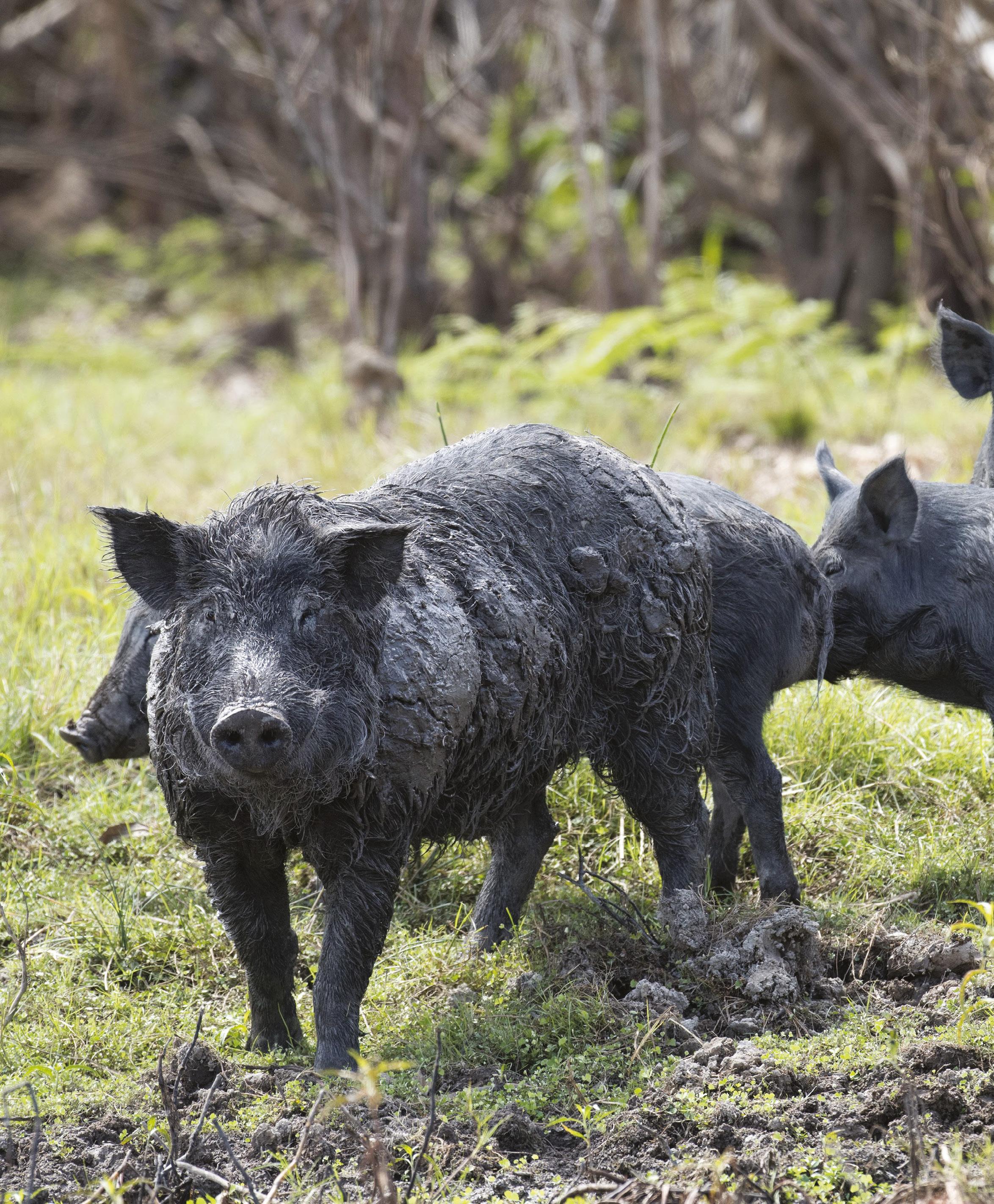
POUNCING ON THE PIG PROBLEM
Calls from NSW Farmers members for more resources to combat an explosion in feral pig numbers were heeded at last year’s Annual Conference. The State Government announced an $8 million boost for a control program that has removed almost 50,000 pigs from the landscape since October 2023.
–
READ IT ONLINE 48 THE FARMER MAY-JUNE 2024
Words MICHAEL BURT

The state’s first Feral Pig Coordinator, Bec Gray, is spearheading the charge to reach the program’s target of 87,000 feral pig kills by July this year. The coordinated assault from Local Land Services (LLS) and NSW National Parks and Wildlife Service (NPWS) began in October and boasted the culling of 33,277 feral pigs in the first four months.
Central to the program’s success has been the Feral Animal Aerial Shooting Team (FAAST), which comprises a dozen of the best LLS and NPWS shooters plus helicopter pilots and navigators.
“We’ve certainly knocked some pigs down. The figure was up to 47,703 by the end of February (check before print) and that has come from aerial control programs as well as ground control through baiting and trapping,” Bec said.
More than 41,000 of those feral pigs were taken out by the FAAST team across 21 different areas of NSW.
“The reasons why aerial control is effective is that it has the ability to get more people involved and to cover a much larger area,” she said.
“We like to support what landholders are already doing on the ground. We have been able to use the program’s funding to support local coordinated control efforts with aerial culling.
“Part of the program’s intent is to encourage more landholders to get involved in locally coordinated trapping and baiting programs. The effectiveness of the program is really dependent on that.”
The program also has three landscape control zones or hotspots for targeted aerial attacks. These zones have been prioritised based on feral pig densities, high-value agricultural production and environmental assets.
“One zone is down south and covers some of the Riverina, western and central west regions, the second is based around the Coolah region in the central west and the third zone is the north west region.”
“We like to support what landholders are already doing on the ground. We have been able to use the program’s funding to support local coordinated control efforts with aerial culling.”
–BEC GRAY NSW Feral Pig Coordinator
BIOSECURITY FERAL PIGS
49 MAY-JUNE 2024 THE FARMER
>
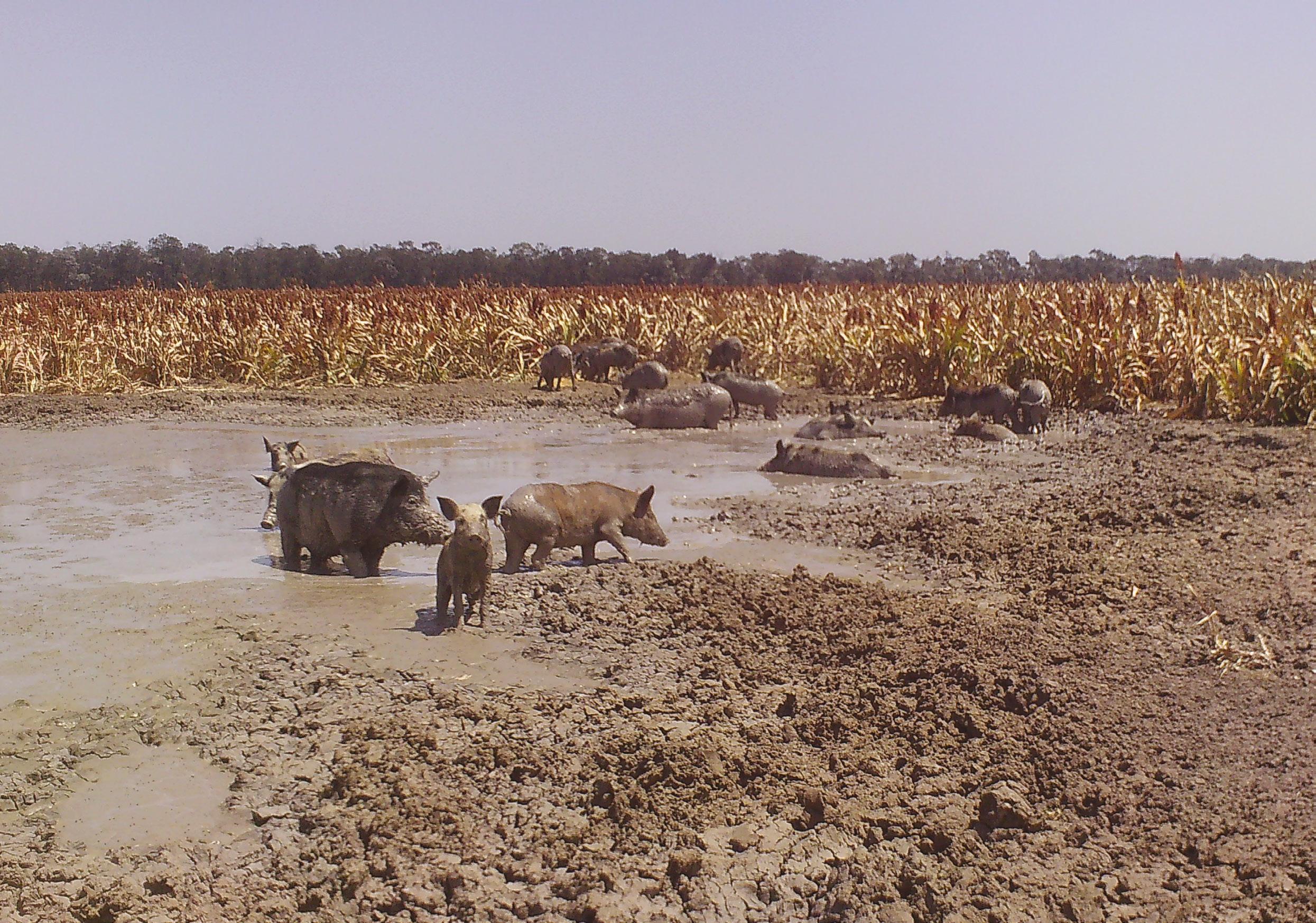
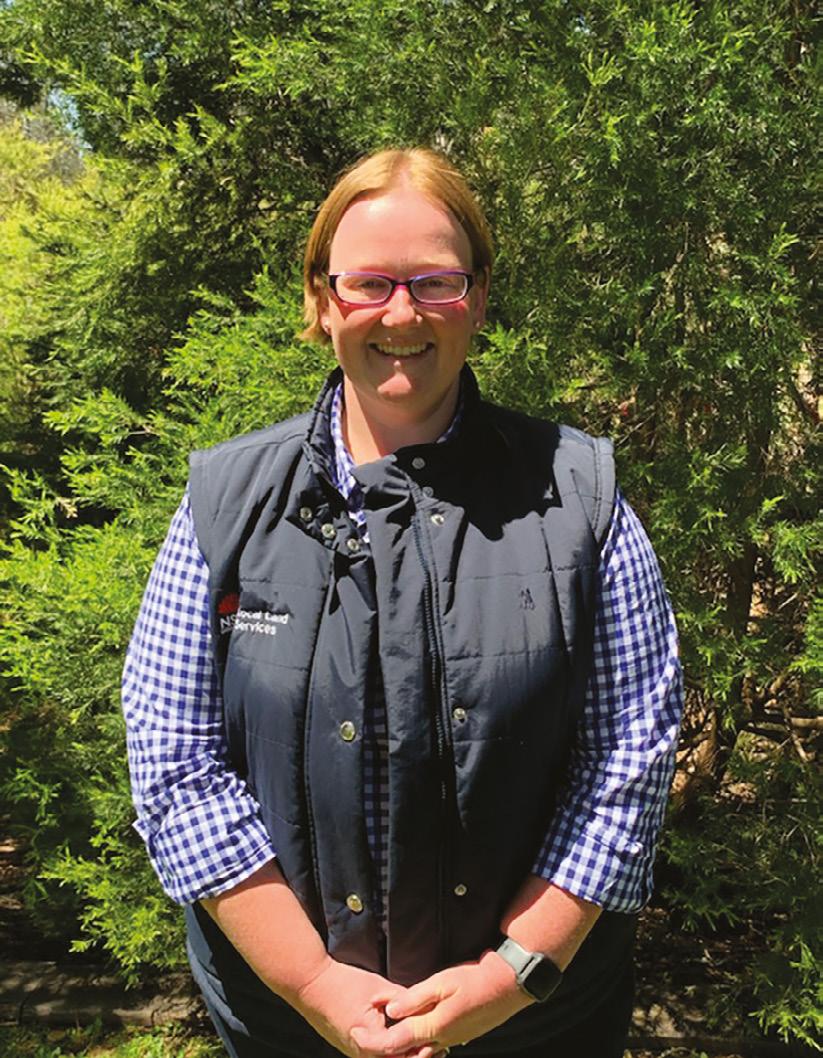
NSW’S FERAL PIG BATTLE
Bec Gray (left), the state’s inaugural Feral Pig Coordinator, leads a concerted effort to eradicate feral pig populations, aiming for 87,000 kills by July.
Bec said a further 24 aerial culling campaigns will be conducted to reach the target of 87,000 dead feral pigs.
Bumper seasonal conditions across much of NSW has at times hampered the FAAST team’s ability to hunt feral pigs from the air.
“We were expecting to it to be hot and dry and force the pigs to congregate at water points. Those favourable seasonal conditions for feral pigs continued though and that threw our plans out a little bit, but that’s where landholder participation in the program is so important.
“The increased control effort through the program is protecting agricultural crops and livestock. It’s also about protecting the environment as feral pigs are a key threat for 146 different species, and I have seen what they can do to pristine rainforest environments.”
Bec is based in Tamworth and came to the role with 12 years of biosecurity experience at the LLS working with farmers to manage feral pigs and other pest animals.
“The bulk of my previous biosecurity work with the LLS was in the Walgett and Moree areas, which
50 THE FARMER MAY-JUNE 2024

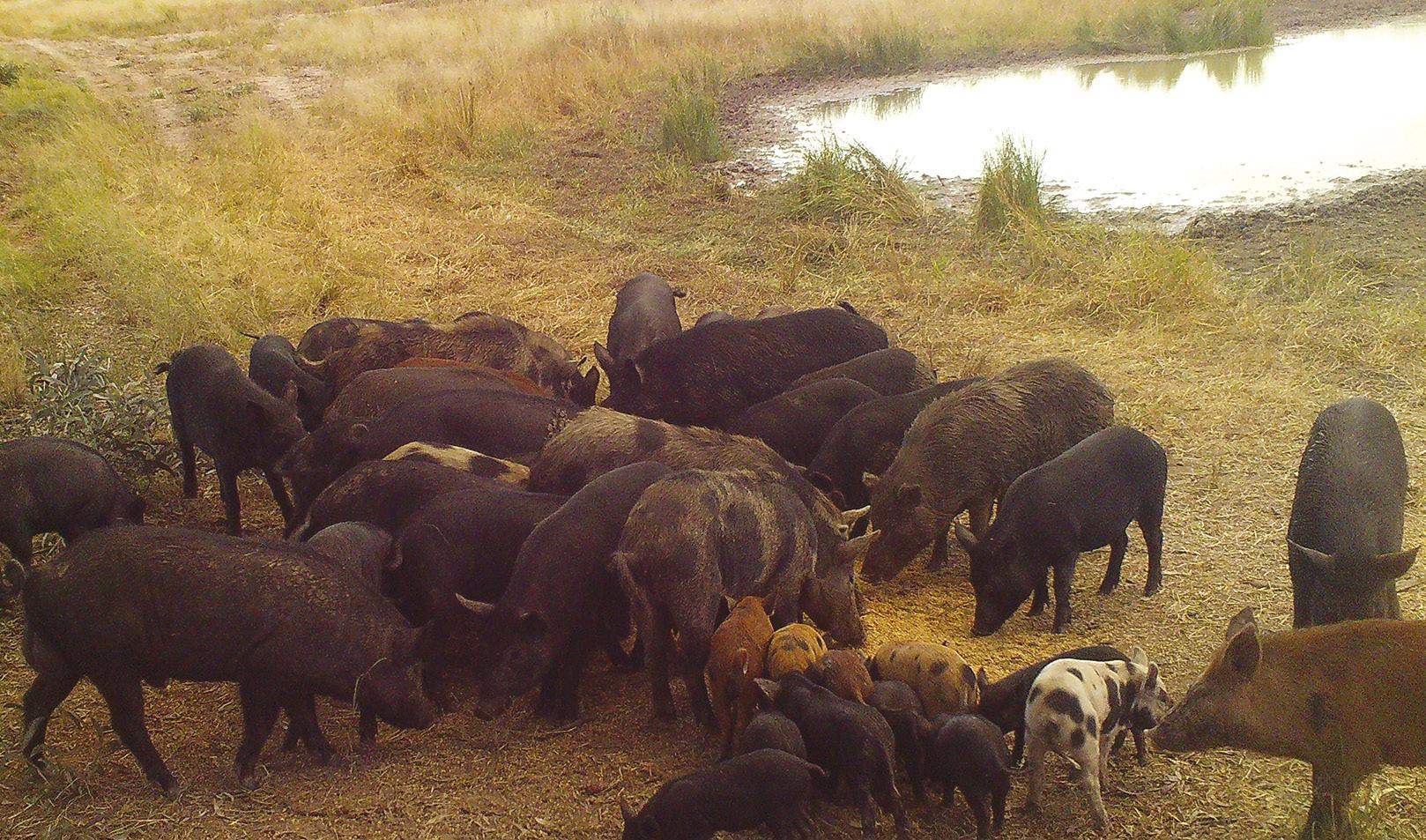
were subject to feral pig damage to crops and the environment. That meant working with landholders on feral pig management was a big part of the role.”
Bec said feral pigs can do enormous damage to a wide range of crops and warned farmers about their impact on pending winter crop plantings like chickpeas.
“Chickpeas will often get hit by pigs at planting. They pretty much come in behind the plant and dig up the seed, causing a huge amount of damage quickly.”
The NSW Government’s spend on control of feral pig populations will total $13 million in the 2023-24 financial year. The one-year Feral Pig Program also includes training events for farmers and covers the cost of treating grain to bait feral pigs for farmers participating in the Feral Fighters program.
NSW Minister for Agriculture Tara Moriarty said more than 2000 farmers have taken part in the State Government’s Feral Pig Program and almost 80,000 kilograms of free bait has been issued.
“Farmer feedback on our investment into the Feral Pig Program has been positive,” Minister Moriarty said.
“This model has proven to be a leading approach to pest animal management, with biosecurity officers and landholders working side by side across private and public land.”
FERAL PIG GROUND ASSAULT PROTECTS LAMBS
Southern Riverina sheep farmer Colin McCrabb modernised his ground offensive on feral pigs earlier this year with remote activated trap doors, cameras and baiting stations from key ally, the Murray Local Land Service (LLS).
It has resulted in the trapping of more than 100 feral pigs on his farm in recent months and he has confidence that the pending lambing season will be safe from an invasive and menacing threat.
“However, my biggest fear with feral pigs is the biosecurity threat. They are the perfect vehicle
“This model has proven to be a leading approach to pest animal management, with biosecurity officers and landholders working side by side across private and public land.”
–
BEC GRAY
NSW Feral Pig Coordinator
TARGETED APPROACH
Identified hotspots in regions like Riverina, Coolah, and the northwest are focal points for intensive aerial campaigns. By prioritising areas with high pig densities and ecological significance, the program maximises its impact on both agricultural and environmental fronts.
for spreading diseases like foot and mouth and leptospirosis. Plus, I just hate feral pigs,” Colin said.
That loathing stems from attacks on lambs in the past on Colin’s 6900-hectare property at Wanganella, which runs two merino studs, a commercial merino flock and a herd of Shorthorn cattle.
“We have had them predating lambs during the drought, and they also got into our rice crops when we grew them back in the early 2000s.”
Colin said feral pigs had not been big on the biosecurity radar in the last decade in his region, but that all changed in the second half of 2023.
“We had a few pig traps that had not been active for a while. I happened to notice a few signs of activity one day last year and got in contact with the LLS. They sent cameras and a phone activated trap door and one of those traps has got 74 pigs since December, which blew me away.”
Another trap on the southern part of Colin’s farm has snagged another 20 pigs and more have fallen victim to strategically placed bait stations.
“We’ve got some active biosecurity officers in the Murray LLS that have been very supportive,” said Colin. “It’s been practical support from local staff that has worked.” l
BIOSECURITY FERAL PIGS
51 MAY-JUNE 2024 THE FARMER

DESTRUCTIVE FUNGAL DISEASE STRIKES NORTHERN RIVERS RICE CROPS
Rice blast outbreak sparks concern prompting urgent measures to safeguard rice production. –
Words LIBBY-JANE CHARLESTON
Adestructive fungal disease that can decimate rice crops has surfaced in northern NSW, posing a grave concern to the industry. Known as rice blast, this disease ranks as the foremost threat to rice cultivation globally.
Recently discovered in a field near Lismore, the NSW Department of Primary Industries (DPI) issued a cautionary notice to farmers on February 10. To curb its spread, growers face the grim task of destroying their crops.
The disease was found in 2011 on a rice crop in northern Western Australia and has since been detected in the Northern Territory and Queensland.
NSW DPI said it would work with the rice industry in the Northern Rivers to manage biosecurity around impacted crops – the department was also conducting surveillance and awareness within the Rice Biosecurity Zone of southern NSW to bolster the pest-free status of this region.
52 THE FARMER MAY-JUNE 2024
>

A SILENT THREAT
The discovery of rice blast, a destructive fungal disease, near Lismore has sent shockwaves through the rice industry, prompting urgent action to contain its spread.
BIOSECURITY FUNGAL OUTBREAK
READ IT ONLINE 53 MAY-JUNE 2024 THE FARMER

Rice blast symptoms include:
LEAF BLAST
Leaf lesions start as small white, grey or blue-tinged spots. Under moist conditions lesions enlarge quickly to either oval or diamond-shaped spots or to linear lesions with pointed ends, grey or white centres and narrow brown borders.
Severe infections may lead to death of leaves and whole plants. Leaf blast infections provide inoculum for panicles to become infected.
COLLAR ROT
If a rice blast lesion is located at the junction of the leaf blade and leaf sheath the entire leaf can be killed. The leaf collar lesion discolours to brown and the leaf blade dies.
NODE INFECTION
Infected nodes appear black-brown and dry. An infection at the node often results in the stem breaking.
NECK ROT
Neck rot may result in death of an entire panicle. Symptoms appear at the base of the panicle, starting at the node. The tissue turns brown and shrivels causing the stem to snap and lodge.
PANICLE BLAST
Panicles which do not break or fall off as a result of neck rot may turn white to grey. Partially infected panicles may show grey-brown lesions among the panicle branches and on the stems of florets. Florets which do not fill turn grey.
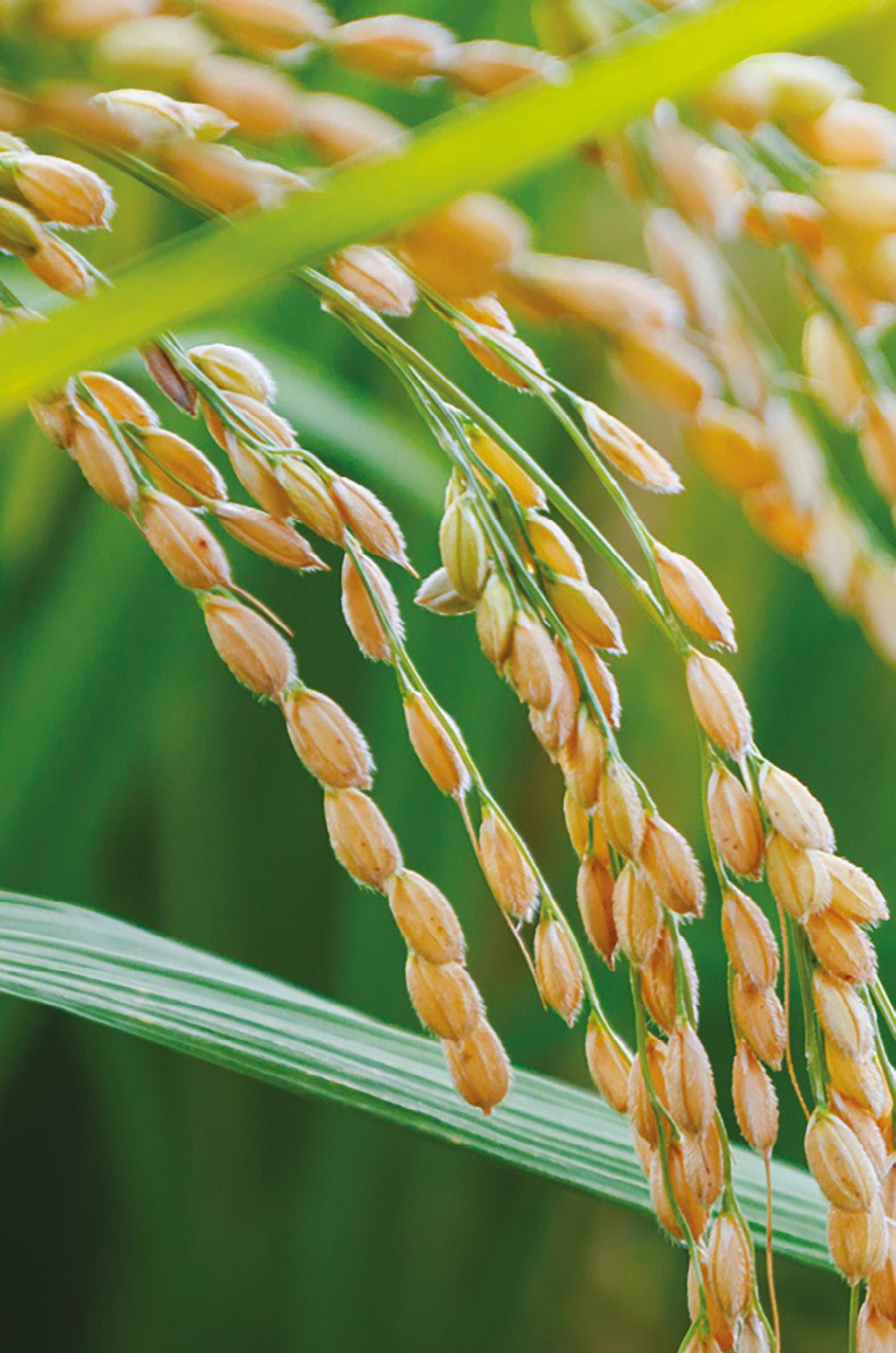
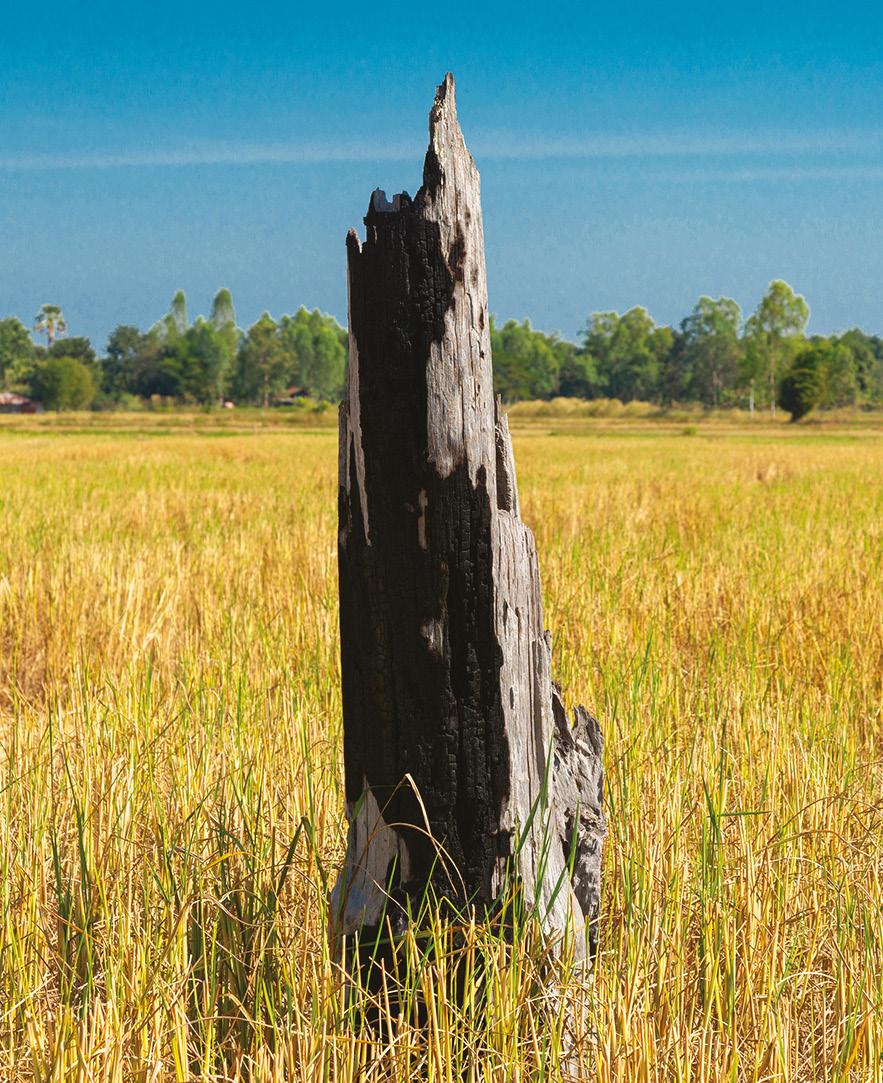
54 THE FARMER MAY-JUNE 2024


CURBING THE SPREAD
Heightened awareness, coupled with proactive biosecurity measures, offers the best defense against the advance of rice blast, safeguarding the future of Australia’s rice production.
What to do if you detect rice blast
Should rice blast be detected in your crop, NSW DPI recommends the following control options:
• Report the detection to NSW DPI as disease confirmation is key to good management.
• Treatment with fungicide such as Azoxystrobin (an off-label permit is available for treatment of rice crops in NSW – PER94571) will reduce the impact of the disease but will not eliminate all spores in crop residue and soil.
• Treatment with a knockdown spray to kill the crop followed by burning of the stubble to reduce inoculum load. It’s important to block drainage channels of the affected crop to dry it out to achieve this.
• Prevent infected grain entering into the mainstream supply chain as equipment, processing machinery and transport vehicles can become contaminated with spores.
All notifiable plant pests and diseases must be reported within one working day. Growers can report by one of the following methods: Call the Exotic Plant Pest Hotline 1800 084 881 Email biosecurity@dpi.nsw.gov.au with a clear photo and your contact details.
“Rice blast spores can be carried by wind and water, but also on clothing and machinery, which reinforces the need for good biosecurity practices.”
–
IAN MCCOLL
NSW Farmers Biosecurity Committee Chair
Ian McColl, NSW Farmers Biosecurity Committee Chair, said the disease was a serious threat and detections were a reminder of the need for strong national biosecurity controls.
“Rice blast spores can be carried by wind and water, but also on clothing and machinery, which reinforces the need for good biosecurity practices,” Mr McColl said.
“These spores can survive for more than a year in dry conditions, so we recommend boots, equipment and vehicles should be thoroughly cleaned then decontaminated if you suspect they have been in contact with an infected crop.
“Good biosecurity is everyone’s responsibility, and we would encourage people to look at this latest detection as a wake-up call. If this got into massive
production areas like the Riverina, it would have a terrible impact.”
According to NSW DPI, rice blast spores were able to infect plants at all growth stages, from seedlings to maturity. Symptoms developed on all above ground plant parts. Lesions or spots were the most common symptom. Lesions were usually 1-1.5cm long and 0.3-0.5cm wide.
Crops under stress could exacerbate symptom development leading to rapid crop decline. The disease spreads via wind borne spores, on infected plant material and grain, and in water. Under dry conditions, spores can survive for more than a year, which means transport of contaminated seed, souvenirs made of rice straw or contaminated equipment could introduce the disease into key production areas. l
BIOSECURITY FUNGAL OUTBREAK
55 MAY-JUNE 2024 THE FARMER
ELECTRIC VEHICLES FACE ROADBLOCKS IN THE BUSH
While the Australian Government is gearing up to impose low-emissions rules to encourage uptake of electric vehicles, rural communities grapple with the practicalities of making the switch.
–
Words SANDRA GODWIN
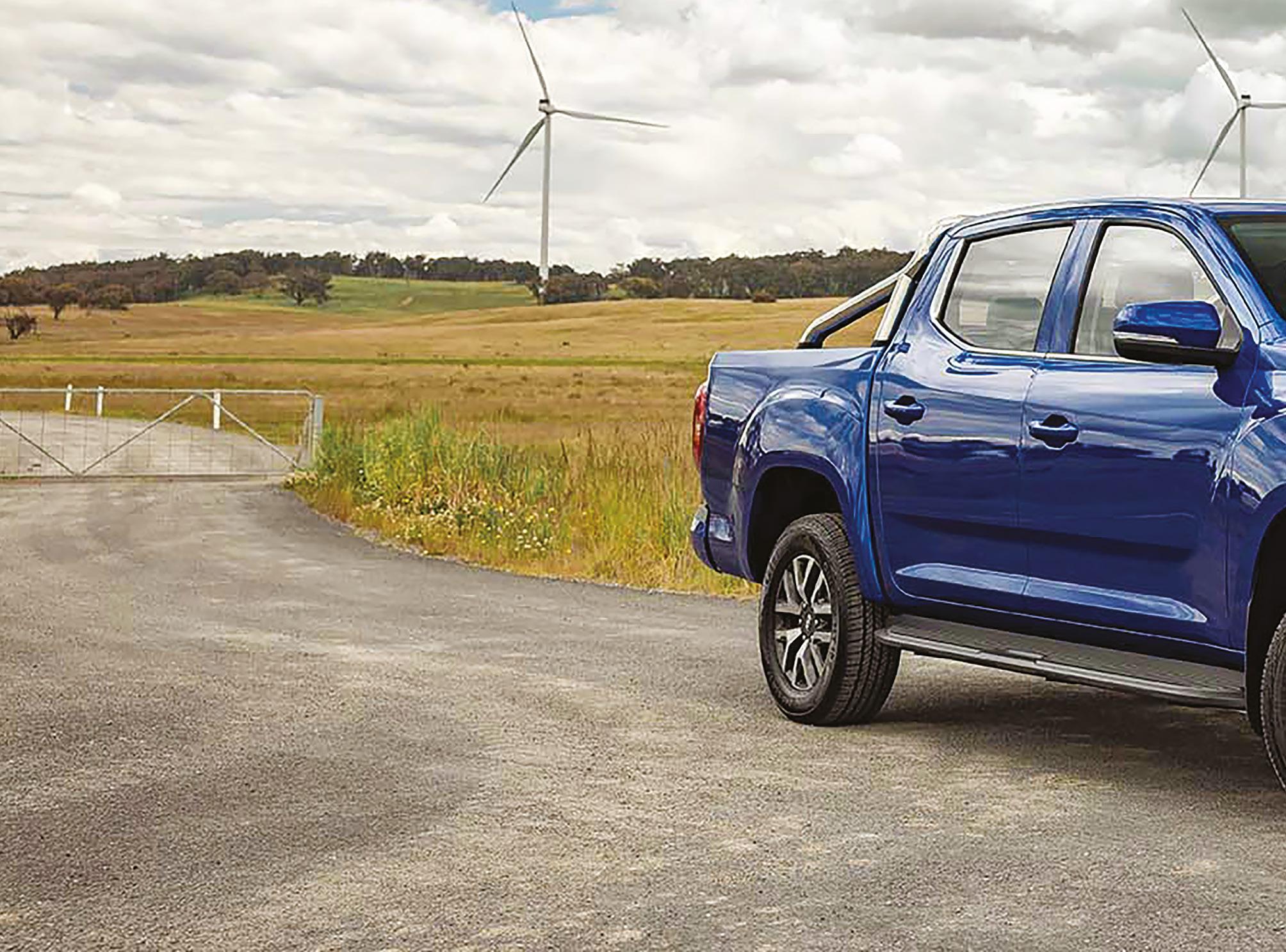
Rough roads, the risk of breakdown or crashing into wayward animals, an inadequate supply of vehicles and a dearth of fast charging stations are some of the many reasons electric vehicle uptake has been slower in regional and rural areas.
There are also concerns that the Federal Government’s New Vehicle Efficiency Scheme (NVES), due to be phased in from January 1, 2025, will inadvertently penalise people who live and work outside metropolitan areas.
While the peak body for car manufacturers, the Federal Chamber of Automotive Industries (FCAI), says it strongly supports the introduction of a fuel efficiency standard, it also has warned of price hikes of up to $13,250 for popular
diesel or petrol 4WD utes and large off-road SUVs that are essential workhorses for farmers, tradies and agribusiness.
Reg Kidd, who chairs the NSW Farmers Energy Transition Taskforce, says the federal government appears to be rushing into a one-size-fits-all approach that would disadvantage people with a genuine need for a diesel or petrol ute, or large SUV.
“They’re not really thinking about what people in rural areas tend to drive and the distances they cover,” he says.
“They’re going to be severely disadvantaged unless we get some more transparency from the government about what they’re actually talking about.”
Mr Kidd says he’d also like to see critics stop arguing that rural people do not care about the environment or were ‘backward’ for not adopting electric vehicles.
There are many reasons rural people choose a diesel or petrol 4WD single or dual cab ute for work and a Toyota Landcruiser or Prado for the family, for example. These include:
• Significant distances travelled on dirt, gravel and rough sealed roads or offroad on-farm or at construction sites
• Space for passengers and storage for tools, equipment, luggage, and large quantities of groceries
• Towing capacity for trailers or horse floats
• Sturdy reliable vehicles that can be serviced by many mechanics
• Availability of spare parts
• Strong vehicles that provide greater protection to occupants in a collision with wildlife or wayward livestock
• Large fuel tank capacity (800-1000km) and the ability to be fitted with long-range tanks
READ IT ONLINE 56 THE FARMER MAY-JUNE 2024

or carry drums or jerry cans of extra fuel
• Most towns have at least one service station where diesel or petrol vehicles can be quickly refuelled
Mr Kidd says none of the electric vehicles currently available in Australia fit the bill.
The sole electric ute, the LDV eT60, is rear wheel drive only, can tow up to one tonne and has a maximum range of 330km – which drops when fully loaded and falls further at speeds of more than 70km/h – but at more than $92,000 costs more than twice the price of the diesel LDV T60 Max Pro 4X4.
“I think it’s got to be a two-tiered approach here,” Mr Kidd says.
“The truth is they’re trying to force people out of fuel vehicles into electric vehicles, but the electric vehicles that we’re talking about? There’s none suitable for farming, or those in trades at the moment.”
Problem of practicality
The LDV eT60 electric ute is rear wheel drive only, can tow up to one tonne and has a maximum range of 330km, but at more than $92,000 costs more than twice the price of the diesel LDV T60 Max Pro 4X4.
Mr Kidd, an agricultural consultant, and former mayor of Orange, racks up a lot of time on the road. In the week he spoke to The Farmer, he travelled to Nyngan, followed by trips to Warren and Cassilis. All up, he drove more than 1300km across two days.
“Where would I top up if I had an EV, if there was one available?” he says. “And then I thought about the roads that I was on... what would happen if I broke down?
So, I think the technology has got to improve dramatically, the availability of charging spots and how rapidly you can charge also has to increase dramatically. And it will.”
There are no chargers at Warren, Narromine, Gilgandra, or Cassilis, so the same journeys to Nyngan, Warren, and Cassilis in a battery-equipped EV (BEV) would have taken Mr Kidd almost 1400km and an extra three hours or more.
>
What is the New Vehicle Efficiency Standard (NVES)?
The New Vehicle Efficiency Standard (NVES) is part of Australia’s strategy to improve supply and access to new cars that use less fuel, and reduce carbon dioxide emissions from new cars.
From January 1, 2025, car companies will be given targets for average CO₂ emissions per kilometre across their new vehicle fleets.
This CO₂ target will increase over time, forcing companies to provide vehicles with lower or zero emissions to meet stricter targets.
Companies will still be able to sell new vehicles with heavier fuel consumption, but they’ll need to offset them with more fuelefficient models.
If companies meet or beat their CO₂ target, they’ll receive credits from July 1, 2025. If they miss it, they can either trade credits with a different supplier, make it up in the following two years, or pay a penalty.
The government’s preferred option, Option B, would cut emissions from new vehicles by 60 per cent over the next five years.
Under that option, companies would be penalised $100 per gram/ kilometre over their set CO₂ target.
There would be two CO₂ caps: one for passenger vehicles and many SUVs; the other for utes and vans, which would be classified as light commercial vehicles. In response to negative polling and public campaigns, the Federal Government announced it would classify large 4WDs such as the Landcruiser, Nissan Patrol, Ford Everest and Isuzu MU-X as light commercial vehicles. Sources: Cleaner, Cheaper to Run Cars: The Australian New Vehicle Efficiency Standard Consultation Impact Analysis, Grattan Institute, CarExpert, SMH.com.au, Joint media release: Catherine King and Chris Bowen.
CURRENT AFFAIR ELECTRIC VEHICLES
57 MAY-JUNE 2024 THE FARMER
The long way home
During one week in March, NSW Farmers Energy Transition Working Group chair and agricultural consultant Reg Kidd drove about 600km from Orange to Nyngan and back, followed a few days later by a round trip of 740km to Warren, Cassilis, and home to Orange. All up he travelled more than 1330km across two days.
In an unloaded EV with a range of 330km, Mr Kidd might just make it the 300km from Orange to Nyngan where he would recharge for the return trip to Orange.
The second trip would be less straightforward in an EV because there are no chargers at Warren, Narromine, Gilgandra, or Cassilis.
After driving 150km to Dubbo, he would have to recharge, drive to Warren and back to Dubbo to recharge, then go to Cassilis, on to Mudgee to recharge and then back to Orange. This would add 55km to the journey plus the extra time for recharging which can take 45 minutes to an hour at each of the three extra stops if there’s no one already using the charger or waiting in line for it.

POSSIBILITY OF PRICE HIKES
The FCAI’s figures on the impact of an emissions standard on vehicle prices have been widely publicised since their release in February.
Liberal and Nationals politicians seized upon them, with Opposition Leader Peter Dutton claiming in a post on X (formerly Twitter) that the proposed new car and ute tax could increase the cost of “Australia’s favourite family cars by up to $25,000”.
During a later joint interview with Angus Taylor and Michaelia Cash at a Toyota dealership in Perth, Mr Dutton said people would pay $14,500 more for a Hilux under the NVES.
“If you’re living in a regional area, or if you’re living here in Perth and you’re driving out to work each day as a tradie or as a farmer, if you want a heavier vehicle with a bull bar, for example, because you’re driving late at night and you’re worried
about animals on the road, you just need a 4WD because you’re going onto a farm or into a work environment where you need a heavier vehicle. You shouldn’t be paying an extra $15,000 or $25,000 for that vehicle, as Mr Albanese is proposing,” Mr Taylor said during that interview.
The publicity caused a storm amongst FCAI members, with EV makers Tesla and Polestar resigning and Volkswagen withdrawing from the FCAI’s policymaking council in March.
Tesla also referred the FCAI to the Australian Competition and Consumer Commission, expressing concern that the FCAI had repeatedly made claims that were demonstrably false and “engaged in behaviours that are likely to mislead or deceive Australian consumers”.
ABC Fact Check investigated the Opposition’s claims, finding the NVES was not a new tax, and an FCAI spokesman told the unit that industry modelling the claims were based on did not relate to consumer prices.
The spokesman told Fact Check that FCAI modelling looked at scenarios “on penalties and credits that may apply to (car) brands” under the proposed standards.
“This is not a forecast on price impacts,” he said in an email.
“Price and how penalties/credits are carried forward will be a matter for each brand and how they are impacted under the scheme.”
Government analysis released in February found there had been little or no impact on the retail price of vehicles from the adoption of fuel efficiency regulations overseas, in places such as the United States, European Union and New Zealand.
“The intention of the NVES is to require vehicle suppliers to include more modern fuel-saving technology in the new cars sold to Australian consumers, and for suppliers to provide an increasing range of hybrid variants and EVs,” the report said.
As a nation of drivers, the report said Australians were being denied access to lowand zero-emissions technology, and new passenger cars in Australia use an average of 20 per cent more fuel than new cars in the US.
Fuel type 2021 % 2022 % 2023 % All fuels 5,438,821 5,514,589 5,607,164 ICE 5,361,309 98.50 5,407,799 98.00 5,458,646 97.35 BEV 5,286 0.10 10,623 0.19 23,112 0.41 Hybrid/PHEV 72,226 1.32 96,167 1.74 125,406 2.23 HFCEV 0 - 0 - 0Key: ICE – internal combustion engine, BEV – battery-equipped electric vehicle, Hybrid/PHEV –plug-in hybrid vehicle, HFCEV – Hydrogen fuel cell electric vehicle Source: Australian Automobile Association NSW light vehicle registrations 2021-2023 58 THE FARMER MAY-JUNE 2024
MILES TO GO
NSW motorists are gradually adopting hybrid and electric vehicles, with the proportion of vehicles registered in the state rising from 1.42 per cent in 2021 to 2.64 per cent in 2023.
Top 10 vehicle sales in NSW, 2023
Toyota Corolla 7156
Mitsubishi Outlander 7015
Mazda CX-5 6853
Hyundai i30 6465
Total vehicles sold 374,432 (+10.8%)
Source: Drive
Four of the top 10 vehicles sold in Australia last year were 4WD utes or large SUVs, as were three of the 10 most popular vehicles sold in NSW. The top two in both cases were the Toyota Hilux and Ford Ranger.
Top 10 vehicle sales in Australia, 2023
Make & Model
Australia
Ford Ranger 63,356
Toyota HiLux 61,111
Isuzu D-Max 31,202
Toyota RAV4 29,627
MG ZS 29,258
Tesla Model Y 28,769
Toyota Landcruiser 26,449
Mitsubishi Outlander 24,263
Mazda CX-5 23,083
Hyundai Tucson 21,224
Total vehicles sold 1,216,780 (+12.5%)
Source: Federal Chamber of Automotive Industries
A spokesperson for Climate Change and Energy Minister Chris Bowen says the Opposition had mounted a baseless scare campaign.

“We know utes are used differently to passenger cars. It’s why the Standard has a separate category with different targets for light commercial vehicles, accounting for the size and weight of these vehicles,” she says.
“It’s up to Peter Dutton and the Nationals to explain why they want Australian farmers locked out from making choices that could save them thousands of dollars every year in petrol.”
More fuel-efficient versions of some of Australia’s most popular cars are available overseas, including those with better internal combustion engines that use less fuel, or hybrid versions such as the Toyota Hilux Hybrid 48V and Ford Ranger Plug-in Hybrid – due in Australia next year.
The Isuzu D-Max EV is in development and Isuzu UTE Australia has asked the Federal Government to give manufacturers more time to produce lower emission vehicles, as well as reducing fines for exceeding the emissions cap, or risk brands quitting the Australian market.
“Globally, Isuzu’s transition to low- and zero-emission vehicles is underway, with the brand committed to introduce an electric ute” the brand said in a statement. “However, the reality is that due to the infancy of zeroemission technology in light commercial vehicles, it will take more time to develop zero-emission utes and large-SUVs that are both affordable and fit for the specific needs of Australians, including the ability to travel extensive distances, carry a load and tow.”
Isuzu warned car makers might have to increase vehicle prices to cover fines.
“Vehicle brands that cannot increase vehicle pricing to cover the penalties may be left with no option but to exit the Australian market,” the statement says.
Toyota Australia Vice President of Sales and Marketing Sean Hanley also says ute and large 4WD buyers will likely face price hikes under the NVES, which would punish “middle Australia”.
Mr Hanley says the proposed transition was too quick and more time was needed to make the necessary adjustments.
“It simply doesn’t recognise the technical hurdles, the lengthy time and the substantial cost that will be required to deliver commercial (battery EVs) that are practical, that are capable and, above all, are affordable,” he tells CarExpert
“Unless the final scheme is less aggressive, it will have a profound negative impact on regional and rural Australia that will reverberate throughout the Australian economy.”
Mr Kidd says everyone, especially farmers, was in favour of improving efficiency, and people would adopt it once the technology was proven and available.
“Once they see something that works, it’s efficient, and it’s effective then people go for it,” he says.
“That’s how people buy things. Some people have the wrong idea and think that these utes and the larger SUVs are luxury vehicles. To people in rural areas, they’re not – they’re workhorses and they’re essential vehicles for where they live.” l
CURRENT AFFAIR ELECTRIC VEHICLES
Make & Model NSW Toyota HiLux 17,593 Ford Ranger 17,571 Toyota RAV4 10,327 Tesla Model Y 9836 MG ZS 8441 Isuzu D-Max 8217
59 MAY-JUNE 2024 THE FARMER
NSW vehicle registrations by fuel type in 2023. Source: Australian Automobile Association.

From convict to cultivator: James Ruse’s agricultural legacy
The remarkable tale of James Ruse is one of a convict turned agricultural trailblazer, whose perseverance and innovation laid the foundation for farming in early colonial Australia.
Words SANDRA GODWIN
READ IT ONLINE
–
60 THE FARMER MAY-JUNE 2024
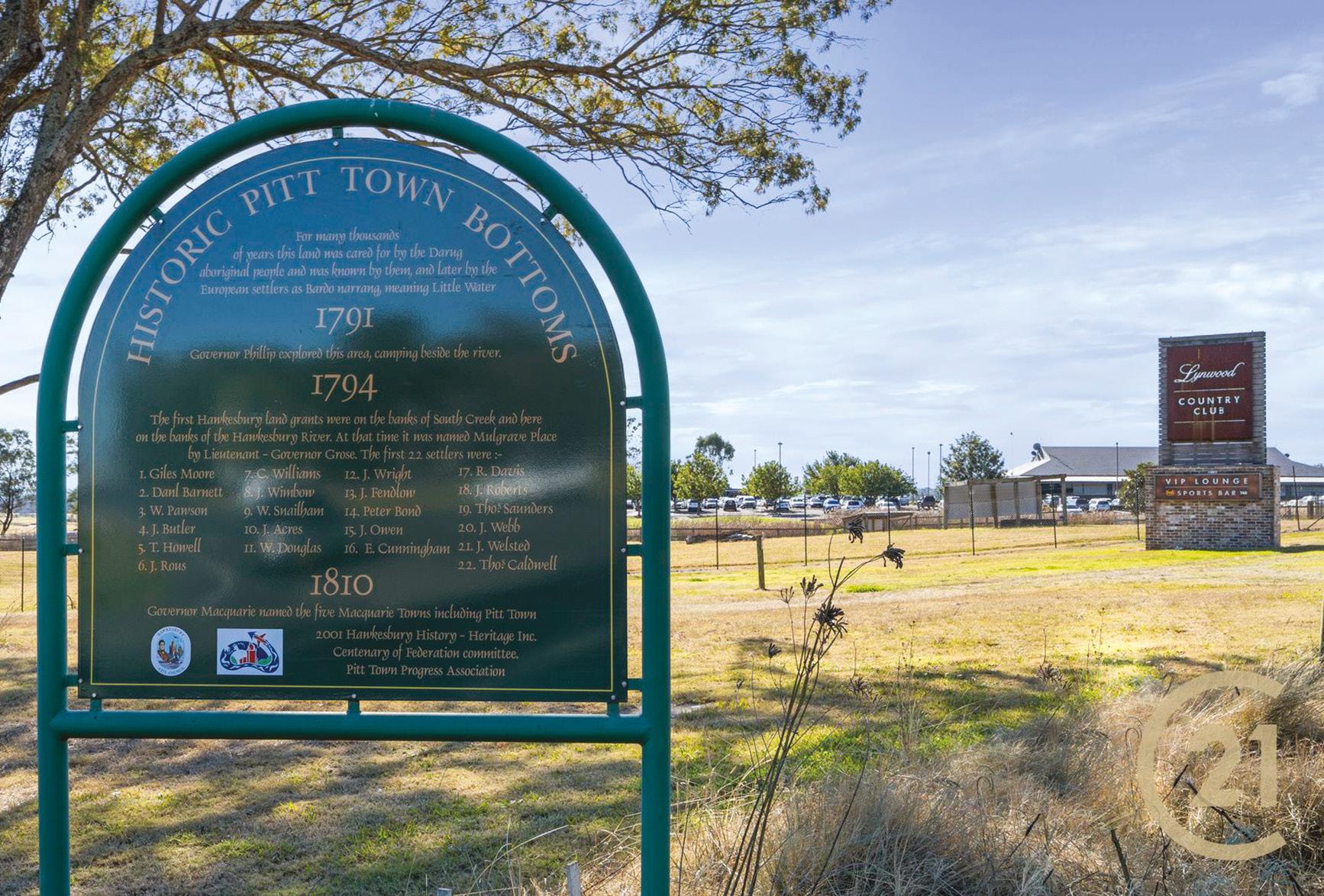
Lauded as Australia’s first successful settled farmer, James Ruse worked hard to turn his life around after arriving at Port Jackson with the First Fleet on the convict ship Scarborough.
Indeed, according to various historical accounts and biographies, Ruse notched up a long list of firsts along the way.
Ruse was reputedly the first prisoner ashore, piggybacking an officer to the beach to keep his boots dry. He later became Australia’s first settled farmer, the first ex-convict to be granted land at Parramatta and the first settler to become self-sufficient.
A farm labourer and married father of two, James Ruse was 23 when he was convicted of burglary in the Cornwall Assizes – the equivalent of the NSW Supreme Court – and sentenced to death by hanging. This was commuted to seven years and he was originally to be transported to Africa.
After spending more than four years in the prison ship Dunkirk moored at Plymouth, Ruse was transferred to the Scarborough which left England with the rest of the First Fleet in 1787.
TRIALS, TRIBULATIONS AND TRIUMPH
Journals kept by British marine commander Captain Watkin Tench record the difficulties encountered by
A LANDMARK LEGACY
Above: The sign for the entrance of Pitt Town Bottoms on the Hawkesbury River flats, where James Ruse and his family prospered.
the early settlers, including the failure of vegetable and grain crops because of drought, a lack of suitable tools, and the absence of livestock manure to improve the barren soils near Sydney.
The Government Farm worked by convicts was abandoned and over the next two years rations of flour, salted pork, butter and dried peas brought out on the ships dwindled as the colony waited for more supplies to arrive.
After Ruse completed his sentence, Governor Arthur Phillip awarded him land at Rosehill in December 1789, which he cleared with the aid of convicts. He was also given seed, tools, six hens and two pigs.
Almost a year later, Tench was part of a survey of Rosehill and the Parramatta River when he visited Ruse and recorded his story.
Ruse described burning the fallen timber, digging in the ashes and hoeing it up, before clod moulding it and digging in the grass and weeds.
“This I think is almost equal to ploughing,” Ruse told him.
“I then let it lie as long as I could, exposed to air and sun; and just before I sowed my seed, turned it all up afresh. When I shall have reaped my crop, I propose to hoe it again, and harrow it fine, and then sow it with turnip-seed, which will mellow and prepare it for next year.”
HISTORY JAMES RUSE >
61 MAY-JUNE 2024 THE FARMER

By then Ruse had married Elizabeth Parry, the first female convict to be emancipated, describing her to Tench as “industrious”.
Their crops included 1.5 acres of bearded wheat – sown at 3 bushels of seed (27.2kg), he expected to reap 12 to 13 bushels (326-354kg) – as well as 0.5 acres of maize and a small kitchen garden.
Ruse planned to bury the crop straw in pits to make compost, but warned that even with the “middling, neither good or bad” soil on the farm, it would fail without cattle to produce manure for enriching the soil.
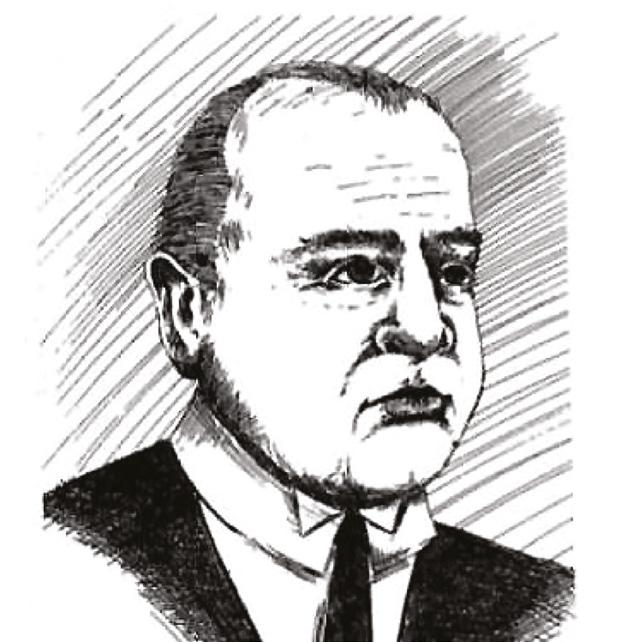
The first crops yielded only enough grain to provide seed but Ruse had proven it was possible to become self-sufficient and he was rewarded with a grant of 30 acres, known as Experiment Farm, on the lands of the Burramatta Dharug people.
Tench visited Experiment Farm in December 1791, reporting that Ruse lived in “a comfortable brick house, built for him by the governor”. He had 11.5 acres under cultivation which would be sown to maize because it yielded better than wheat, four breeding sows and 30 chickens.
But after a catastrophic harvest two years later, Ruse sold the farm to a neighbour, Surgeon John Harris, and obtained a new grant of 30 acres on the Hawkesbury River flats.
The family prospered on the fertile land at the junction of South Creek, sometimes known as Ruse’s Creek, and the Hawkesbury – now Pitt Town Bottoms – until repeated floods drove them into debt.
Ruse went to sea, working on whalers and cargo ships, while his wife Elizabeth held down the fort at home.
In 1806 she was listed in the Muster – the 19th Century equivalent of a census – as a landholder with

15 acres, three workers, seven pigs and supporting four children.
For many years historians thought the Ruses, who had five children of their own, had adopted two more, Ann and William.
But descendants used DNA testing to prove in 2019 that Ann and William were the offspring of Elizabeth and James Kiss, a friend of James Ruse.
AN AUSSIE BATTLER
Above, then clockwise: The headstones of Elizabeth and James Ruse in St John’s Catholic Cemetery in Campbelltown (Source: Find a Grave); This portrait of Ruse in National Trust Magazine was created using NSW Police photofit facial identity equipment based on descriptions provided by descendants who had seen a portrait of Ruse that went missing at Temora in the 1960s; An artist’s likeness of Ruse.
After further flooding, Ruse surrendered the land on the Hawkesbury and successfully requested a grant of 100 acres at Salt Pan Creek in the Bankstown area.
By 1813 he owned a house at Windsor and in partnership with Elizabeth later bought a half share in a farm on the Hawkesbury, before taking up grants of 100 acres each at Bankstown and Riverstone.
The final grant in 1821 was at lower Minto – now Macquarie Fields – where the couple remained until their deaths: Elizabeth in 1836 and James 18 months later after carving the epitaph for his headstone.
Using a hand chisel he inscribed the words: Gloria in axcelsis
Sacred
To the memrey of James Ruse who departed this life Sept 5th in the year of houre Lord 1837 Natef of Cornwell and arived in this coleney by the forst fleet aged 77
My Mother reread me tenderely with me she took much paines and when I arived in this coelney I sowd the forst gran and now with my hevenly father I hope for ever to remain.
Ruse was buried beside Elizabeth in St John’s Catholic Cemetery, at Campbelltown.
After vandals caused damage at the cemetery in 1994 his headstone was taken for safe keeping to
HISTORY JAMES RUSE
62 THE FARMER MAY-JUNE 2024

the council-owned Glenalvon House, home of the Campbelltown and Airds Historical Society, and a replica erected in its place.
It wasn’t until a century after Ruse’s first successful harvest that the Department of Agriculture was founded, with experimental farms established in 1892. The first wheat research started in 1893 with trials of 200 varieties planted at Wagga Wagga.
In the following years, Ruse’s exploits were idealised in the jolly language of the time for the benefit of school children learning about Australian history.
REMEMBERING RUSE
Alison Hay wrote in The School Magazine in August 1947 that Ruse had been sent to Australia as a convict after doing “some little foolish thing”.
“For this young, brave farmer, the first months on his little farm were the hardest,” she wrote.
“Kangaroos and wallabies ate the young green wheat, thieves stole his cabbages by night... He was tired, often very short of food, and very lonely, but he never gave up.”
And in an article in Walkabout magazine in 1964, Clifford Tolchard wrote that Ruse was probably mistaken in thinking he had sown the first grain as he had claimed on his headstone.
“But in his humbler sphere Ruse left his mark on Australian history as surely as did the more exalted figures of the civil and military leaders,” Tolchard argued.
“It is fitting that the James Ruse Agricultural High School at Carlingford should be named after the man who was, after all, the first true farmer in Australia.”
Concluding James Ruse’s entry in Volume 2 of the Australian Dictionary of Biography published in 1967, BH Fletcher wrote Ruse was “one whose importance in New South Wales history has been unduly exaggerated and romanticized. Although his early achievements

were noteworthy, he soon faded into the background and led an existence that scarcely distinguished him from many of his associates.”
Fletcher might have been obliquely referring, among others, to Lieutenant John Macarthur, who established Elizabeth Farm on 100 acres granted at Parramatta in 1793 and is widely regarded as the founder of Australia’s wool industry.
Nonetheless, Ruse’s persistence, despite countless setbacks from drought, bushfires, floods, thieves and pests, demonstrated it was possible for settlers to successfully farm the land.
The original little Aussie battler pioneered cropping in NSW and set an example for generations to come.
His name was not only given to James Ruse Agricultural High School, which was established in 1959, but also the suburb of Ruse in 1968 and the Parramatta bypass, James Ruse Drive, in 1981.
Sources: Australian Dictionary of Biography, First Fleet Fellowship, Gutenberg, Launceston Then, James Ruse Agricultural High School, National Library of Australia (Trove), State Library of NSW, The Stony Ground: The Remembered Life of Convict James Ruse (2018) Michael Crowley, People Australia, James Ruse: The Humble Adventurer, Walkabout (1964) Clifford Tolchard l
REMEMBERING RUSE
Above: Grant of 30 acres to James Ruse in 1792 (Source: Museums of History NSW); Gravestone of James Ruse at St John’s Cemetery Campbelltown (Source: State Library of NSW).
“It is fitting that the James Ruse Agricultural High School at Carlingford should be named after the man who was, after all, the first true farmer in Australia.”
–CLIFFORD TOLCHARD Author
63 MAY-JUNE 2024 THE FARMER
ENABLING OUR LOCAL PRODUCERS TO DELIVER THE GOODS
WATERNSW LISTENING AND CONNECTING WITH LOCAL COMMUNITIES
Inland Rail is a nation-building project that has been in the making for a long time, with former Prime Minister John Howard first approving initial plans for the project back in 1998, although construction would not actually begin for another two decades.
‘May you live in interesting times’ is a saying that fits the challenges facing many rural and regional communities across the state. We spoke to WaterNSW Chief Executive Officer, Andrew George, for his perspective.
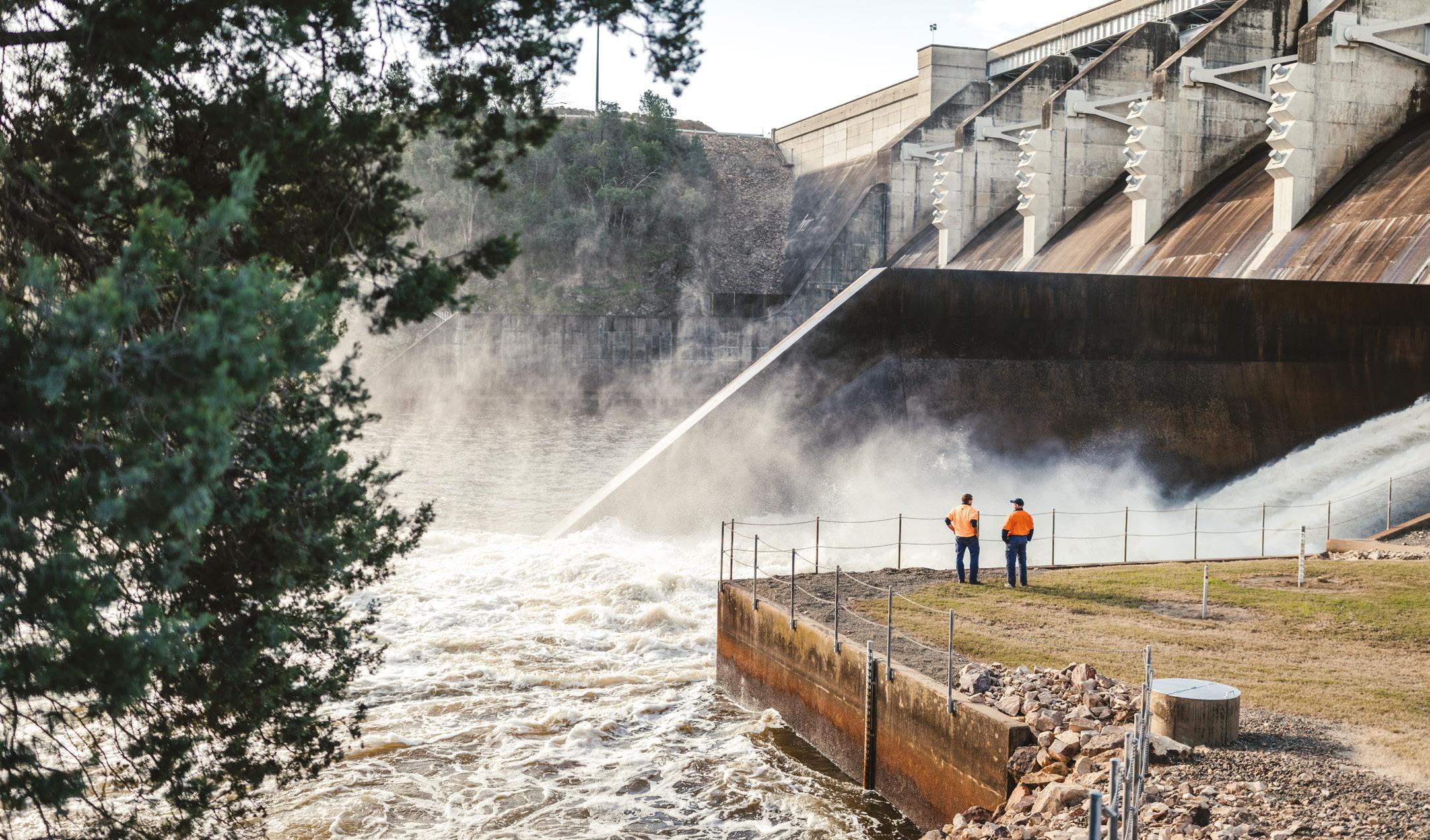
Since construction was completed on the first Parkes to Narromine section in late 2020, farming communities along the Inland Rail route have been eagerly awaiting the arrival of the rail line to help gain the huge benefits the
“It’s not all that long ago that our customers and the communities WaterNSW serves were dealing with the heartbreaking impacts of a third successive year of major flooding,” Mr George said.
In late October 2023, primary producers in the Narrabri and Moree regions celebrated the arrival of Inland Rail, with the official completion of major construction on the second section of the project – the Narrabri to North Star (N2NS) Phase 1 section – comprising over 170 kilometres of track.
“FUEL PRICES AND LABOUR PRICES ARE BECOMING OUR LARGER COSTS, SO HAVING THE ABILITY TO REDUCE THOSE COSTS BY SHIPPING MORE EFFICIENTLY BY RAIL IS ALWAYS A WIN FOR US.”
“Then while many towns and landholders were still recovering, there were predictions of looming dry weather and we started preparing for drought conditions. Now, the models are pointing towards a likely return of La Nina weather patterns and wetter conditions this year.
“Today, the state is in the unfortunate position of having areas still in flood recovery –at places like Eugowra, Forbes, Deniliquin, Lismore, and parts of the HawkesburyNepean – while other areas in the north of the state remain drought declared.
The completion of major works on N2NS Phase 1 improved efficiency and reliability on the main line, as well as boosting resilience to extreme weather events, with the newly laid track withstanding the worst flood in a decade to

In total, the N2NS Phase 1 project comprised some seven bridges being upgraded, five new crossing loops being completed for trains to pass each other safely and some 57 level crossings being upgraded, with 10 of these being upgraded from passive to active.
“Add into the equation the economic challenges of inflation, rising interest rates, cost of fuel and other factors contributing to rising costs, and it’s little wonder many businesses and households are struggling to make ends meet.
“Clearly, these are not just interesting but challenging times – for farmers, for regional communities, and for people across the state.”
The completion of major construction of N2NS Phase 1 involved the usage of nearly 300,000 sleepers and 600,000 rail clips, all manufactured in Rocklea, Queensland, as well as nearly 5000 precast culverts manufactured in Tamworth and 176 kilometres of rail track manufactured in Whyalla, South Australia, weighing some 21,000 tonnes in total.
ADVERTORIAL
6 THE FARMER MARCH-APRIL 2024
MAY-JUNE 2024
Keepit Dam, about 40 kilometres upstream of Gunnedah on the North West Slopes, was the first of three dams built on the Namoi River. It’s capacity of 425,000 megalitres makes it nearly as large as Sydney Harbour.
Andrew George, WaterNSW Chief Executive Officer.
RISING COST PRESSURES ON BUSINESS
CELEBRATIONS IN MILGUY
COST-SAVINGS TOP-OF-MIND
To celebrate the completion of the major construction on the project, Inland Rail staff, contractors, civic leaders, local primary producers, First Nations representatives and other key stakeholders came together in Milguy – 50 kilometres northeast of Moree.
Mr George said WaterNSW is facing similar challenges to many businesses –higher interest rates, higher insurance costs, higher construction costs, higher land tax – driven by the current macro-economic environment and factors outside of its control.
WaterNSW operates 41 major dams across the state, capturing and storing two-thirds of the water used in NSW, and then supplying it ready for distribution – for agriculture, industry, the community and the environment.
Mr George said WaterNSW is working to limit price increases where it can by reducing costs within its control, and also considering a range of alternative funding options.
“We are targeting a reduction of $26 million, or 10%, of our annual operating expenditure, and seeking to defer capital expenditure where it’s prudent to do so,” he said.
“Like any business, we are working hard to control costs, meet the needs of our customers in delivering water when and where it matters, as well as meeting broader community expectations,” Mr George said.
The day also marked the opening of the line between Camurra and North Star, the final stage to be handed back to the track operator, Australian Rail Track Corporation (ARTC). This section is now much safer and freight trains can run faster after servicing grain handling facilities at Milguy, Croppa Creek and North Star.
“We're very focused on minimising the impact to our customers of the rising costs they're facing from water services.
“The cumulative impact of prices rising across the board puts strain on all parts of the economy, so I’m determined that WaterNSW will do our bit to ease pressures where we can.”
The delivery of N2NS Phase 1 has opened new opportunities for local producers on that part of the route. This includes Boolah Farms, which was established in 2002 by Lyndall and Stuart Tighe as a primary production, share and contract farming venture. Boolah has since grown its activities beyond the production of agricultural commodities to being a diversified service provider.
LISTENING TO COMMUNITIES
“This cost transformation program has already delivered $18 million in recurrent savings to date.
“I’ve asked all our staff to be creative about how we find cost efficiencies. It's up to everyone to understand the impact of decisions on the bottom line.”
For Boolah Farms, the upgrades to N2NS Phase 1 delivered a new ramp near the mainline in Milguy, allowing grain loading directly from the farm and onto the train.
WaterNSW has offices in more than 30 locations across regional NSW where it operates 20 large dams and dozens of weirs on 12 major river systems to capture, store and deliver water to customers and communities.
“Our staff are part of the fabric of local communities, and we are more focused than ever before on listening and engaging with our customers and communities across the state,” Mr George said.
WaterNSW is currently consulting with customers and stakeholders for its final pricing proposal to IPART in September 2024. New prices will take effect from 1 July 2025.
Stuart says the upgrade has brought huge benefits to his business. “It’s a very exciting time to be able to load these trains directly from the field and grain storages,” he says. “The efficiencies this brings to the supply chain, to be able to move large volumes safely, as well as the cost savings are significant. You can’t get more efficient than that.

“The re-opening of the rail line with longer and more efficient trains means a more efficient path down to port as well as to large domestic consumers in New South Wales and, eventually, in Queensland,” he says.
“Over the past 18 months our engagement team has been travelling across the state, undertaking the most extensive and inclusive engagement with customers and communities in WaterNSW’s history,” he said.
“We’ve been attending field days, regular meetings of local organisations, and hosting online and in-person forums.
“Fuel prices and labour prices are becoming our larger costs, so having the ability to reduce those costs by shipping more efficiently by rail is always a win for us.”
“We started by asking for people’s priorities when it comes to water services delivered by WaterNSW, and listening to better understand the challenges our customers are facing.
NEW INDUSTRIES, BUSINESSES AND BETTER CONNECTIVITY
WaterNSW staff gathering feedback from visitors at the Henty Field Days
a boom-and-bust community as we are so dependent on agriculture, but the arrival of Inland Rail and the Special Activation Precinct in Moree gives us a huge opportunity to grow new industries and welcome new businesses to our town,” she says.
PRICE SETTING PROCESS
Prices for water services provided by WaterNSW are set by the Independent Pricing and Regulatory Tribunal (IPART), the independent pricing regulator for water, public transport and local government.
Although local primary producers deliver around $1 billion per year to the local economy, Susannah Pearce, Moree Plains Shire Council, Deputy Mayor, says that the arrival of Inland Rail and the Special Activation Precinct in Moree (a dedicated area identified by the NSW Government to become a thriving business hub) will help Moree diversify its industrial base.
“From these discussions we identified which services and business areas of WaterNSW should be prioritised, and we are now consulting with customers and other water stakeholders on detailed proposals for cost sharing, tariff structures and expenditure proposals for our upcoming pricing submission, which sets our prices over the next five-year regulatory period from July 2025.
“We recently completed the fourth round of consultations with Water Working Groups comprising farmers and industry, local government, recreational users and environmental groups, as well as major agricultural customers.
A fifth round of consultations begins this month.
“I’m delighted at how this new and innovative process has deepened conversations and engagement with our existing customers, and connected us with a broader range of water users and communities.”

Moulamein rice grower and Chair of National Irrigators, Jeremy Morton, completes a WaterNSW pricing survey at the Rice Growers Conference in Griffith.
The completion of major construction on Phase 1 of N2NS is not the end of the story though. More benefits will be unlocked with Phase 2 of the N2NS project, which involves further upgrades and building 2 kilometres of new track north of Moree.
IPART ensures that proposed costs meet regulatory obligations, reflect customers’ preferences, and are prudent, efficient, and represent value for money.
WaterNSW will submit its final pricing proposal to IPART in September 2024. New prices will take effect from 1 July 2025.
Phase 2 is currently in approvals, with Inland Rail now preparing a Preferred Infrastructure Report and a Response to Submissions Report for the NSW Department of Planning, Housing and Infrastructure.
Once completed the upgraded track between Narrabri and North Star will allow freight customers to transport heavier freight volumes at higher speeds through its access to the ARTC Hunter Valley Rail Network, boosting their productivity and efficiency.
For information from WaterNSW on dam release rates and river impacts:
Sign up to our Early Warning Network (EWN) –http://waternsw.com.au/supply/ewn
The completion of major construction on N2NS Phase 1 did not just bring the benefits of better rail access for local producers, Inland Rail also built or upgraded mobile transmission equipment in four locations, delivering improved connectivity for trains using the rail line while also improving mobile coverage for residents and businesses.
Visit WaterInsights for dam levels, rainfall totals, dam releases –http://waterinsights.waternsw.com.au
ADVERTORIAL
7 MARCH-APRIL 2024 THE FARMER MAY-JUNE 2024

Above: Aruva has a range of one, two and three-bedroom modular accommodation units suited for farm stay accommodation, ready to be transported to the paddock.
MARRYING AGRICULTURE AND TOURISM
MODULAR MAGIC
66 THE FARMER MAY-JUNE 2024
Adding holiday accommodation to your farm has become simpler with the easing of NSW planning regulations and a growing range of ready-to-rent cabins and tiny homes that can be plonked in a paddock with minimal fuss. –
Words MICHAEL BURT
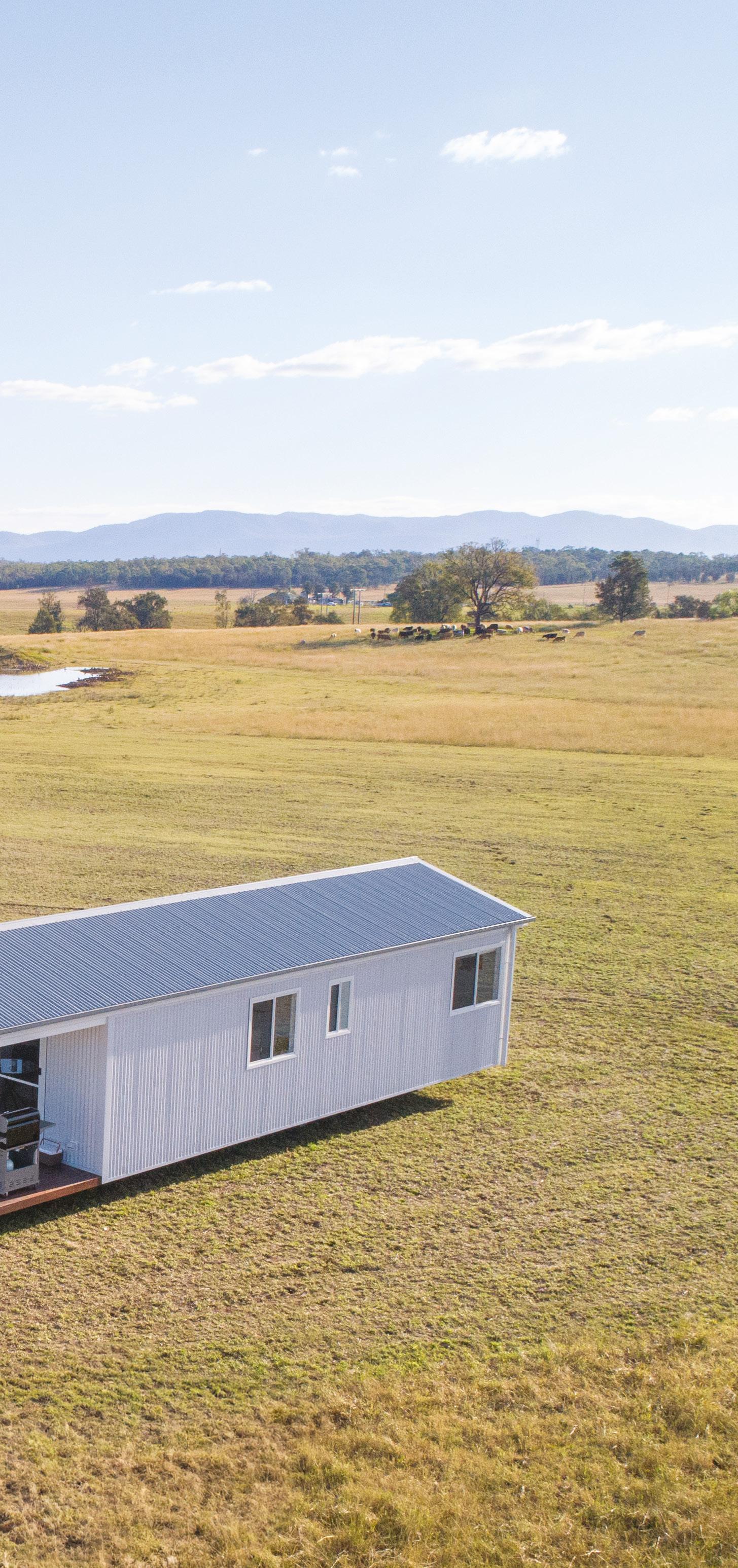
Changes to the NSW planning system in December 2022 have made it easier to develop agritourism experiences such as farm stays, cafés, cellar doors, retreats, roadside stalls, fruit picking and small wedding venues.
NSW Farmers Association and the tourism industry welcomed the State Government’s agritourism policy, which has inspired a surge in interest from the farming community to diversify into offering farm-stay accommodation.
Booking platform Hipcamp says it has seen more than 100 new farm camping experiences open across NSW since the agritourism policy was introduced.
The easing of development consent rules has also helped grow the availability of farm-stay cabins, tiny homes and converted sheds as unique accommodation options.
Susan Wheeldon – Airbnb Country Manager for Australia and New Zealand – says hundreds of farmers have introduced a new income stream through adding farm stay accommodation to their business.
“Among all the unique types of listings in Australia – from tiny homes, lighthouses, and even trains (among others) – farm stays are the most popular category, with nights booked in these types of listings growing by over 60 per cent since 2019,” Susan says.
“Airbnb hosts go a long way in helping to grow regional tourism and really love sharing what makes their local communities and experiences so unique. Many of these locations simply don’t have traditional forms of accommodation, so visitors are often able to enjoy these locations for the very first time thanks to farm-stay hosts.”
Airbnb partnered with Australian Regional Tourism (ART) to help fund a National Agritourism Strategy Framework to support the emerging sector growth through to 2030.
Released in October 2022, the ART Framework and accompanying Agritourism 2030 Roadmap focusses on making it easier to build sustainable agritourism businesses, developing distinctly Australian agritourism experiences and promoting the sector with an alignment to local food and drink.
ART CEO Lauren Douglass said the Agritourism 2030 recommendations were presented to the Federal Tourism and Agriculture ministers.
“We have also put in a pre-federal budget submission that was endorsed by the National Farmers Federation that calls for $14 million in funding over four years to develop agritourism,” Lauren said.
“We want to see national leadership in this space. There are a lot of barriers for farmers, particularly around landuse regulations. NSW has made some reforms, but there is still a long way to go.
“NSW is leading the way and there is really good support from Destination NSW in promoting agritourism experiences.”
Lauren said momentum has been growing across the States and Territories to use agritourism as a
> SPECIAL REPORT AGRITOURISM
67 MAY-JUNE 2024 THE FARMER
deeper and richer expression of food, drink, and community.
“Tourism Australia has recently announced that it will be adding an agritourism collective to its Signature Experiences of Australia program, which means it will be added as a priority for marketing overseas.”
Currently, the eight special interest sectors are golf holidays, guided walks, premium wineries, luxury lodges, fishing adventures, wildlife journeys, cultural attractions, and Aboriginalguided experiences.
“Agritourism provides an opportunity for farms to be sustainable during marginal times, support communities and engage farmers of scale, artisan producers and First Nations Australians as we bring agriculture and tourism together,” Lauren said.
WHAT ARE THE NEW FARM STAY RULES?
NSW Farmers Association Partner Aruva Modular has delved into the fine print of the NSW Government’s agritourism policy to assist farmers with advice on adding farmstay accommodation.
The family business is located at Lisarow on the Central Coast and has been providing modular home solutions for more than 30 years.
An Aruva spokesperson said the planning changes should inspire more engagement in
agritourism opportunities from farmers who had witnessed an influx of travellers to rural regions during and post the COVID pandemic.
“In terms of farm stay accommodation, you can now install up to six modular, or relocatable, buildings – no more than 60 square-metres each – on your farm without having to go through the rigmarole of getting approvals from your local shire,” Aruva explained.
“However you need to be able to tick some other boxes first, and to be blunt, a few of them can be deal-breakers for some farmers.”
Most farm businesses would meet the basic conditions of the land being zoned RU1, RU2 or RU4 and the size of the farm exceeding 15 hectares. The farm must also have an approved residence and be able to provide off-street parking- two assets that already exist on most farms.
“The agritourism side of your property needs to play second fiddle to your main farm game, the primary producer. And you need to be able to demonstrate this in some way – financial accounts for example. The word the policy uses is ‘supplementary’.
“And the property, or at least the area where the accommodation units are going, must be in a zone that’s BAL29 or less. This refers to the Bushfire Attack Level.
“You do also need to reach out to your local shire to check up on the rules and

regulations for agritourism and be aware of OHS responsibilities if visitors are going to immerse in the working farm experience.”
Farm stay accommodation, farm experience premises, farm gate premises and roadside stalls can be carried out as exempt or complying development in these zones in a council’s Local Environment Plan (LEP). Exempt development is minor and low-impact development that can be carried out without the need for planning or building approval if it meets specified development standards. Complying development is a fast-tracked approval process for straight-forward development where planning and building standards can be signed-off by the council or a registered certifier.
Aruva Modular does provide support for farmers in terms of planning and approval requirements through partnerships with town planners that specialise in agritourism.
“The farm stay accommodation is just one part of the agritourism experience that travellers are seeking. Our modular homes make it easy for farmers to sort out the accommodation side.
“Modular construction is particularly suited to rural and regional areas. The bulk of the work is done where the resources are located, which is the Central Coast in our case, and then the modular homes can be transported out to the regions.” >

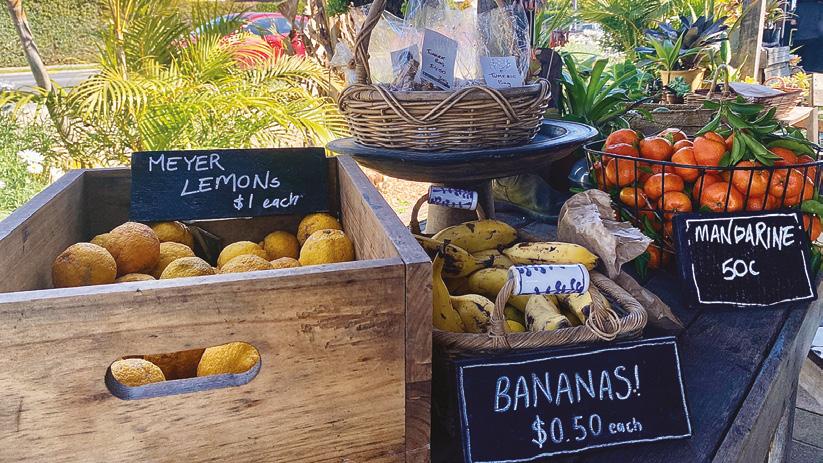
SPECIAL REPORT AGRITOURISM
FAST AND FARM-READY
Above left: Uniplan modular homes provide accommodation options for farmers looking to diversify into agritourism.
68 THE FARMER MAY-JUNE 2024






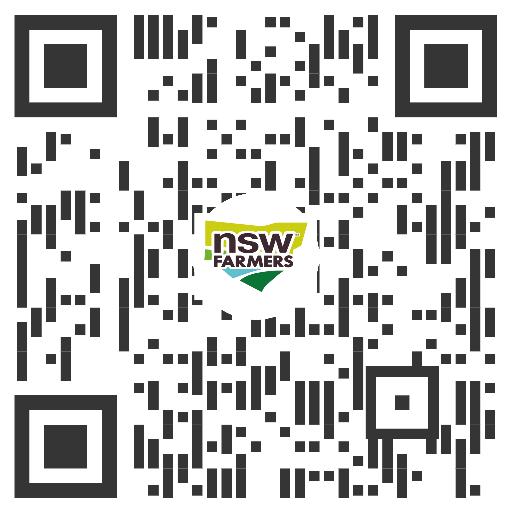
Advocacy Is Just The Beginning Level 4 154 Pacific Highway St Leonards, NSW 2065 02 9478 1000 FREE $12,000 fitout package Members saved on average $368 last year Check all our member benefits SCAN HERE To take advantage of all our www.nswfarmers.org.au exclusive member benefits visit Members received on average $414 last year via rebate Members saved upto $24,686 on eligible trucks
Aruva has a range of one, two, and threebedroom modular accommodation units suited for farm stay accommodation that can be transported to the paddock ready to be plugged into power and plumbing.
“The farmer has to then organise the electricity and plumbing. We can do the foundations, but farmers are very resourceful and can also do their own foundations.”
NSW Farmers members get an extra ‘plug & play’ bonus with an exclusive Aruva Modular offer that features everything you need to deck the home out, including lounge suite, dining table, chairs, beds, bedside tables, even mattresses.
Call Aruva Modular on 1300 59 59 31 to find out more.
ARMIDALE’S UNIPLAN EXPANDS INTO AGRITOURISM
Armidale-based Uniplan Group is expanding its two decades of expertise in modular building solutions for tourist parks into farm worker accommodation and the agritourism market.
Starting out as a three-man team of Howard, Ben and William Scott in 1999, the family business now employs more than 100 staff and recently doubled its production
capacity with the opening of new innovative factory space in Armidale.
Sales Manager Tom Thorncroft said Uniplan’s existing range of modular buildings are ready made to be used for farm stay accommodation.
“There are standard one and two-bedroom options available, and we have the flexibility to customise our modular buildings that are used for worker accommodation to potentially be a dual purpose and provide farm stay accommodation as well,” Tom said.
“While the business began constructing buildings outdoors, we have since expanded our facilities and capabilities. Our advanced manufacturing facilities enable us to construct and furnish a complete building every day, with over 2,500 already deployed in the field.”
Every cabin in the new factory moves through the production system that has 21 work stations. Each station takes a single day meaning the total production time is 21 days.
That’s pretty quick for a fully completed cabin or home ready to place in the paddock.
“More importantly it means we can forecast with 100 per cent accuracy. If we say we will deliver your buildings on a
specific date, we know that’s exactly what will happen, like magic.”
Contact Uniplan on 6773 8567 for more information.
FARM TOURISM COULD REACH
$18.6 BILLION
Agritourism will be an important growth industry for Australia’s regional and rural economy over the next decade, according to the CSIRO.
CSIRO analysis estimates the annual opportunity for agri-related tourism, including accommodation, transport and retail sectors, to reach around $18.6 billion by 2030.
Focusing on expenditure for food, drinks and accommodation, the annual opportunity is expected to reach $5.6 billion by 2030, including $3.6 billion spent by international visitors and $1.9 billion spent by domestic visitors, on both day trips and overnight stays.
International visitor demand is expected to drive the majority of this growth, with visitors from China, United States, United Kingdom, New Zealand, Japan and India expected to account for more than 60 per cent of international expenditure by 2030. l



SPECIAL REPORT AGRITOURISM
HARVESTING NEW OPPORTUNITIES
to
of these new opportunities. 70 THE FARMER MAY-JUNE 2024
Above: Agritourism is a growing industry for Australia’s regional
and
rural economy, estimated to reach around $18.6 billion by 2030. Aruva (bottom left) makes it easier
for farmers
take advantage
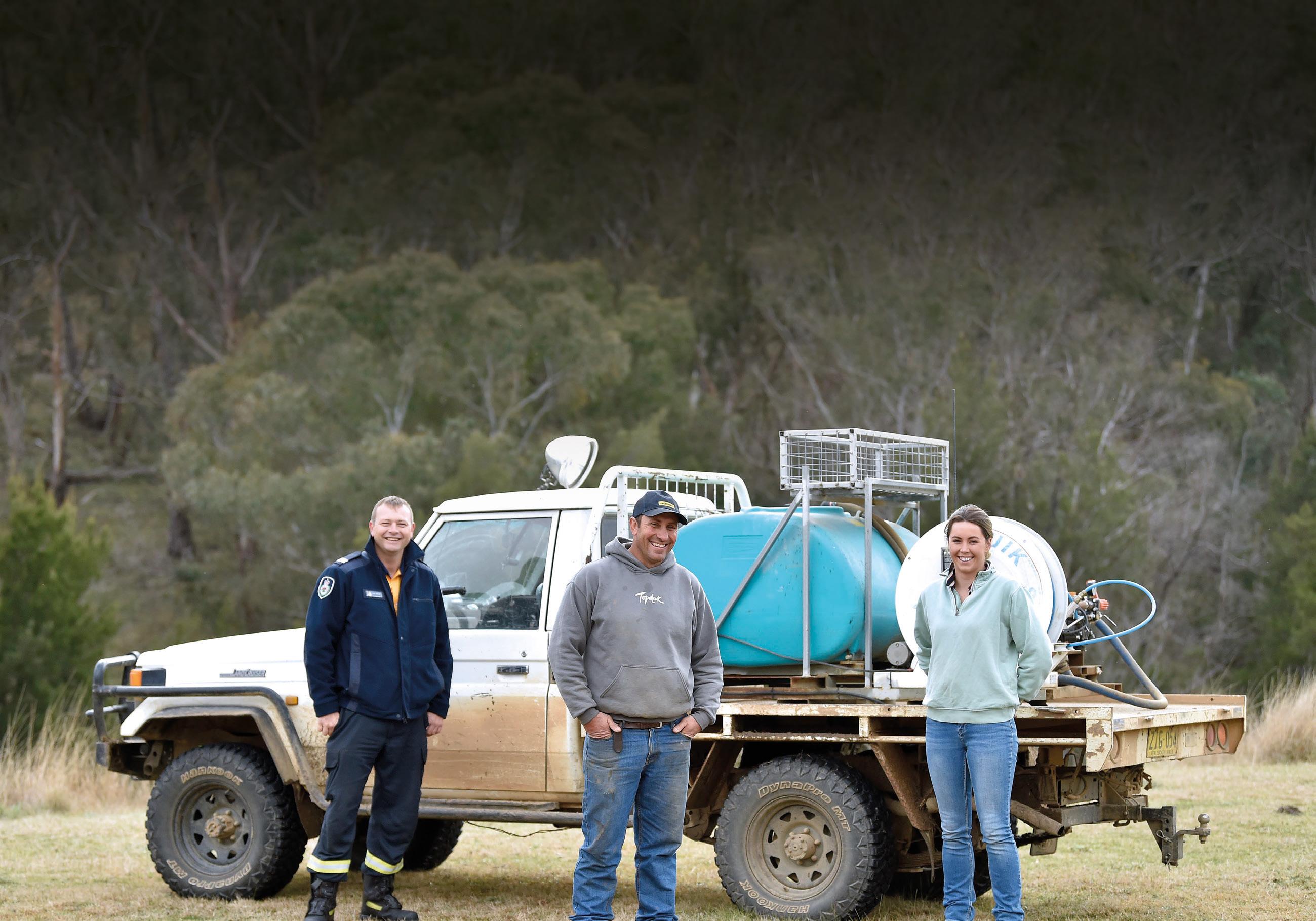




LOVE OF THE LAND
Anika Molesworth is reshaping the farming narrative, one action at a time.
Words MATILDA MEIKLE

SEEDS OF CHANGE
The Millenium Drought affected Anika Molesworth’s family farm when she was a child, and sparked her interest in caring for the land and the environment.
COMMUNITY NEW GENERATIONS
72 THE FARMER MAY-JUNE 2024
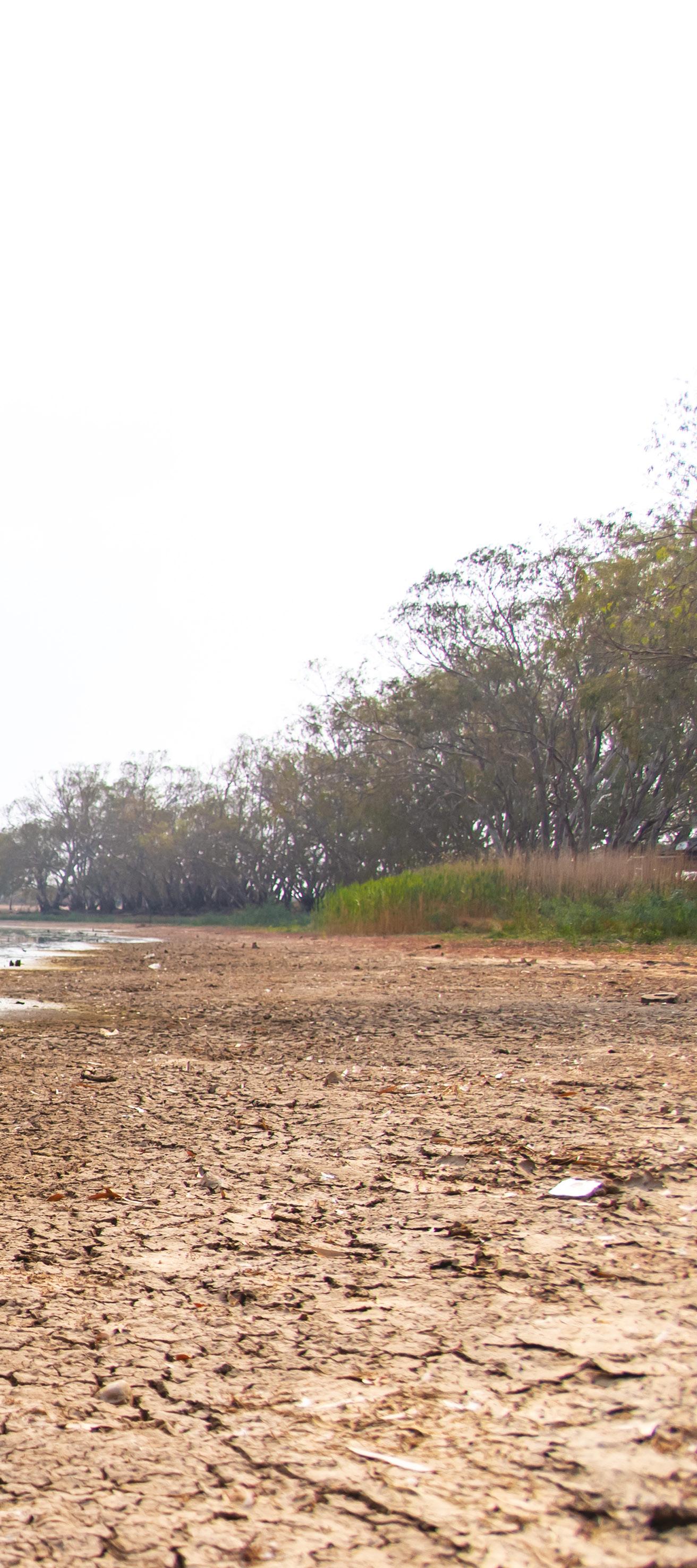
When Anika Molesworth moved to a sheep station near Broken Hill at the age of 12, she never could have imagined the profound impact it would have on her life.
Today, she is a climate change activist who runs educational workshops and speaks at events that tackle important global issues. But back then, she was a small child travelling 1000 kilometres away from her home in Melbourne with her parents.
“We arrived out there and the place was so lush and beautiful, I fell in love with it instantly,” Anika says.
But despite the tranquillity she found on the property, it wasn’t long before Anika and her family were faced with a life-changing challenge.
“The Millennium Drought began when my parents first bought the property. We had little to no rainfall out here, and the land just deteriorated before my eyes,” she says.

“These were quite formative years – I was still a teenager –and I was shocked by what was happening to my home, my community, and to my family. There was also a real sense of the unknown, and it was that dread that really sparked my interest in the environment. I questioned how we look after and take care of the land, because it’s the foundation of farming and rural communities.”
Driven by doubt and a desire to make a difference, Anika went on to complete a bachelor’s degree in agribusiness. It was there she learnt all about climate change, and its devastating impact on the environment. She fostered a passion for knowledge, establishing a Facebook page called Climate Wise Agriculture to share articles and scientific research about environmental degradation.
“It all just grew from there,” Anika adds. “I began running workshops, speaking at events and starting projects. It really flourished on that foundation of wanting to share and exchange information with other curious people.”
ON TO THE GLOBAL STAGE
Soon, Climate Wise Agriculture was a major organisation, and Anika found herself travelling all over the world to speak with farmers and political leaders about the need to take immediate environmental action.
73 MAY-JUNE 2024 THE FARMER
>
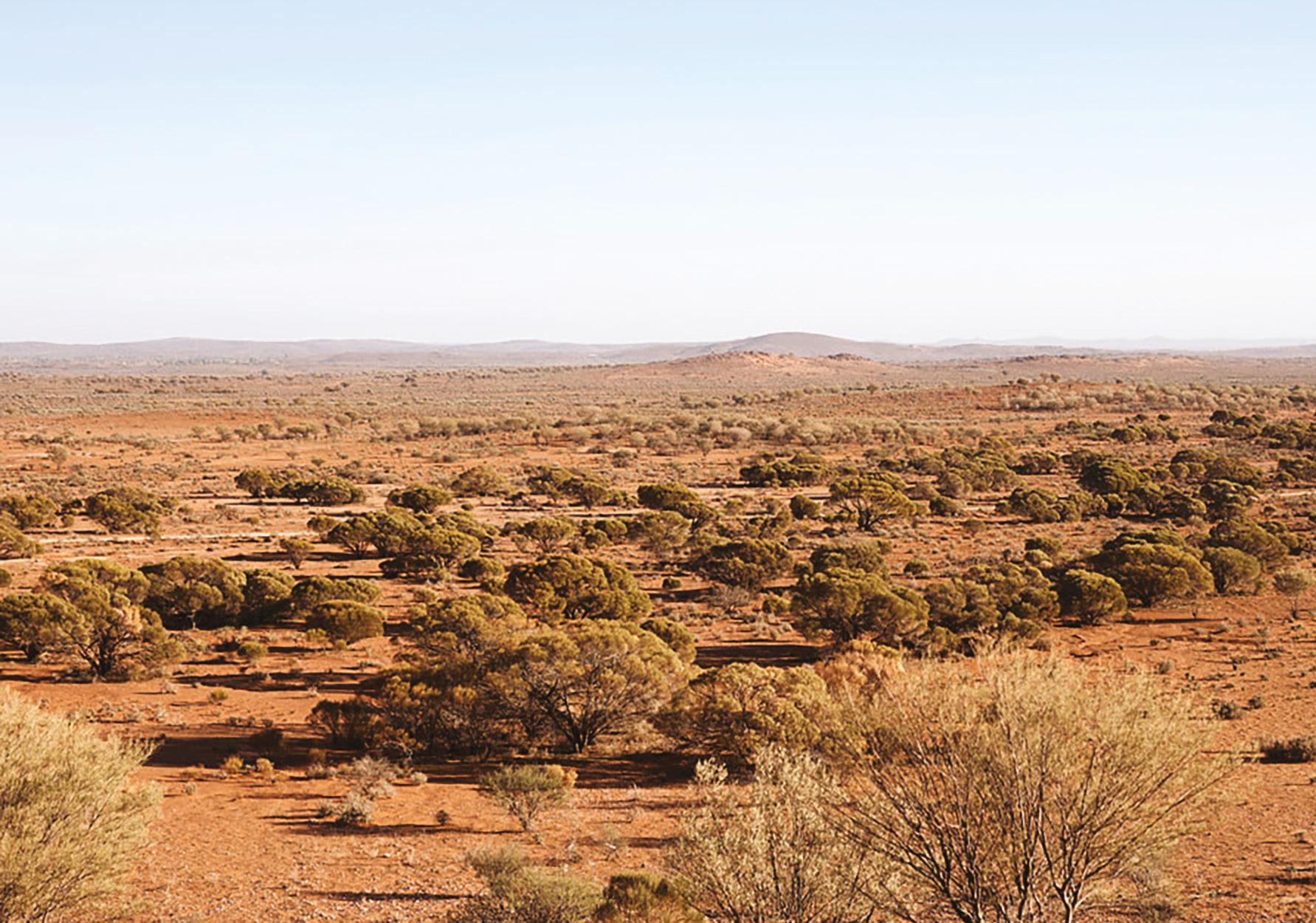
“It’s important to consider the global farming family and ask how we can help each other to grow food for our communities. It opens up conversations on how to work together.”
Anika Molesworth

COMMUNITY NEW GENERATIONS
74 THE FARMER MAY-JUNE 2024
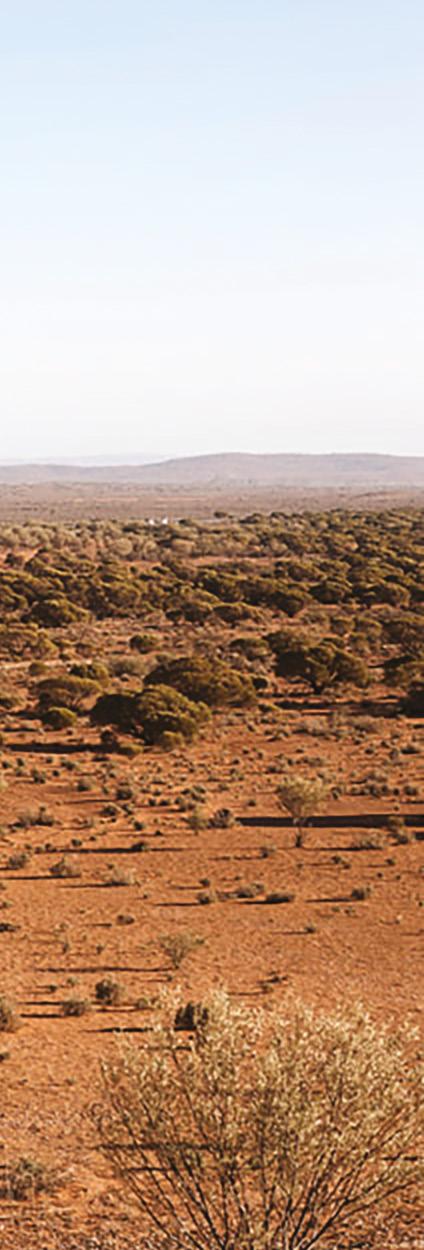
Left: Anika
achieved a PhD in agriculture and environmental science, and is now a leading voice on resilience in agro-ecology, emphasising the connection between land, climate and food.
“People need to realise that they can invest their time and resources into sustainable practices and it will pay off financially, environmentally and socially.”
Anika Molesworth
“I’ve spoken with school kids about setting up a compost garden or recycling system in their schoolyard, and I’ve spoken with high profile leaders about how to incorporate strategies into an organisational business plan,” Anika says.
“I think that’s the beauty of it. We’re all part of these conversations, and there is no one single solution. It’s going to take a whole multitude of different solutions if we’re going to save our planet.”
Using her PhD in agriculture and environmental science, Anika is a leading voice on resilience in agroecology, and wants to emphasise the connection between land, climate, and the food found on plates in every Aussie household.
MAKING CHANGES
Throughout Anika’s impressive career, which has taken her to remote destinations such as Antarctica and seen her publish a book, she has discovered the power that comes when individuals make changes in their lives.
“We have to recognise that we all have either a negative or positive impact on the resources that we use and consume,” she explains.
According to the Australia Institute, Aussies waste 7.6 million tonnes of food each year, costing $19.3 billion annually and contributing to the release of greenhouse gases. Additionally, the production of food releases between 12 and 17 per cent of national emissions, according to the Department of Agriculture, Fisheries and Forestry (DAFF).
In order to promote more sustainable practices and combat climate change, Anika believes that everyone must take part. But it doesn’t have to be complicated.
“There’s so much we can do as individuals, and it starts by being curious and open-minded,” she says. “Simply choosing local produce and native foods at the supermarket is a change that can make a difference. And paying a fair price for food is really important, so farmers have the financial resources to make changes on their properties, whether that means installing more efficient irrigation systems, planting trees, or finding ways to mitigate emissions.
“I also recommend people consider avoiding excess food packaging because we know that plastic waste is a huge contributor to environmental issues.”
In fact, the Australia Institute reveals that only 14 per cent of plastic waste is recycled, the rest ending up in landfill where it releases carbon dioxide into the atmosphere. For Anika, this highlights the urgency of the climate issue, one which can only be tackled when we all band together.
“People need to realise that they can invest their time and resources into sustainable practices and it will pay off financially, environmentally and socially,” she says.
For those wishing to learn more about how to help, Anika recommends organisations such as Farmers for Climate Action, a community of farmers from all around Australia who work hard to tackle the biggest issues of our times.
THE BIGGER PICTURE
While there’s lots of work to be done in rural and urban communities around the world in order to protect the environment, Anika also appreciates the beauty of the landscape and its people.
“The farmers that I have met both here in Australia and around the world are such courageous and determined people,” she says. “Farming is a tough gig, but these people continue to go out day after day and strive to do better.”
In fact, some of the most meaningful conversations have occurred in the furthest corners of the globe.
“I have had the privilege of encountering farmers in impoverished and developing nations who work so hard and still have these beautiful smiles on their faces. They want to learn, they want to listen and try new things to look after their plot of land. They’re just incredible,” she says.
For Anika, it all comes down to sparking conversation and raising awareness.
“It’s important to consider the global farming family and ask how we can help each other to grow food for our communities. It opens up conversations on how to work together,” she says.
No matter where she is, or who she is speaking to, she still thinks about those early years on her family farm, and how they shaped her career.
“My family property gives me so much inspiration and strength,” she says. “Of course, it challenges me at times, and constantly encourages me to ask how I can communicate these issues that I seriously care about. The last drought we faced lasted six years, and there were times I stepped out onto the property with tears in my eyes because I could just see how depleted everything was.
“But at other times, during those beautiful rainy years, filled with wildflowers and budgerigars, I feel so much joy. I just want to sustain it and share the beauty of the landscape. The land here drives me, and fuels me.” l
ADVERSITY TO ADVOCACY
Molesworth
75 MAY-JUNE 2024 THE FARMER
Meet a Member
Charlie Azzopardi is a broiler chicken farmer from Wimborne, near Tamworth, and he’s been a proud NSW Farmers member for 20 years.
Words EMILY RICHES
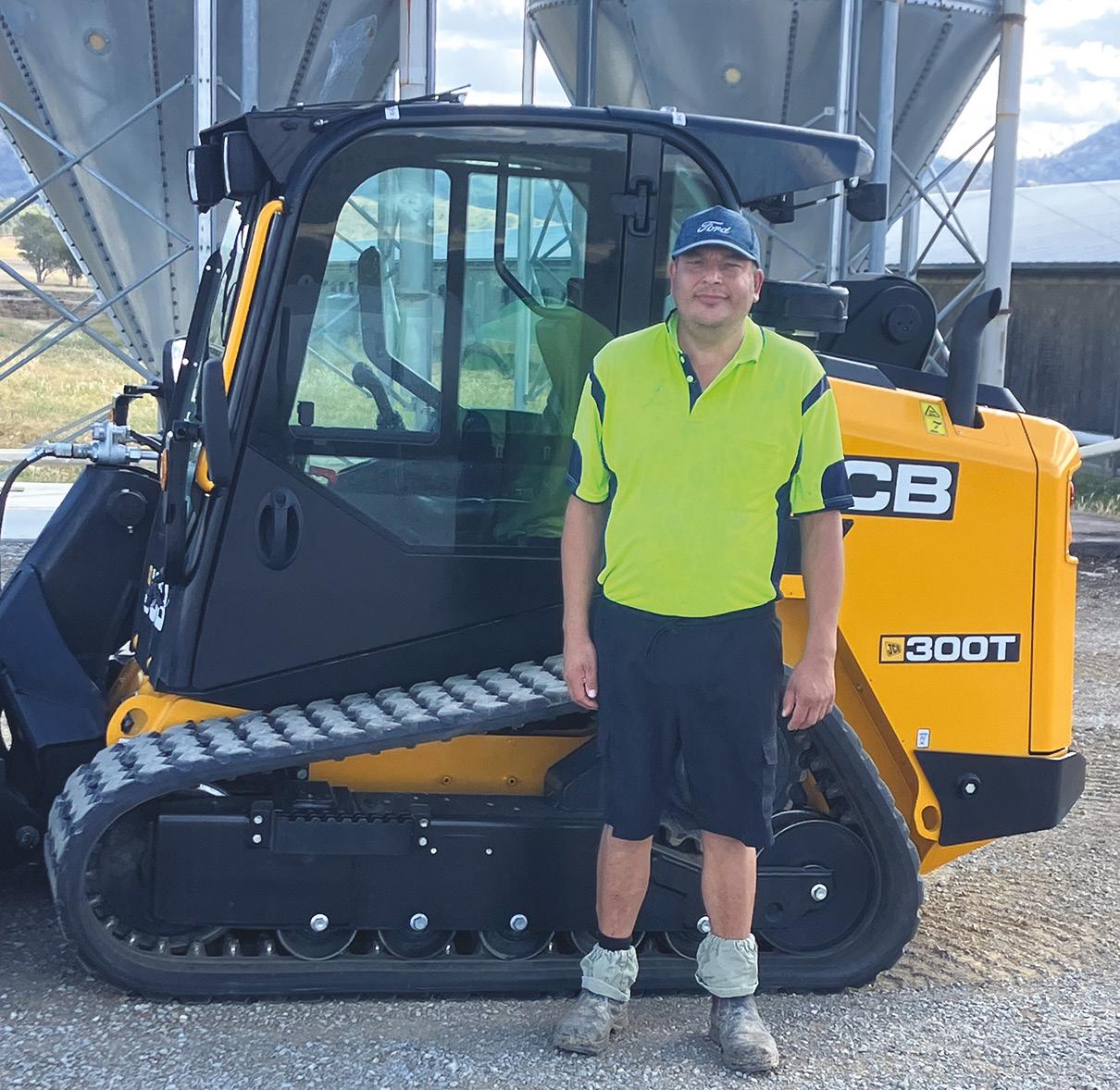
HOW DID YOU GET INTO FARMING AND AGRICULTURE?
I was introduced to farming through my family. My parents were veggie farmers out in Singleton, and from a young age, I took part in farm life.
WHAT DO YOU LOVE ABOUT FARMING AND AGRICULTURE?
The thing I love most about farming is probably the independence. There’s a sense of satisfaction that comes from being your own boss.
CAN YOU TELL ME A BIT ABOUT YOUR FARM AND WHAT YOU PRODUCE?
We have 600 acres in Wimborne near Tamworth and we grow broiler chickens for Baiada. We have around 210,000 chickens
Name: Charlie Azzopardi
NSW Farmers Branch: Tamworth
Farm: Azzopardi Chicken Growers
Years as a Member: 20
currently, housed in five tunnel sheds with about 40,000 chickens per shed. We also run some cattle, to diversify our operation.
WHAT ARE SOME OF THE BIGGEST CHANGES YOU’VE SEEN IN FARMING IN THE LAST 10 YEARS?
Over the past decade, one of the most significant changes has been the rising cost of inputs, particularly in areas like fuel and insurance premiums. This has created a tough environment where our returns are not keeping up with the rising cost of doing business.
WHAT ARE SOME INNOVATIONS YOU’VE MADE ON YOUR FARM?
To be more energy efficient, we put solar panels in to help reduce our carbon footprint. It’s a good way to use renewable energy and ensure the long-term viability of our operation.
WHO IS YOUR BIGGEST INSPIRATION IN AGRICULTURE AND WHY?
My biggest inspirations in agriculture are my parents. They taught me how to manage things, the value of hard work, and gave me my start.
WHAT DO YOU DO WHEN YOU’RE NOT FARMING?
I take some time to relax, whether it’s going to the beach, or going for a drive.
WHY ARE YOU A NSW FARMERS MEMBER?
I’ve been a proud member of NSW Farmers for 20 years because they advocate for our industry’s interests and issues. It’s good to have an organisation to lobby for farmer’s concerns.
WHAT IS YOUR FAVOURITE SECTION OF THE FARMER MAGAZINE?
My favourite section of The Farmer magazine is ‘Meet a Member’. I like hearing the stories of fellow farmers and learning about innovations in the industry. l

COMMUNITY MEET A MEMBER
–
READ IT ONLINE 76 THE FARMER MAY-JUNE 2024
The Saleyards
With cold weather right around the corner, now is the time to try these wonderful winter warmers.
Compiled by MATILDA MEIKLE

COMFORT AND STYLE
Aklanda proudly produces 100 per cent Australian Merino wool knitwear for the whole family. Each piece of ethically made clothing is sourced from an Aussie farm and transformed into comfortable sweaters, cardigans or accessories. Their 2024 winter collection features a crew neck sweater which comes in several flattering patterns and colours. $299 aklanda.com.au
WOOLLY WONDERS

For 25 years, Woolstar has been designing ethical, Australian-made wool products. The classic wool cotton quilt is a lightweight and soft bedding option made to keep nights comfortable and warm. Every product can be traced from farm to shelf and comes with a five-year warranty. $97 woolstar.com.au
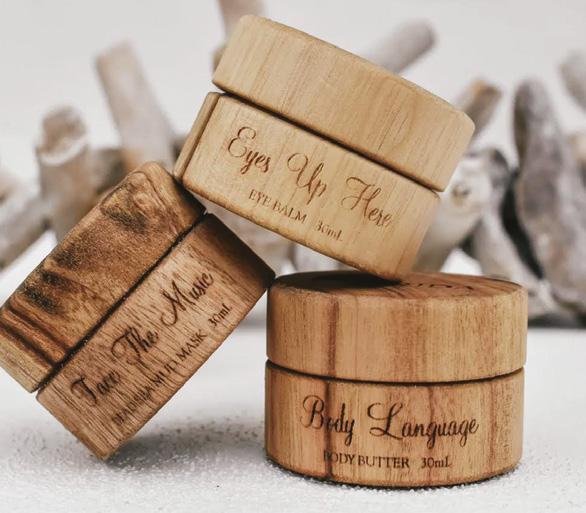
HYDRATION STATION
Avirida skincare is designed to keep your skin feeling smooth and hydrated during the dry winter months. It is the only company in the world to produce their own sustainable packaging in house, and plant one tree for every sale. The Trio Gift Pack includes balm for your face and body, infused with native Australian botanicals. $124 avirida.com
DYING TO TRY
JAFF Designs create beautiful scarves using fleece from their herd of Suri alpaca. The bush dyed scarf series is coloured using eucalyptus leaves and barks for a super soft, stylish and sustainable finish. This also ensures every product is completely unique, while also remaining breathable and lightweight.
$240 jaffdesigns.com.au

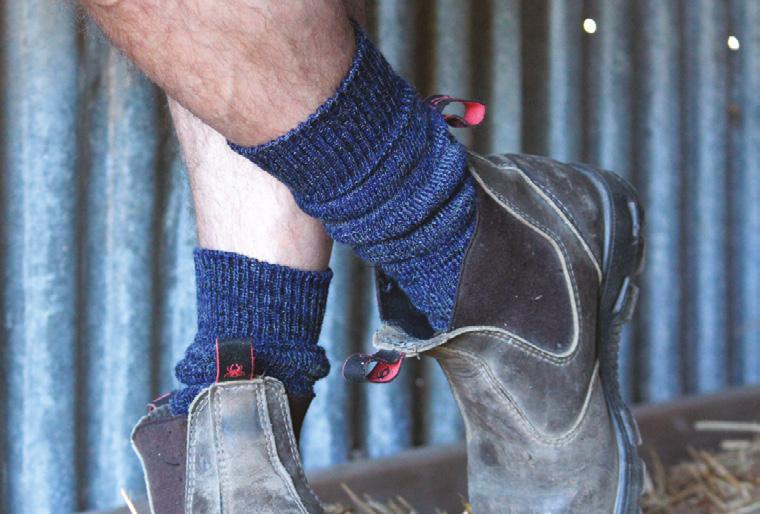
FEET FIRST
Lindner Socks, a small regional business, has been making high-quality socks since 1730. Each pair of Merino socks is designed for style and comfort, and comes in a variety of rich colours. The new Max Thick range supports an active lifestyle, keeping feet warm and dry whether you’re working, hiking or exercising. $42 lindnersocks.com.au
SIP AND SAVOUR
Indulge your sweet tooth with one-of-akind chocolate from Nomad Chocolate. Their hot chocolate powder is made using fragrant Australian natives, infusing each sip with the vibrant and unique flavours of lilly pilly, pepperberry and lemon myrtle. The chocolate powder is also dairy-free, gluten-free and vegan. $5 nomadchocolate.com

LIGHT IT UP
Ivy & Wood candles are hand poured in Brisbane using natural fragrances and reusable materials. The Australiana range features scents intended to transport you to the Aussie bush, such as pine and eucalyptus, while the packaging includes gorgeous illustrations from a local Brisbane artist. Ivy & Wood draws inspiration from nature, and regularly collaborates with locals. $44.95 ivyandwood.com.au

FRUITY FLAVOURS
Small Acres Cyder is a hand-crafted cider brand which produces all its drinks in Orange, NSW. Their award-winning products come in alcoholic and non-alcoholic ranges, although it’s hard to go past the alcoholic pear cider, made by crushing whole fresh pears for a crisp, clean taste.
$105 for a case of 24 bottles smallacrescyder.com.au
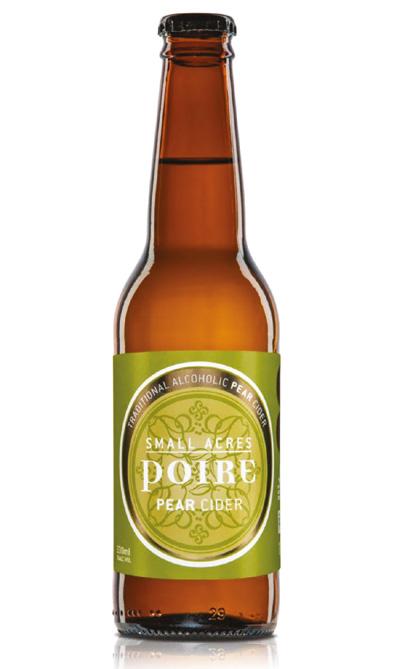
MARKETPLACE
77 MAY-JUNE 2024 THE FARMER

Ancient amphibians
Scientists have identified an ancient lizard-like species that lived in Australia around 247 million years ago.
Words MATILDA MEIKLE
The remains of this amphibian were first discovered in the 1990s by a retired chicken farmer in NSW. The farmer, Mihail Mihalids, was attempting to fix a broken garden wall with a 1.6 tonne slab of sandstone he bought from a local quarry. When he carved through the outer layer of the slab, he discovered the remains of an unidentified ancient species.
Mr Mihalids handed the fossil over to the Australian Museum in Sydney in 1997 and, to this day, less than 10 fossils of the same species have been discovered around the world.
FARMING FOSSILS
Below: A retired chicken farmer made a rare discovery when a block of sandstone from a local quarry ended up containing a rare fossil. A pretty clucky find!
The unknown fossil sat in a climate-controlled room for decades, until one day, something miraculous happened.
Lachlan Hart, a palaeontologist from UNSW Science and the Australian Museum, was studying the Triassic Era with his team when they were asked to identify the mysterious fossil. According to


Mr Hart, the specimen was a near-complete skeleton, even retaining some soft tissue.
“We don’t often find skeletons with the head and body still attached, and the soft tissue preservation is an even rarer occurrence,” explains Mr Hart.
Through extensive research, the team were able to determine that the amphibian was around 1.5 metres in length and shaped like a salamander. It is believed that the creature once lived in freshwater lakes and streams of modern-day Sydney.
“Superficially, Arenaerpeton looks a lot like the modern Chinese giant salamander, especially in the shape of its head,” Mr Hart says.
“However, from the size of the ribs and the soft tissue outline preserved on the fossil, we can see that it was considerably more heavyset than its living descendants. It also had some
pretty gnarly teeth, including a pair of fang-like tusks on the roof of its mouth.”
The species has been named Arenaepeton supinatus, which means “supine sand creeper” in Latin. It is believed to be part of the Temnospondyli family; a group of amphibians that survived two mass extinction events. According to the report of the study, published in the Journal of Vertebrate Paleontology, its uncanny survival may be due to the large size of the family or its ability to adapt to unfavourable climate conditions.
Mr Hart believes the amphibian likely fed on Cleithrolepis, another ancient fish species.
Overall, only three Temnospondyli fossils have been found in Australia, making the recent identification an important step in understanding the country’s fossil history. l
THE TAIL END
READ IT ONLINE
78 THE FARMER MAY-JUNE 2024

JOIN US
Help protect your livelihood. NSW Farmers is your voice – we are only as strong as you make us. The greater our numbers; the greater our voice.
Annual membership options
FULL PRODUCER MEMBER $438.90 For those who own or manage
1 VOTE PER MEMBERSHIP a farm. Includes our basic workplace relations package which provides:
· Collective representation on awards, minimum wage review, workers compensation.
· Wage information, including wage guides issued annually.
· Phone advice, four calls a year.


ESSENTIALS WORKPLACE RELATIONS PACKAGE Members can upgrade to this package to receive:
· Unlimited advice on employment matters.
· Assistance in negotiating with the Fair Work Ombudsman’s office.
· Representation in employment matters handled by tribunals, such as Fair Work Australia.
ADDITIONAL MEMBER $100
Linked to a full producer, with a 1 VOTE PER MEMBERSHIP proprietorial or income interest.
SECOND VOTE MEMBER $100
Linked to a full producer, most 1 VOTE PER MEMBERSHIP often a family member.
SMALL FARMS MEMBER $150
ASSOCIATE MEMBER
$100
COUNTRY CONNECTION
$100
RETIRED MEMBER $100
Have a small holding and do not receive majority of income from it.
Do not own a farm, e.g. teachers, agronomists, business people.
Supporters of farms from the city.
For retired farmers
NORTHERN Michael Collins, 0439 958 163, collinsm@nswfarmers.org.au
NORTH COAST & TABLELANDS Mark Bulley, 0429 330 348, bulleym@nswfarmers.org.au
TABLELANDS & SOUTH WEST SLOPES Catriona McAuliffe, 0488 100 005, mcauliffec@nswfarmers.org.au
MIA WEST RIVERINA & LACHLAN Frank Galluzzo, 0427 773 495, galluzzof@nswfarmers.org.au
EAST RIVERINA & SOUTH COAST Daniel Brear, 0487 248 731, breard@nswfarmers.org.au
WESTERN DIVISION & ORANA Caron Chester, 0400 116 207, chesterc@nswfarmers.org.au
HUNTER & SYDNEY BASIN Tanya Hayes, 0407 533 218, hayest@nswfarmers.org.au
MEMBERSHIP & COMMERCIAL Andrew Coughlan, 0477 393 092, coughlana@nswfarmers.org.au
· Assistance with drafting and reviewing employment-related correspondence, policies and procedures, and employment agreements.
The Essentials Workplace Relations package fees start from $165 for up to two employees. Extra charges may apply for assistance required within your first four months of membership. All prices include GST.
your

YES, I WOULD LIKE TO JOIN NSW FARMERS. I HAVE TICKED MY MEMBERSHIP CHOICE ABOVE. PLEASE CONTACT ME.

NAME:
(IF APPROPRIATE):
Memberships include The Farmer magazine delivere
to you.
Use
voice, become a member at nswfarmers.org.au or call 1300 794 000.
d
ADDRESS: EMAIL: PHONE: COMMODITY
FOR ALL GENERAL ENQUIRIES Contact the Member Service Centre on 1300 794 000 or your local regional services manager:
Value-adding, Viking style –Old techniques, Pushback from poultry farmers –The demand for mandatory code Premium lamb meat –The ‘Wagyu of lamb’ is taking off From convict to cultivator –James Ruse, Australia’s first farmer The poultry games
79 MAY-JUNE 2024 THE FARMER
















 MICHELLE HESPE Editor
MICHELLE HESPE Editor

























 CHEERS TO CHANGE
CHEERS TO CHANGE








































 NO FARMERS, NO FOOD
Above: Polish farmers block highways nationwide. Below: Protestors block roads around the EU headquarters in Brussels.
NO FARMERS, NO FOOD
Above: Polish farmers block highways nationwide. Below: Protestors block roads around the EU headquarters in Brussels.






































































































